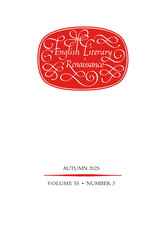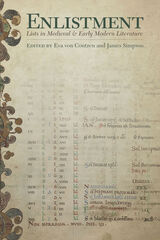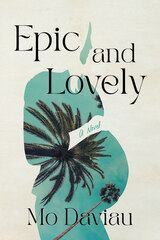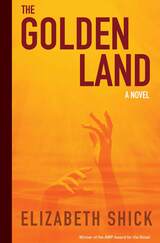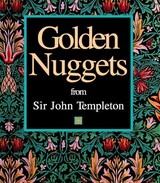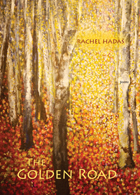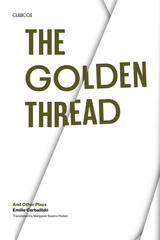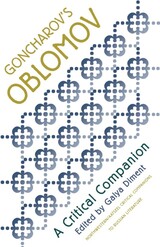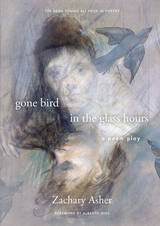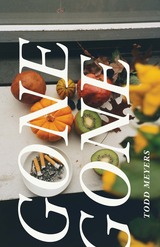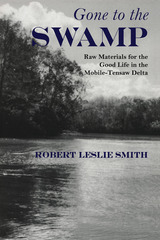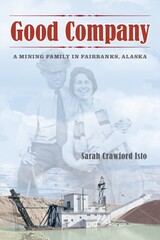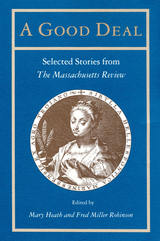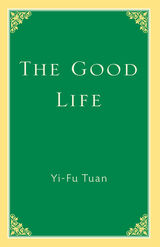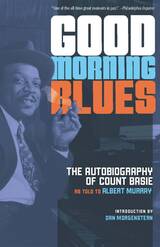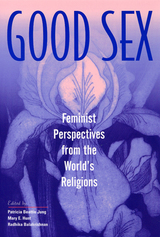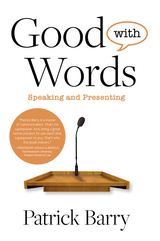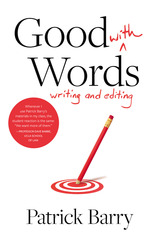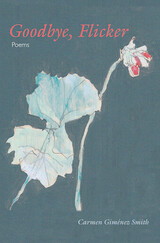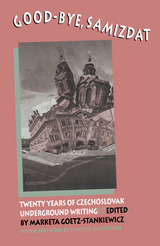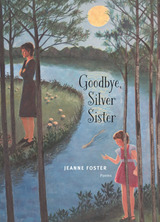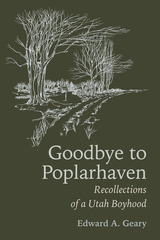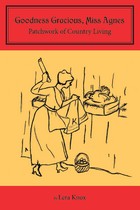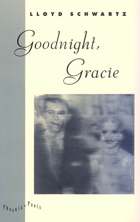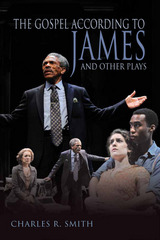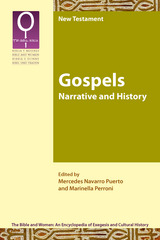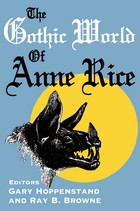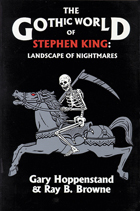The Golden Land
Elizabeth Shick
New Issues Poetry and Prose, 2022 Winner of the AWP Prize for the Novel, this debut novel digs deep into the complexities of family history and relationships.
When Etta's grandmother dies, she is compelled to travel to Myanmar to explore complicated adolescent memories of her grandmother's family and the violence she witnessed there. Full of rich detail and complex relationships, The Golden Land explores those personal narratives that might lie beneath the surface of historical accounts.
 The Golden Leaf: How Tobacco Shaped Cuba and the Atlantic World
Charlotte Cosner
Vanderbilt University Press, 2015 A Choice Reviews Editors' Pick
Through the rise and fall of empires, ideologies, and economies, tobacco grown on the tiny island of Cuba has remained an enduring symbol of pleasure and extravagance. Cultivated as one of the first reliable commodities for those inhabitants who remained after conquistadors moved on in search of a mythical wellspring of gold, tobacco quickly became crucial to the support of the swelling Spanish Empire in the seventeenth and eighteenth centuries. Eventually, however, tobacco became one of the final stabilizing forces in the empire, and it ultimately proved more resilient than the best laid plans of kings and queens. Tobacco, and those whose livelihoods depended on it, shrugged off the Empire's collapse and pressed on into the twentieth century as an economic force any state or political power must reckon with.
Cosner explores the history of this golden leaf through the personal narratives of farmers, bureaucrats, and laborers, all struggling to build an independent and lucrative economic engine. Through conquest, rebellion, colonial and imperial schemes, and the eventual Communist revolution, Cuban tobacco and cigars became a luxury item that commanded loyalty that defied mere borders or embargoes. Ultimately, The Golden Leaf is a story of two carefully cultivated products: Cuban tobacco, and its lofty reputation.
The Golden Mountain: The Autobiography of a Korean Immigrant, 1895-1960
Easurk Emsen Charr
University of Illinois Press, 1996 At the age of ten and without his parents, Easurk Charr, a convert to Christianity, came to Hawa'ii in 1904 to earn enough money to acquire an education and return to his native Korea as a medical missionary. The Golden Mountain is Charr's story of his early years in Korea, his migration to Hawai'i and the American mainland, and the joys and pain of his life as one of some seven thousand Koreans who migrated to the United States between 1903 and 1905. First published in 1961, Charr's memoir offers touching insights into the experience of early Korean immigrants. He tells eloquently of how difficult it was for him to become a naturalized citizen, even after serving in the U.S. Army. An introduction by Wayne Patterson provides a broader perspective on both Charr and the Korean immigrant experience.
Golden Nuggets: from Sir John Templeton
John Marks Templeton
Templeton Press, 1998 For young or old, rich or poor, this wisdom will find many applications in people's lives. This inspiring collection of time wisdom by Sir John Templeton, presented in a beautiful gift book, is perfect for a person seeking deeper meaning in life. Practical and uplifting advice based on a lifetime of experience is gathered in an attractive package for personal use or as a perfect gift. Juxtaposed to his sayings are short essays that elaborate on the ideas and make them easier to understand and apply. Themes, such as thanksgiving, forgiveness, positive thinking, love, humility, and happiness, arrange the thoughts.
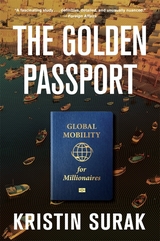 The Golden Passport: Global Mobility for Millionaires
Kristin Surak
Harvard University Press, 2023 "[A] fascinating study of how people―and their capital―seek to move around a world that is at once hugely interconnected and driven by inequities…definitive, detailed, and unusually nuanced.”
―Atossa Araxia Abrahamian, Foreign Affairs
The first comprehensive on-the-ground investigation of the global market for citizenship, examining the wealthy elites who buy passports, the states and brokers who sell them, and the normalization of a once shadowy practice.
Our lives are in countless ways defined by our citizenship. The country we belong to affects our rights, our travel possibilities, and ultimately our chances in life. Obtaining a new citizenship is rarely easy. But for those with the means—billionaires like Peter Thiel and Jho Low, but also countless unknown multimillionaires—it’s just a question of price.
More than a dozen countries, many of them small islands in the Mediterranean, Caribbean, and South Pacific, sell citizenship to 50,000 people annually. Through six years of fieldwork on four continents, Kristin Surak discovered how the initially dubious sale of passports has transformed into a full-blown citizenship industry that thrives on global inequalities. Some “investor citizens” hope to parlay their new passport into visa-free travel—or use it as a stepping stone to residence in countries like the United States. Other buyers take out a new citizenship as an insurance policy or to escape state control at home. Almost none, though, intend to move to their selected country and live among their new compatriots, whose relationship with these global elites is complex.
A groundbreaking study of a contentious practice that has become popular among the nouveaux riches, The Golden Passport takes readers from the details of the application process to the geopolitical hydraulics of the citizenship industry. It’s a business that thrives on uncertainty and imbalances of power between big, globalized economies and tiny states desperate for investment. In between are the fascinating stories of buyers, brokers, and sellers, all ready to profit from the citizenship trade.
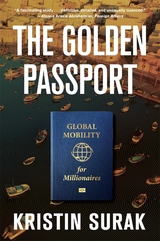 The Golden Passport: Global Mobility for Millionaires
Kristin Surak
Harvard University Press The first comprehensive on-the-ground investigation of the global market for citizenship, examining the wealthy elites who buy passports, the states and brokers who sell them, and the normalization of a once shadowy practice.
Our lives are in countless ways defined by our citizenship. It is no wonder that obtaining citizenship is seldom easy—unless you have unusual means. For millionaires and billionaires like Peter Thiel and Jho Low, a new passport is just a question of price.
More than a dozen countries, many of them small islands in the Mediterranean, Caribbean, and South Pacific, sell citizenship to 50,000 people annually. Kristin Surak investigated the industry. Some “investor citizens” parlay their new passport into visa-free travel or use it as a stepping stone to residence in a third country like the United States. Other buyers seek an insurance policy against their home states. Almost none intend to live among their new compatriots, who have a complex relationship with these global elites.
A groundbreaking study of a contentious practice that has become popular among the nouveaux riches, The Golden Passport takes readers through the geopolitical hydraulics of a business that thrives on imbalances of power between big, globalized economies and tiny states desperate for investment. In between are the fascinating stories of buyers, brokers, and sellers, all poised to profit.
The Golden Road: Poems
Rachel Hadas
Northwestern University Press, 2012 A central theme of The Golden Road is the prolonged dementia of the poet’s husband. But Rachel Hadas’s new collection sets the loneliness of progressive loss in the context of the continuities that sustain her: reading, writing, and memory; familiar places; and the rich texture of a life fully lived. These poems are meticulously observed, nimble in their deployment of a range of forms, and capacious in their range of reference. They take us to a Greek island, to Carl Schurz Park in New York City, to an old house in Vermont, to a performance of Macbeth, and to the neurology floor of a hospital. Hadas finds beauty in all those places. The Golden Road laments, but it also celebrates.
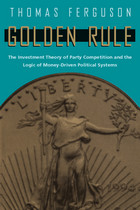 Golden Rule: The Investment Theory of Party Competition and the Logic of Money-Driven Political Systems
Thomas Ferguson
University of Chicago Press, 1995 "To discover who rules, follow the gold." This is the argument of Golden Rule, a provocative, pungent history of modern American politics. Although the role big money plays in defining political outcomes has long been obvious to ordinary Americans, most pundits and scholars have virtually dismissed this assumption. Even in light of skyrocketing campaign costs, the belief that major financial interests primarily determine who parties nominate and where they stand on the issues—that, in effect, Democrats and Republicans are merely the left and right wings of the "Property Party"—has been ignored by most political scientists. Offering evidence ranging from the nineteenth century to the 1994 mid-term elections, Golden Rule shows that voters are "right on the money."
Thomas Ferguson breaks completely with traditional voter centered accounts of party politics. In its place he outlines an "investment approach," in which powerful investors, not unorganized voters, dominate campaigns and elections. Because businesses "invest" in political parties and their candidates, changes in industrial structures—between large firms and sectors—can alter the agenda of party politics and the shape of public policy.
Golden Rule presents revised versions of widely read essays in which Ferguson advanced and tested his theory, including his seminal study of the role played by capital intensive multinationals and international financiers in the New Deal. The chapter "Studies in Money Driven Politics" brings this aspect of American politics into better focus, along with other studies of Federal Reserve policy making and campaign finance in the 1936 election. Ferguson analyzes how a changing world economy and other social developments broke up the New Deal system in our own time, through careful studies of the 1988 and 1992 elections. The essay on 1992 contains an extended analysis of the emergence of the Clinton coalition and Ross Perot's dramatic independent insurgency. A postscript on the 1994 elections demonstrates the controlling impact of money on several key campaigns.
This controversial work by a theorist of money and politics in the U.S. relates to issues in campaign finance reform, PACs, policymaking, public financing, and how today's elections work.
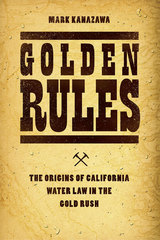 Golden Rules: The Origins of California Water Law in the Gold Rush
Mark Kanazawa
University of Chicago Press, 2015 Fresh water has become scarce and will become even more so in the coming years, as continued population growth places ever greater demands on the supply of fresh water. At the same time, options for increasing that supply look to be ever more limited. No longer can we rely on technological solutions to meet growing demand. What we need is better management of the available water supply to ensure it goes further toward meeting basic human needs. But better management requires that we both understand the history underlying our current water regulation regime and think seriously about what changes to the law could be beneficial.
For Golden Rules, Mark Kanazawa draws on previously untapped historical sources to trace the emergence of the current framework for resolving water-rights issues to California in the 1850s, when Gold Rush miners flooded the newly formed state. The need to circumscribe water use on private property in support of broader societal objectives brought to light a number of fundamental issues about how water rights ought to be defined and enforced through a system of laws. Many of these issues reverberate in today’s contentious debates about the relative merits of government and market regulation. By understanding how these laws developed across California’s mining camps and common-law courts, we can also gain a better sense of the challenges associated with adopting new property-rights regimes in the twenty-first century.
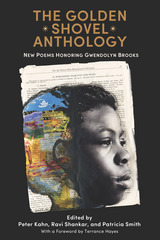 The Golden Shovel Anthology: New Poems Honoring Gwendolyn Brooks
Peter Kahn
University of Arkansas Press, 2017
“Throughout this anthology, more than 60 other well-known Brooks poems can be read the same way, with lines from ‘The Mother’ and ‘The Bean Eaters’ tripping down the right-hand side of the page. The anthology ends with ‘Non-Brooks Golden Shovels’ and ‘Variations and Expansions on the Form.’ The cross-section of poets with varying poetics and styles gathered here is only one of the many admirable achievements of this volume.”
—Claudia Rankine, The New York Times, August 2017
“The editors, including tireless poetry advocate Kahn, of this unique, new addition to the Gwendolyn Brooks legacy put together a richly diverse set of poets working with the most unusual and fertile new poetic form created in recent years. National Book Award winner Terrance Hayes invented the Golden Shovel, which he illuminates in his stirring foreword, writing, “Because where do poems come from if not other poems?” In a Golden Shovel poem, the last words in each line are taken from a Brooks poem. A veritable who’s who of contemporary poets tried their hands at this encoded homage, including Billy Collins, Mark Doty, Rita Dove, Nikki Giovanni, Joy Harjo, Billy Lombardo, Sharon Olds, Alberto Ríos, Tracy K. Smith, and Timothy Yu. Beautifully introduced by Patricia Smith, this is a beguiling and mind-expanding anthology shaped by formal expertise and deep appreciation for the complexity and resonance of Brooks’ work and profoundly nurturing influence. In all, a substantial and dynamic contribution to American literature.”
—Booklist, May 2017
"Gwendolyn Brooks was the first black writer to receive the Pulitzer Prize for poetry back in 1950. A new book honors her work in using a form called the golden shovel, developed by poet Terrance Hayes. In The Golden Shovel Anthology, poets select a line from a poem of Brooks’s and use it as the closing line or lines in a poem of their own. The result is an expansive and extraordinary assemblage edited by poets Peter Kahn, Ravi Shankar, and Patricia Smith.”
—Nina MacLaughlin, Boston Globe, March 2017
The Golden Shovel Anthology celebrates the life and work of poet and civil rights icon Gwendolyn Brooks through a dynamic new poetic form, the Golden Shovel, created by National Book Award–winner Terrance Hayes.
The last words of each line in a Golden Shovel poem are, in order, words from a line or lines taken from a Brooks poem. The poems are, in a way, secretly encoded to enable both a horizontal reading of the new poem and vertical reading down the right-hand margin of Brooks’s original. An array of writers—including Pulitzer Prize winners, T. S. Eliot Prize winners, National Book Award winners, and National Poet Laureates—have written poems for this exciting new anthology: Rita Dove, Billy Collins, Nikki Giovani, Sharon Olds, Tracy K. Smith, Mark Doty, Sharon Draper, and Julia Glass are just a few of the contributing poets.
The poems found here will inspire a diversity of readers, teachers, and writers of poetry while at the same time providing remarkable access for newcomers, making it ideal for classrooms. The Golden Shovel Anthology will also honor Brooks with publication in 2017, the centenary of her birth.
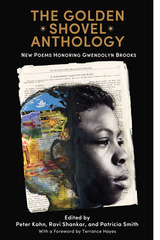 The Golden Shovel Anthology: New Poems Honoring Gwendolyn Brooks
Peter Kahn
University of Arkansas Press, 2019 “The cross-section of poets with varying poetics and styles gathered here is only one of the many admirable achievements of this volume.”
—Claudia Rankine in the New York Times
The Golden Shovel Anthology celebrates the life and work of poet and civil rights icon Gwendolyn Brooks through a dynamic new poetic form, the Golden Shovel, created by National Book Award–winner Terrance Hayes.
An array of writers—including winners of the Pulitzer Prize, the T. S. Eliot Prize, and the National Book Award, as well as a couple of National Poets Laureate—have written poems for this exciting new anthology: Rita Dove, Billy Collins, Danez Smith, Nikki Giovanni, Sharon Olds, Tracy K. Smith, Mark Doty, Sharon Draper, Richard Powers, and Julia Glass are just a few of the contributing poets.
This second edition includes Golden Shovel poems by two winners and six runners-up from an international student poetry competition judged by Nora Brooks Blakely, Gwendolyn Brooks’s daughter. The poems by these eight talented high school students add to Ms. Brooks’s legacy and contribute to the depth and breadth of this anthology.
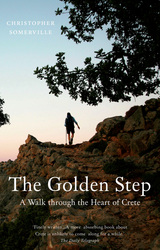 The Golden Step: A Walk Through the Heart of Crete
Christopher Somerville
Haus Publishing, 2012 For Somerville this was a kind of pilgrimage, a journey unlike any he had undertaken in 20 years of travel-writing. It was an expedition where he traded the usual comforts and certainties for a real physical and mental challenge, with no mobile phone or other technological aids. The only plan for his journey was to begin in the East at Easter and finish at Whitsun in the extreme West, at the Monastery of the Golden Step, whose gold step, legend says, can only be seen by those who have purged themselves into purity. During his 300-mile walk, he tackled four mountain ranges, high slopes and the numerous gorges of the West. Speaking only basic Greek and trying to follow a poorly way-marked path, he had to rely on his own instincts when climbing mountain passes and crossing high plateaux, farming and shepherding country, where villages are scarce and each night's accommodation was uncertain. He saw a Crete few ever encounter.
The Golden Thread and other Plays
By Emilio Carballido
University of Texas Press, 1970 Emilio Carballido was one of the most innovative and accomplished of Mexico's playwrights and one of the outstanding creators in the new Latin American theater. By his mid-forties he had already produced an impressive body of works in two very different veins. On the one hand, he mastered the techniques of the "well-made play." On the other, he developed a richly rewarding vein of fantasy, sometimes poetic, sometimes comic, sometimes macabre—and sometimes all three. The plays in this volume are in the latter vein, ranging from surrealist farce in "The Intermediate Zone" to the grotesqueries of "The Time and the Place," from tragicomedy in "Theseus" to the dreamlike permutations of "The Golden Thread." But even at his most fantastic, Carballido never loses his remarkable gift for characterization: his peevish Minotaur, his raffish Nahual (were-jaguar) are wholly believable monsters.
Golden Treasures of the San Juan
Temple H. Cornelius
Ohio University Press, 1961 Golden Treasures of the San Juan contains fabulous stories of lost mines, bullion, and valuable prospects of one of the most beautiful mountain areas of the United States. Many of the stories are based on the personal adventures of author Cornelius. When the Indian Mountain Lands (the San Juan) were ceded in 1874, the wild region was thrown open to prospectors seeking its gold and silver riches. Many prospects were valuable discoveries, yet were lost and became legendary mines. Further, the Spanish explorers had been through this area much earlier with their bullion, and their caches added to the legends of gold discovered or to be discovered. The authors of this book trace complete stories about these long-lost hoards.
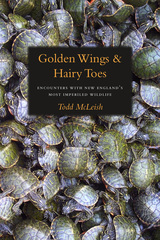 Golden Wings & Hairy Toes: Encounters with New England’s Most Imperiled Wildlife
Todd McLeish
University Press of New England, 2009 This book profiles fourteen of New England’s most rare and endangered flora and fauna—mammals, birds, insects, plants, and fish—by following the biologists who are researching, monitoring, and protecting them. Each chapter includes a first-person account of the author’s experience with these experts, as well as details about the species’ life history, threats, and conservation strategies. McLeish traps bats in Vermont and lynx in Maine, gets attacked by marauding birds in Massachusetts, and observes the metamorphosis of dragonflies in Rhode Island. He visits historical cemeteries to see New England’s rarest plant, tracks sturgeon in the Connecticut River, and observes a parade of what may be the rarest mammal on earth, the North Atlantic right whale, in Cape Cod Bay. The book’s title comes from the name of one of the birds in the book, the golden-winged warbler, and the unusual characteristic used to distinguish the rare Indiana bat from its common cousins, its hairy toes. McLeish, a longtime wildlife advocate and essayist, has a gift for communicating scientific information in an interesting and accessible way. His goal in this book—to make an emotional connection to a variety of fascinating animals and plants—is successfully conveyed to the reader, who comes away amazed by the complexity of individual species and the ecosystems necessary for their survival. Sometimes there are surprises: how lynx benefit from the clear cutting of forests or how utility companies —often blamed for environmental degradation—have accidentally succeeded in creating excellent habitat for golden-winged warblers along their power line corridors. Such examples support McLeish’s assertion that we can meet the immense challenges to species preservation, such as global warming, acid rain, and mercury poisoning, as well as the difficulty of adding new species to the 1973 Endangered Species Act. As McLeish’s book shows, each rare species has an important story to tell about the causes of its population decline, the obstacles each face in rebuilding a sustainable population, and the people who go to extraordinary lengths to give these species a chance to thrive.
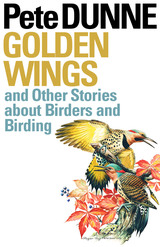 Golden Wings and Other Stories about Birders and Birding
By Pete Dunne
University of Texas Press, 2003 Dubbed the "Bard of America's Bird-Watchers" by the Wall Street Journal, Pete Dunne knows birders and birding—instinctively and completely. He understands the compulsion that drives other birders to go out at first light, whatever the weather, for a chance to maybe, just maybe, glimpse that rare migrant that someone might have spotted in a patch of woods the day before yesterday. And yet, he also knows how . . . well . . . strange the birding obsession becomes when viewed through the eyes of a nonbirder. His dual perspective—totally engrossed in birding, yet still aware of the "odd birdness" of some birders—makes reading his essays a pure pleasure whether you pursue "the feather quest" or not. This book collects forty-one of Dunne's recent essays, drawn from his columns in Living Bird, Wild Bird News, the New Jersey Sunday section of the New York Times, Birder's World, and other publications. Written with his signature wit and insight, they cover everything from a moment of awed communion with a Wandering Albatross ("the most beautiful thing I'd ever seen") to Dunne's imagined "perfect bird" ("The Perfect Bird is the size of a turkey, has the wingspan of an eagle, the legs of a crane, the feet of a moorhen, and the talons of a great horned owl. It eats kudzu, surplus zucchini, feral cats, and has been known to predate upon homeowners who fire up their lawn mowers before 7:00 A.M. on the weekend."). The title essay pays whimsical, yet heartfelt tribute to Dunne's mentor, the late birding legend Roger Tory Peterson.
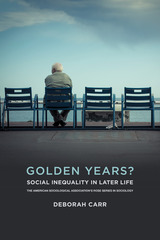 Golden Years?: Social Inequality in Later Life
Deborah Carr
Russell Sage Foundation, 2019 Thanks to advances in technology, medicine, Social Security, and Medicare, old age for many Americans is characterized by comfortable retirement, good health, and fulfilling relationships. But there are also millions of people over 65 who struggle with poverty, chronic illness, unsafe housing, social isolation, and mistreatment by their caretakers. What accounts for these disparities among older adults? Sociologist Deborah Carr’s Golden Years? draws insights from multiple disciplines to illuminate the complex ways that socioeconomic status, race, and gender shape the nearly every aspect of older adults’ lives. By focusing on an often-invisible group of vulnerable elders, Golden Years? reveals that disadvantages accumulate across the life course and can diminish the well-being of many.
Carr connects research in sociology, psychology, epidemiology, gerontology, and other fields to explore the well-being of older adults. On many indicators of physical health, such as propensity for heart disease or cancer, black seniors fare worse than whites due to lifetimes of exposure to stressors such as economic hardships and racial discrimination and diminished access to health care. In terms of mental health, Carr finds that older women are at higher risk of depression and anxiety than men, yet older men are especially vulnerable to suicide, a result of complex factors including the rigid masculinity expectations placed on this generation of men. Carr finds that older adults’ physical and mental health are also closely associated with their social networks and the neighborhoods in which they live. Even though strong relationships with spouses, families, and friends can moderate some of the health declines associated with aging, women—and especially women of color—are more likely than men to live alone and often cannot afford home health care services, a combination that can be isolating and even fatal. Finally, social inequalities affect the process of dying itself, with white and affluent seniors in a better position to convey their end-of-life preferences and use hospice or palliative care than their disadvantaged peers.
Carr cautions that rising economic inequality, the lingering impact of the Great Recession, and escalating rates of obesity and opioid addiction, among other factors, may contribute to even greater disparities between the haves and the have-nots in future cohorts of older adults. She concludes that policies, such as income supplements for the poorest older adults, expanded paid family leave, and universal health care could ameliorate or even reverse some disparities.
A comprehensive analysis of the causes and consequences of later-life inequalities, Golden Years? demonstrates the importance of increased awareness, strong public initiatives, and creative community-based programs in ensuring that all Americans have an opportunity to age well.
 The Goldsmith's Debt: Conceptions of Property in Early Modern Art
Shira Brisman
University of Chicago Press, 2026 Reveals how art shaped the economy, social order, and legal claims during the rise of capitalism.
In the sixteenth century, German goldsmiths played a unique role in articulating property claims and social values. These artisans shaped precious metals into visible expressions of domination, subordination, and obligation. The objects they crafted played a major role in the practices of exchange and inheritance that were reconfiguring a tumultuous economic landscape. Cities commissioned goldsmiths to transform revenue into goblets that could be given as diplomatic gifts or reconverted into currency in times of war, and courts used serving implements as promises of credit.
With The Goldsmith’s Debt, art historian Shira Brisman offers the first book-length study of the Nuremberg goldsmith Christoph Jamnitzer (1563–1618), who created elaborate gilded silver drinking cups that he crafted into unexpected forms, with designs ranging from racialized heads to mining scenes. Considering how works of art can shape a social order, Brisman explores what Jamnitzer’s etchings and goblets reveal about how goldsmiths shared ideas and how their patrons used commissioned works to legitimize their claims over land and the rights of others. Drawing on a range of textual and material evidence—including commentaries on Roman and customary laws, wills and civic statutes, printed designs, and firsthand study of lidded cups in dozens of major European institutions—this unprecedented study places the goldsmith at the heart of the era’s arguments about how people and lands should be subjugated. Brisman reveals the insidious side of these objects that were often used to advance socially conservative agendas, and she presents radical proposals for addressing inequity in the world of ornament prints.
 Golf and the American Country Club
Richard J. Moss
University of Illinois Press, 2001 Often seen as anti-egalitarian and elitist, the country club has provoked strong responses since its initial appearance in the late 1800s. Golf, another elitist identifier, was commonly dismissed as a pseudo-sport or even unmanly. Where and how had the country club and the game of golf taken root in the United States? How had the manicured order of the golf course become a cultural site that elicited both strong loyalties and harsh criticism? Richard J. Moss's cultural history explores the establishment of the country club as an American social institution and its inextricable connection to the ancient, imported game of golf. Moss traces the evolution of country clubs from informal groups of golf-playing friends to “country estates” in the suburbs and, eventually, into public and private daily fee courses, corporate country clubs, and gated golfing communities. As he shows, the development of these institutions reveals profound shifts in social dynamics, core American values, and attitudes toward health and sport.
 Golf in America
George B. Kirsch
University of Illinois Press, 2008 In this concise social history of golf in the United States from the 1880s to the present, George B. Kirsch tracks the surprising growth of golf as a popular, mainstream sport, in contrast to the stereotype of golf as a pastime enjoyed only by the rich elite. In addition to classic heroes such as Francis Ouiment, Gene Sarazen, Sam Snead, and Ben Hogan, the annals of golf's early history also include African American players--John Shippen Jr., Ted Rhodes, and Charlie Sifford--as well as both white and black female players such as Mildred "Babe" Didrikson Zaharias, Louise Suggs, Betsy Rawls, Ann Gregory, and former tennis champ Althea Gibson. Golf in America tells the stories of these and many other players from different social classes, ethnic backgrounds, races, and genders. Examining golf's recent history, Golf in America looks at the impact of television and the rivalry between Arnold Palmer and Jack Nicklaus, both of whom in 1996 were impressed by an upstart named Eldrick "Tiger" Woods. Kirsch also highlights the history of public golf courses in the United States, from Van Cortlandt Park in the Bronx to Boston's Franklin Park, Chicago's Jackson Park, and other municipal and semiprivate courses that have gone relatively unnoticed in the sport's history. Illustrated with nearly two dozen photographs, this book shows that golf in America has always reflected a democratic spirit, evolving into a sport that now rivals baseball for the honor of being acclaimed "America's national pastime."
 Golf Science: Optimum Performance from Tee to Green
Edited by Mark F. Smith
University of Chicago Press, 2013 Golf is perhaps the most complicated simple game ever invented. Golfing greats like Jack Nicklaus and Tiger Woods make the sport look easy, but anyone who has ever picked up a club knows how truly frustrating golf can be. The success of each shot depends on a diverse range of factors, from the club you choose and the speed with which you swing it, to your mood, the weather, and even the type and cut of the grass. Science plays a crucial role in most, if not all, of these factors, and in Golf Science, sports science expert Mark F. Smith investigates the cutting-edge scientific wonders that take the ball from tee to hole. Each chapter explores a different facet of the game—mind and body, the swing, the equipment, the environment, coaching with technology, the practice process, and the score—and is organized around a series of questions. What happens in the brain during the preshot routine? Does head movement hinder swing performance? Will I hit the ball farther with a longer driver? Why do I lose distance into the wind? What can I learn from watching my ball in flight? How should practice be structured? What are the key stats in golf that I need to know? Each question is examined with the aid of explanatory diagrams and illustrations, and the book can be used to search for particular topics, or read straight through for a comprehensive overview of how golfer and equipment work together. A must-have for anyone who delights in the spirit of the game, Golf Science will be enjoyed not only by professionals and coaches but also by spectators of the PGA Tour and anyone who enjoys a round of eighteen holes on the weekend.
 Golk
Richard Stern
University of Chicago Press, 1987 In midcentury America, the golden age of television, a man named Golk is wreaking havoc with the medium. Through a devastating series of exposures—"You're on Camera"—Golk manipulates the high and mighty, the lowdown and dirty, and the outrageous weird; all are within the compass of Richard Stern in this early novel, a comedy with as many inspired maneuvers as its rambunctious protagonist has for taking the measure of a profligate world.
"Golk is a rich and marvelously detailed novel by a man with a cultivated intelligence; it is also the first really good book I have read about television."—Norman Mailer
"An original: sharp, funny, intelligent, rare. . . . Working in a clean, oblique style reminiscent of Nathanael West, Mr. Stern has written in Golk a first-rate comic novel, a piece of fiction that is at once about and loaded with that kind of recognition that junkies call the flash."—Joan Didion, National Review
"Golk is fantastic, funny, bitter, intelligent without weariness. Best of all Golk is pure—that is to say necessary. Without hokum."—Saul Bellow
"Golk (like Golk himself) is a wonderous conception. Its world responds to personification, not analysis, and personify it Mr. Stern has done. A book in a thousand."—Hugh Kenner
"What I like about Mr. Stern's fantasy is that it has been conceived and written with so much gaiety. Far from a political melodrama, it reminds me of a René Clair movie, and even the surrealist touches needed to bring out the power and pretense of the television industry are funny rather than symbolically grim."—Alfred Kazin, Reporter
"A mighty good book, altogether alive, full of beans and none of them spilled."—Flannery O'Connor
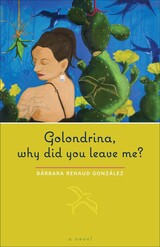 Golondrina, why did you leave me?: A Novel
By Bárbara Renaud González
University of Texas Press, 2009 Runner-up, Best Popular Fiction in English, Latino Book Awards Competition, 2010 The golondrina is a small and undistinguished swallow. But in Spanish, the word has evoked a thousand poems and songs dedicated to the migrant's departure and hoped-for return. As such, the migrant becomes like the swallow, a dream-seeker whose real home is nowhere, everywhere, and especially in the heart of the person left behind. The swallow in this story is Amada García, a young Mexican woman in a brutal marriage, who makes a heart-wrenching decision—to leave her young daughter behind in Mexico as she escapes to el Norte searching for love, which she believes must reside in the country of freedom. However, she falls in love with the man who brings her to the Texas border, and the memories of those three passionate days forever sustain and define her journey in Texas. She meets and marries Lázaro Mistral, who is on his own journey—to reclaim the land his family lost after the U.S.-Mexican War. Their opposing narratives about love and war become the legacy of their first-born daughter, Lucero, who must reconcile their stories into her struggle to find "home," as her mother, Amada, finally discovers the country where love beats its infinite wings. Bárbara Renaud González, a native-born Tejana and acclaimed journalist, has written a lyrical story of land, love, and loss, bringing us the first novel of a working-class Tejano family set in the cruelest beauty of the Texas panhandle. Her story exposes the brutality, tragedy, and hope of her homeland and helps to fill a dearth of scholarly and literary works on Mexican and Mexican American women in post–World War II Texas.
Goncharov's "Oblomov": A Critical Companion
Gayla Diment
Northwestern University Press, 1998 No other novel has been used to describe the "Russian mentality" or "Russian soul" as frequently as Ivan Goncharov's Oblomov, first published in 1859. This guide will enable readers to appreciate fully the remarkable talent of the writer and his masterpiece.
All the essays were written specifically for this volume and are published here for the first time. The book also includes an introduction, autobiographical materials, an annotated bibliography, and letters never before translated into English.
Contributors: Galya Diment, John Givens, Beth Holmgren, Karl D. Kramer, Ronald D. LeBlanc, Alexandar Mihailovic, and Brian Thomas Oles.
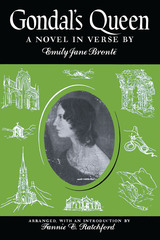 Gondal's Queen: A Novel in Verse
By Emily Jane Brontë
University of Texas Press, 1955 In Gondal’s Queen, Fannie Elizabeth Ratchford presents a cycle of eighty-four poems by Emily Jane Brontë, for the first time arranged in logical sequence, to re-create the “novel in verse” which Emily wrote about their beloved mystical kingdom of Gondal and its ruler, Augusta Geraldine Almeda, who brought tragedy to those who loved her. Thanks to previous publications by Ratchford, the imaginative world of Gondal is well known not only to Brontë scholars but also to general readers. Only in the present book, however, with Emily’s lovely poems restored to the setting which gave them being, can the full impact of this extraordinary literary creation be realized. The life story of Gondal’s Queen, from portentous birth to tragic death, is set in a world compounded of dark Gothic romance and Byronic extravagance; yet out of it emerges not only a real country of wild moor sheep and piercingly beautiful nights but also the portrait of a real woman, whose doom was wrought not by the stars but by the clashing complications of her own nature. In A.G.A. (the appellation most usually applied to the Queen), Emily Brontë created a personality, not a puppet reciting lovely lines. And Ratchford, in reconstructing her story, has re-affirmed the dignity, beauty, and richness of Emily’s poetry. Gondal’s Queen is the end of a long trail of research and literary detection which has led Ratchford to all known Brontë documentary sources. This quest was originally stimulated by curiosity over a tiny booklet signed, “C. Brontë, June 29th, 1837,” in the Wrenn Library at the University of Texas at Austin. Ratchford’s intense and astonishingly fruitful interest in the Brontës had its origin in her attempt to unravel the fascinating puzzle presented by this little book, which seemed to be merely a series of childish vignettes held together by “a shadow of a common character” and a “tendency toward a unified plot.” Bit by bit, Ratchford assembled clues from manuscripts and obscure publications until the significance of the play world of the Brontë children began to emerge. In spite of the fact that the Brontës had been the subject of the liveliest literary speculation since their deaths, it remained for Ratchford to establish the importance of their juvenile writings to the later writings of Charlotte. In successive publications she presented the accumulating evidence. For a time her curiosity was centered on Charlotte and the group, but it finally became focused on Emily through a manuscript journal fragment which fortunately came to hand. Unlike Charlotte, Emily left no prose works from her childhood. But it is apparent from journal entries and birthday notes written by Emily and Anne (whose shared creation Gondal was) not only that the two younger Brontës lived in and sustained daily an imaginary world which had evolved from the earlier play of the four children together, but also that they had written separately voluminous histories and “novels” about it. Of Emily’s vast Gondal literature, only a small body of verse has survived, poems originally intended for no eye but her own and possibly Anne’s. But it is clear that Gondal was not only Emily Brontë’s childhood dream world but also the major preoccupation of her adult creative life.
Gone Again Ptarmigan
Jonathan London
University of Alaska Press, 2013 Every winter, willow ptarmigan birds put on new feathery coats, softly white and perfect for hiding in snow. In the spring they take on a spotted brown more suited to nesting. This is just one of the captivating changes that take place in the Far North as animals adjust to the changing seasons. Gone Again Ptarmigan allows readers to be wilderness explorers. Following the course of a year, readers learn how the birds change their plumage, forage, and evade predators, crossing paths with many of the other creatures sharing their land. With lively acrylic illustrations and an author’s note at the end to extend learning, Gone Again Ptarmigan is a beautiful introduction to the adaptable animals of the wild North.
gone bird in the glass hours: a poem play
Zachary Asher
University of Utah Press, 2020 Winner of the 2019 Agha Shahid Ali Prize in Poetry
Zachary Asher’s second collection, gone bird in the glass hours, is a play in verse, featuring seven voices. It begins with a rabbi, bewildered and bent by personal grief, guided and beguiled by elusive Blue Postman into the world of “the glass hours” and its inhabitants.
Rooted in magical realism, gone bird in the glass hours experiments with multiple forms from epistles to centos, from fractals to prayers. These poems are brave in their excavations of grief and solace, wonder and rage, collective trauma and, ultimately, transcendence.
 Gone But Not Forgotten: My Favourite Flops and Other Projects that Came to Nothing
Hans Magnus Enzensberger
Seagull Books, 2022 One of Germany’s greatest living writers offers up an analysis (and samples) of his failed projects.
“My dear fellow artists, whether writers, actors, painters, film-makers, singers, sculptors, or composers, why are you so reluctant to talk about your minor or major failures?” With that question, Hans Magnus Enzensberger—the most senior among Germany’s great writers—begins his amusing ruminations on his favorite projects that never saw the light of day. There is enlightenment in every embarrassing episode, he argues, and while artists tend to forget their successes quickly, the memory of a project that came to nothing stays in the mind for years, if not decades. Triumphs hold no lessons for us, but fiascos can extend our understanding, giving insight into the conditions of production, conventions, and practices of the industries concerned, and helping novices to assess the snares and minefields in the industry of their choice. What’s more, Enzensberger argues, flops have a therapeutic effect: They can cure, or at least alleviate, the vocational illnesses of authors, be it the loss of control or megalomania. In Gone but Not Forgotten, Enzensberger looks back at his uncompleted experiments not just in the world of books but also in cinema, theater, opera, and journal publishing, and shares with us a “store of ideas” teeming with sketches of still-possible projects. He also reflects on the likely reasons for these big and small defeats. Interspersed among his ruminations are excerpts from those experiments, giving readers a taste of what we missed. Together, the pieces in this volume build a remarkable picture of a versatile genius’s range of work over more than half a century and make us reflect on the very nature of success and failure by which we measure our lives.
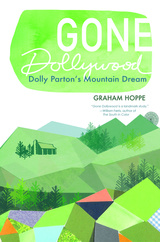 Gone Dollywood: Dolly Parton’s Mountain Dream
Graham Hoppe
Ohio University Press, 2018 Dolly Parton isn’t just a country music superstar. She has built an empire. At the heart of that empire is Dollywood, a 150-acre fantasy land that hosts three million people a year. Parton’s prodigious talent and incredible celebrity have allowed her to turn her hometown into one of the most popular tourist destinations in America. The crux of Dollywood’s allure is its precisely calibrated Appalachian image, itself drawn from Parton’s very real hardscrabble childhood in the mountains of east Tennessee. What does Dollywood have to offer besides entertainment? What do we find if we take this remarkable place seriously? How does it both confirm and subvert outsiders’ expectations of Appalachia? What does it tell us about the modern South, and in turn what does that tell us about America at large? How is regional identity molded in service of commerce, and what is the interplay of race, gender, and class when that happens? In Gone Dollywood, Graham Hoppe blends tourism studies, celebrity studies, cultural analysis, folklore, and the acute observations and personal reflections of longform journalism into an unforgettable interrogation of Southern and American identity.
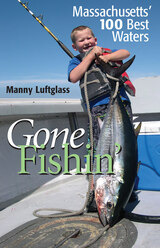 Gone Fishin’: Massachusetts’ 100 Best Waters
Manny Luftglass
University Press of New England, 2008 From catching rainbows, browns, and brookies in the streams and rivers of the Berkshires to hauling in cod, haddock, and tuna in the salt waters of Stellwagen Bank, this book is your ultimate guide to fishing in Massachusetts. Manny Luftglass, a veteran fisherman and journalist, has written a definitive and entertaining guide to fishing the salt, fresh, and brackish waters of the Bay State. Providing easy-to-follow directions, boat launch information, and detailed advice on live and dead baits, artificial lures, fishing methods, equipment, depths, weather, best times of the day and the year, and even specific areas to fish at most locations, this is truly the only fishing guide to Massachusetts you’ll ever need. For ease of use, the book has been organized according to the areas recognized by the Massachusetts Department of Fisheries and Wildlife, with an accompanying map for each section. Good-humored and packed to the gills with useful information, it’s like having the author as your personal fishing guide.
 Gone Fishin': The 100 Best Spots in New Jersey
Manny Luftglass
Rutgers University Press, 1998 Grab your tackle and hit the road with Ron Bern and Manny Luftglass as they take you to the choicest places to fish in New York in Gone Fishin': The 100 Best Spots in New York, their follow-up to the highly successful Gone Fishin': The 100 Best Spots in New Jersey. Truly great freshwater and saltwater fishing abounds throughout the state, from the classic Catskills trout streams to the mighty Hudson and Delaware rivers; from Lake Ontario to the Finger Lakes; from Long Island Sound to the bluewater canyons off the coast; from saltwater bays to artificial reefs; from the smaller sweetwater rivers and New York City reservoirs to surprising trout streams and bass ponds on Long Island. Luftglass and Bern provide readers with immediately useful insights into each of the 100 best sites. They furnish easy-to-follow directions, descriptions of the body of water, boat launch information, and detailed advice on live and artificial bait, fishing methods, equipment, depths, best times of day and year, secret tips particular to each site, and even specific places to work bait or lures. Gone Fishin' also includes places that are good for children, as well as those which are handicapped accessible. Throughout the book, Bern and Luftglass share anecdotes about their own fishing adventures and some of the big ones that didn't get away in their more than 33 years of fishing together. The information they cram into every chapter will help you find the spot, fish it more effectively, and catch more fish. Whether you fish 150 times a year or you are planning to fish for the first time, you're sure to fall hook, line, and sinker for this entertaining and educational guide.
Gone Gone
Todd Meyers
Duke University Press, 2025 In Gone Gone, Todd Meyers reckons with grief in the face of overdose death and with the afterlives of loss created by the opioid crisis. Through conversations with friends, lovers, and family members of those who are gone, Meyers brings readers into an inquiry about lives shared, told through tenderness and tragedy. Meyers seeks to find methods to record and convey the many experiences of grief in ways that do not simply consign sorrow to the world of drugs and addiction. Blending prose, poetry, and ethnography, Gone Gone is a lucid and devastating record that reminds readers that the grief felt by those who lose ones they love to overdose is varied and untamable.
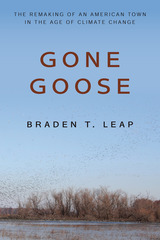 Gone Goose: The Remaking of an American Town in the Age of Climate Change
Braden T. Leap
Temple University Press, 2019 Sumner, MO, pop. 102, near the Swan Lake National Wildlife Refuge, proclaims itself “The Wild Goose Capital of the World.” It even displays Maxie, the World’s largest goose: a 40-foot tall fiberglass statue with a wingspan stretching more than 60 feet. But while the 200,000 Canada geese that spent their falls and winters at Swan Lake helped generate millions of dollars for the local economy—with hunting and the annual Goose Festival—climate change, as well as environmental and land use issues, have caused the birds to disappear. The economic loss of the geese and the activities they inspired served as key building blocks in the rural identities residents had developed and treasured. In his timely and topical book, Gone Goose, Braden Leap observes how members of this rural town adapted, reorganized, and reinvented themselves in the wake of climate change—and how they continued to cultivate respect and belonging in their community. Leap conducted interviews with residents and participated in various community events to explore how they reimagine their relationships with each other as well as their community’s relationship with the environment, even as they wish the geese would return.
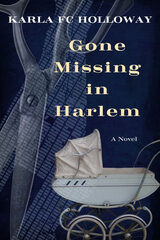 Gone Missing in Harlem: A Novel
Karla FC Holloway
Northwestern University Press, 2021 In her anticipated second novel, Karla Holloway evokes the resilience of a family whose journey traces the river of America’s early twentieth century. The Mosby family, like other thousands, migrate from the loblolly-scented Carolinas north to the Harlem of their aspirations—with its promise of freedom and opportunities, sunlit boulevards, and elegant societies.
The family arrives as Harlem staggers under the flu pandemic that follows the First World War. DeLilah Mosby and her daughter, Selma, meet difficulties with backbone and resolve to make a home for themselves in the city, and Selma has a baby, Chloe. As the Great Depression creeps across the world at the close of the twenties, however, the farsighted see hard times coming.
The panic of the early thirties is embodied in the kidnapping and murder of the infant son of the nation’s dashing young aviator, Charles Lindbergh. A transfixed public follows the manhunt in the press and on the radio. Then Chloe goes missing—but her disappearance does not draw the same attention. Wry and perceptive Weldon Haynie Thomas, the city’s first “colored” policeman, takes the case.
The urgent investigation tests Thomas’s abilities to draw out the secrets Harlem harbors, untangling the color-coded connections and relationships that keep company with greed, ghosts, and grief. With nuanced characters, lush historical detail, and a lyrical voice, Gone Missing in Harlem affirms the restoring powers of home and family.
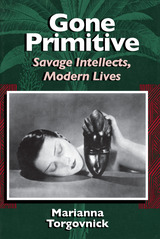 Gone Primitive: Savage Intellects, Modern Lives
Marianna Torgovnick
University of Chicago Press, 1990 In this acclaimed book, Torgovnick explores the obsessions,
fears, and longings that have produced Western views of the
primitive. Crossing an extraordinary range of fields
(anthropology, psychology, literature, art, and popular
culture), Gone Primitive will engage not just
specialists but anyone who has ever worn Native American
jewelry, thrilled to Indiana Jones, or considered buying an
African mask.
"A superb book; and—in a way that goes beyond what
being good as a book usually implies—it is a kind of gift to
its own culture, a guide to the perplexed. It is lucid,
usually fair, laced with a certain feminist mockery and
animated by some surprising sympathies."—Arthur C. Danto,
New York Times Book Review
"An impassioned exploration of the deep waters beneath Western primitivism. . . . Torgovnick's readings are deliberately, rewardingly provocative."—Scott L. Malcomson, Voice Literary Supplement
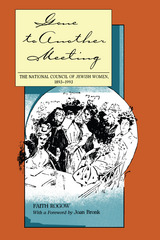 Gone to Another Meeting: The National Council of Jewish Women, 1893-1993
Faith Rogow
University of Alabama Press, 1993 The first comprehensive history of the oldest national religious Jewish women's organization in the United States
Gone to Another Meeting charts the development of the National Council of Jewish Women (NCJW) and its impact on both the Jewish Community in the United States and American Society in general.
Founded in 1893 by Hannah Greenebaum Solomon, NCJW provided a conduit through which Jewish women’s voices could be heard and brought a Jewish voice to America’s women’s rights movement. NCJW would come to represent both the modernization and renewal of traditional Jewish womanhood. Through its emphasis on motherhood, its adoption of domestic feminism, and its efforts to carve a distinct Jewish niche in the late 19th-century Progressive social reform movement in the largely Christian world of women’s clubs, NCJW was instrumental in defining a uniquely American version of Jewish womanhood.
 Gone to Ground: A History of Environment and Infrastructure in Dar es Salaam
Emily Brownell
University of Pittsburgh Press, 2020 Finalist, 2021 ASA Bethwell A. Ogot Book Prize
Gone to Ground is an investigation into the material and political forces that transformed the cityscape of Dar es Salaam, Tanzania in the 1970s and early 1980s. It is both the story of a particular city and the history of a global moment of massive urban transformation from the perspective of those at the center of this shift. Built around an archive of newspapers, oral history interviews, planning documents, and a broad compendium of development reports, Emily Brownell writes about how urbanites navigated the state’s anti-urban planning policies along with the city’s fracturing infrastructures and profound shortages of staple goods to shape Dar’s environment. They did so most frequently by “going to ground” in the urban periphery, orienting their lives to the city’s outskirts where they could plant small farms, find building materials, produce charcoal, and escape the state’s policing of urban space.
Taking seriously as historical subject the daily hurdles of families to find housing, food, transportation, and space in the city, these quotidian concerns are drawn into conversation with broader national and transnational anxieties about the oil crisis, resource shortages, infrastructure, and African socialism. In bringing these concerns together into the same frame, Gone to Ground considers how the material and political anxieties of the era were made manifest in debates about building materials, imported technologies, urban agriculture, energy use, and who defines living and laboring in the city.
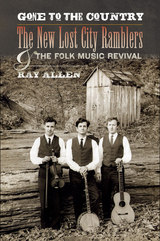 Gone to the Country: The New Lost City Ramblers and the Folk Music Revival
Ray Allen
University of Illinois Press, 2010 Gone to the Country chronicles the life and music of the New Lost City Ramblers, a trio of city-bred musicians who helped pioneer the resurgence of southern roots music during the folk revival of the late 1950s and 1960s. Formed in 1958 by Mike Seeger, John Cohen, and Tom Paley, the Ramblers introduced the regional styles of southern ballads, blues, string bands, and bluegrass to northerners yearning for a sound and an experience not found in mainstream music. Ray Allen interweaves biography, history, and music criticism to follow the band from its New York roots to their involvement with the commercial folk music boom. Allen details their struggle to establish themselves amid critical debates about traditionalism brought on by their brand of folk revivalism. He explores how the Ramblers ascribed notions of cultural authenticity to certain musical practices and performers and how the trio served as a link between southern folk music and northern urban audiences who had little previous exposure to rural roots styles. Highlighting the role of tradition in the social upheaval of mid-century America, Gone to the Country draws on extensive interviews and personal correspondence with band members and digs deep into the Ramblers' rich trove of recordings.
Gone to the Swamp: Raw Materials for the Good Life in the Mobile-Tensaw Delta
Robert Leslie Smith
University of Alabama Press, 2008 Normal0falsefalsefalseMicrosoftInternetExplorer4Normal0falsefalsefalseMicrosoftInternetExplorer4 To make a living here, one had to be capable, confident, clever and inventive, know a lot about survival, be able to fashion and repair tools, navigate a boat, fell a tree, treat a snakebite, make a meal from whatever was handy without asking too many questions about it, and get along with folks. This fascinating and instructive book is the careful and unpretentious account of a man who was artful in all the skills needed to survive and raise a family in an area where most people would be lost or helpless. Smith’s story is an important record of a way of life beginning to disappear, a loss not fully yet realized. We are lucky to have a work that is both instructive and warm-hearted and that preserves so much hard-won knowledge.
The Goner School
Jessica Laser
University of Iowa Press, 2024 2025 Griffin Poetry Prize, FinalistJessica Laser has given her generation a voice and a name in this masterful, funny, and heartbreaking collection, The Goner School. Members of this school, despairing and hopeful, count themselves among the self-aware, trauma-informed inheritors of a warming, warring planet. Childhood, the gym, plant medicine ceremonies, PhD programs, Jews, evangelicals, everyone you’ve slept with, Lake Michigan, the Bay Area, William James, and Taylor Swift may seem incongruous, but they all take place in one world from which, try as we might, there is no escape.
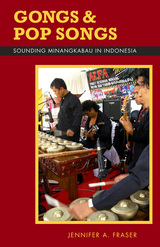 Gongs and Pop Songs: Sounding Minangkabau in Indonesia
Jennifer A. Fraser
Ohio University Press, 2015 Scholarship on the musical traditions of Indonesia has long focused on practices from Java and Bali, including famed gamelan traditions, at the expense of the wide diversity of other musical forms within the archipelago. Jennifer A. Fraser counters this tendency by exploring a little-known gong tradition from Sumatra called talempong, long associated with people who identify themselves as Minangkabau. Grounded in rich ethnographic data and supplemented with online audiovisual materials, Gongs and Pop Songs is the first study to chronicle the history and variety of talempong styles. It reveals the continued vitality of older modes in rural communities in the twenty-first century, while tracing the emergence of newer ones with radically different aesthetic frames and values. Each talempong style discussed incorporates into its repertoire Minangkabau pop or indigenous songs, both of which have strong associations with the place and people. These contemporary developments in talempong have taken place against a shifting political, social, and economic backdrop: the institutionalization of indigenous arts, a failed regional rebellion, and the pressures of a free-market economy. Fraser adopts a cognitive approach to ethnicity, asking how people understand themselves as Minangkabau through talempong and how different styles of the genre help create and articulate ethnic sentiments—that is, how they help people sound Minangkabau.
 Good and Bad Hair
Gaskins, Bill
Rutgers University Press, 1997 In a time when image is indeed everything, our personal appearance has a tremendous effect on nearly every aspect of our lives on a daily basis. Our choice of hairstyle can mean the difference between acceptance and rejection by groups and individuals. The choices made by African Americans are particularly charged, often affecting the wearer and the viewer in unique and sometimes life-altering ways. Good and Bad Hair emerges out of photographer Bill Gaskins's traveling photo exhibition of the same name. The book features 60 evocative photographs of African American men, women, and children, documenting contemporary black hairstyles and their role as a feature of African American culture. On one level, the photographs present readers with a variety of popular and personal approaches to wearing one's hair. On another level, they isolate what amounts to a bold, assertive departure from the common definition of American beauty that excludes the physical features of many people of African descent. This narrow definition of beauty has created a race-based measurement for what is considered "good" and "bad" hair. Gaskins's pictures identify African Americans from different regions of the United States who expressively symbolize their sense of self and often their sense of an African or black identity through their hair.
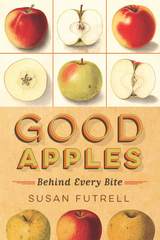 Good Apples: Behind Every Bite
Susan Futrell
University of Iowa Press, 2017 Apples are so ordinary and so ubiquitous that we often take them for granted. Yet it is surprisingly challenging to grow and sell such a common fruit. In fact, producing diverse, tasty apples for the market requires almost as much ingenuity and interdependence as building and maintaining a vibrant democracy. Understanding the geographic, ecological, and economic forces shaping the choices of apple growers, apple pickers, and apple buyers illuminates what’s at stake in the way we organize our food system.
Good Apples is for anyone who wants to go beyond the kitchen and backyard into the orchards, packing sheds, and cold storage rooms; into the laboratories and experiment stations; and into the warehouses, stockrooms, and marketing meetings, to better understand how we as citizens and eaters can sustain the farms that provide food for our communities. Susan Futrell has spent years working in sustainable food distribution, including more than a decade with apple growers. She shows us why sustaining family orchards, like family farms, may be essential to the soul of our nation.
 The Good Beer Guide to New England
Andy Crouch
University Press of New England, 2006 With wit, enthusiasm, and a deep respect for the craft of brewing, Andy Crouch profiles nearly one hundred establishments in New England, offering a description and history of each, as well as insights into each brewmaster's philosophy and brewing style. For each brewery and brewpub profiled, Crouch covers the range of beers available and identifies its flagship product; he also highlights his choice for its “best beer,” which is rarely its most popular or best known offering. Crouch offers judicious evaluations of food, ambience, and of course, the beer; he also provides information on the availability of tours, directions and parking, hours of operation, entertainment, local sights of interest, and whether beer is available for take-away. In addition, he includes essays on the brewing process, understanding and appreciating beer, and a list of “eleven great New England beer bars.” Whether well-brewed beer is the focus of a trip or a welcomed complement, beer enthusiasts and novices alike will find this guide a worthwhile companion wherever they travel in New England.
 Good Bones
Maggie Smith
Tupelo Press, 2017 A powerful collection that includes the viral hit poem "Good Bones" -- Public Radio International's Official Poem of 2016!
Good Bones is a collection of modern poetry that speaks to the world we live in. Maggie Smith contemplates the past and our future, life and death, childhood and motherhood. She writes out of the experience of motherhood, inspired by watching her own children read the world like a book they’ve just opened, knowing nothing of the characters or plot. Smith takes in the dark world around her with a critical eye, always searching for the hidden goodness: compassion, empathy, honesty. “There is a light,” she tells us, “and the light is good.” Smith skillfully reveals the layers of the world around us through lyric language and vivid imagery: “For every bird there is a stone thrown at a bird. / For every loved child, a child broken, bagged, / sunk in a lake.” These poems stare down darkness while cultivating and sustaining possibility and addressing a larger world. We come away from this collection hopeful about making the world a better place, a place to share with future generations. As Smith tells us in Good Bones, “This place could be beautiful, right? You could make this place beautiful.”
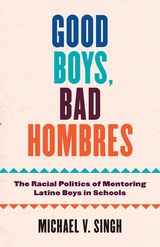 Good Boys, Bad Hombres: The Racial Politics of Mentoring Latino Boys in Schools
Michael V Singh
University of Minnesota Press, 2024 The unintended consequences of youth empowerment programs for Latino boys
Educational research has long documented the politics of punishment for boys and young men of color in schools—but what about the politics of empowerment and inclusion? In Good Boys, Bad Hombres, Michael V. Singh focuses on this aspect of youth control in schools, asking on whose terms a positive Latino manhood gets to be envisioned.
Based on two years of ethnographic research in an urban school district in California, Good Boys, Bad Hombres examines Latino Male Success, a school-based mentorship program for Latino boys. Instead of attempting to shape these boys’ lives through the threat of punishment, the program aims to provide an “invitation to a respectable and productive masculinity” framed as being rooted in traditional Latinx signifiers of manhood. Singh argues, however, that the promotion of this aspirational form of Latino masculinity is rooted in neoliberal multiculturalism, heteropatriarchy, and anti-Blackness, and that even such empowerment programs can unintentionally reproduce attitudes that paint Latino boys as problematic and in need of control and containment.
An insightful gender analysis, Good Boys, Bad Hombres sheds light on how mentorship is a reaction to the alleged crisis of Latino boys and is governed by the perceived remedies of the neoliberal state. Documenting the ways Latino men and boys resist the politics of neoliberal empowerment for new visions of justice, Singh works to deconstruct male empowerment, arguing that new narratives and practices—beyond patriarchal redemption—are necessary for a reimagining of Latino manhood in schools and beyond.
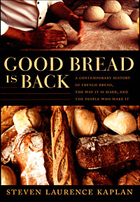 Good Bread Is Back: A Contemporary History of French Bread, the Way It Is Made, and the People Who Make It
Steven Laurence Kaplan
Duke University Press, 2006 In Good Bread Is Back, historian and leading French bread expert Steven Laurence Kaplan takes readers into aromatic Parisian bakeries as he explains how good bread began to reappear in France in the 1990s, following almost a century of decline in quality. Kaplan describes how, while bread comprised the bulk of the French diet during the eighteenth century, by the twentieth, per capita consumption had dropped off precipitously. This was largely due to social and economic modernization and the availability of a wider choice of foods. But part of the problem was that the bread did not taste good. In a culture in which bread is sacrosanct, bad bread was more than a gastronomical disappointment; it was a threat to France's sense of itself. By the mid-1990s bakers rallied, and bread officially designated as "bread of the French tradition" was in demand throughout Paris. Kaplan meticulously describes good bread's ideal crust and crumb (interior), mouth feel, aroma, and taste. He discusses the breadmaking process in extraordinary detail, from the ingredients to the kneading, shaping, and baking, and even the sound bread should make when it comes out of the oven. Kaplan does more than tell the story of the revival of good bread in France. He makes the reader see, smell, taste, feel, and even hear why it is so very wonderful that good bread is back.
 The Good Citizen: A History of American Civic Life
Michael Schudson
Harvard University Press In 1996, less than half of all eligible voters bothered to vote. Fewer citizens each year follow government and public affairs regularly. Is popular sovereignty a failure? Not necessarily, argues Michael Schudson in this provocative history of citizenship in America. Schudson sees American politics as evolving from a "politics of assent" in colonial times and the eighteenth century, in which voting generally reaffirmed the social hierarchy of the community; to a "politics of affiliation" in the nineteenth century, in which party loyalty was paramount for the good citizen. Progressive reforms around the turn of the century reduced the power of parties and increased the role of education, making way for the "informed citizen," which remains the ideal in American civic life. Today a fourth model, "the rights-bearing citizen," supplements the "informed citizen" model and makes the courthouse as well as the voting booth a channel for citizenship.
Good Company: A Mining Family in Fairbanks, Alaska
Sarah Isto
University of Alaska Press, 2006 Good Company is a vivid and compelling story of life in early twentieth-century Alaska. From the lean years of the Depression through World War II and Vietnam, Sarah Isto’s family made a home in “company housing” in the small mining town of Fairbanks. With a wry sense of humor and an eye for detail, Isto tells of the courtship and marriage of her parents and her own Fairbanks childhood, weaving rich descriptions of daily life and northern living into her story.
With grace and perception, Good Company celebrates the joys and challenges of family life on the Alaska frontier.
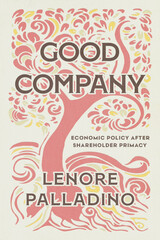 Good Company: Economic Policy after Shareholder Primacy
Lenore Palladino
University of Chicago Press, 2024 On the faulty intellectual origins of shareholder primacy—and how policy can win back what’s been lost. In an era of shareholder primacy, share price is king. Businesses operate with short-term goals to deliver profits to shareholders, enjoying stability (and bonuses) in the process. While the public bemoans the doctrine for its insularity and wealth-consolidating effects, its influence over corporate governance persists. Good Company offers an exacting argument for why shareholder primacy was never the right model to follow for truly understanding how corporations operate. Lenore Palladino shows that corporations draw power from public charters—agreements that allow corporations to enjoy all manner of operational benefits. In return, companies are meant to innovate for the betterment of the societies that support them. However, that debt—increasingly wielded for stock buybacks and shareholder bonuses—is not being repaid. Palladino theorizes a modern corporation that plays its intended role while delivering social and economic good in the process and offers tangible policy solutions to make this a reality. Good Company is both an expert introduction to the political economy of the firm—as it was, as it is, as it can be—and a calibrating examination of how public policy can shape companies, and societies, for the better.
The Good Dark
Annie Guthrie
Tupelo Press, 2015 In the sequence of poems comprising Annie Guthrie’s first book, the quest for the meaning of human consciousness and its tangled subjectivity is drawn as a slow-building narrative of the mystic experience. The journey enacted is that of the self as character, who encounters insurmountable mysteries in a breaking selfhood. A dossier of contemplative exploration, THE GOOD DARK chronicles an immersive search in three acts: Unwitting, Chorus, and Body: stations through which the character must pass, and where she is accumulatively confessed, compounded and erased.
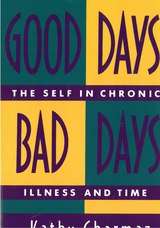 Good Days, Bad Days: The Self and Chronic Illness in Time
Kathy C Charmaz
Rutgers University Press, 1993 Kathy Charmaz has written a compelling book on chronic illness and the effect it has on the self-concepts of those who suffer. It will appeal to anyone facing a long-term problem that seems beyond control. Her work is based on interviews with people suffering from such diseases as cancer, multiple sclerosis, and arthritis, and with their caregivers. Charmaz looks at how these people disclose their illness, how they experience their emotions, and how they manage daily life. Illness provides a mirror that allows sufferers to see themselves and to become more introspective. As they struggle for control over illness and control over time, they also struggle to control the central images of the self. For example, the chronically ill may situate their self-concepts in the past, present, or future. Charmaz examines under what conditions they situate their self-concepts in each of those timeframes. People may say they live one day at a time. They may bracket certain experiences, such as a heart attack, as timemarkers or turning points in the past. Or they may look ahead to recovering their health. Or ahead to death. Charmaz artfully combines near jargon-free analysis with moving stories about how people have experienced illness, usually told in the sufferers' own words. She enters the world of the chronically ill, and brings us into it.
A Good Deal: Selected Stories from "The Massachusetts Review"
Mary Heath
University of Massachusetts Press, 1988 For twenty-seven years The Massachusetts Review has offered its readers a lively and eclectic mix of essays, stories, poetry, and art. Now the editors have gathered together twenty of the best stories from past issues of the journal, by writers known and unknown.
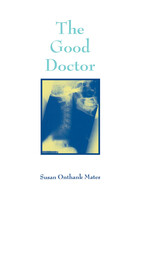 The Good Doctor
Susan Onthank Mates
University of Iowa Press, 1997 Many of Mates' characters have experienced some sort of cultural dislocation. In "Theng," refugees from Cambodia living in Providence, Rhode Island, struggle to maintain their dignity in the face of despair and the bittersweet memories of their former home. In "Shambalileh," a Persian woman, unable to have children with her American husband, is forced to reexamine her status both as wife and foreigner. Unifying these incredibly diverse stories is the brave honesty with which the characters confront the tenuousness of their situations. For the most part, they share the tenacity of the women in "Shambalileh," who "with great caution…began to imagine the rest of her life." The central characters in several stories are doctors, whose candid explorations of the vast moral implications of medical practice make of their lives a sort of psychic battleground between good and evil. In "The Good Doctor," a doctor torn between her dedication to medicine and her own requirements as a human being—what many of us might call her weaknesses—arrives at an intriguing conclusion. An intern in "Ambulance" risks her own well-being to save the life of a victim of gang violence. The twelve stories in this collection are powerful and durable. The debate between good and evil is so intense that the daily experiences of Mates' characters, transformed and reorganized, become psychic quests. Mates takes us back to the fundamental question that is the fountainhead of all serious fiction: how should we live?
 A Good Drink: In Pursuit of Sustainable Spirits
Shanna Farrell
Island Press, 2021 “Insightful tour de force… Farrell’s writing is as informative as it is intoxicating” -- Publishers Weekly
Shanna Farrell loves a good drink. As a bartender, she not only poured spirits, but learned their stories—who made them and how. Living in San Francisco, surrounded by farm-to-table restaurants and high-end bars, she wondered why the eco-consciousness devoted to food didn’t extend to drinks.
The short answer is that we don’t think of spirits as food. But whether it's rum, brandy, whiskey, or tequila, drinks are distilled from the same crops that end up on our tables. Most are grown with chemicals that cause pesticide resistance and pollute waterways, and distilling itself requires huge volumes of water. Even bars are notorious for generating mountains of trash. The good news is that while the good drink movement is far behind the good food movement, it is emerging.
In A Good Drink, Farrell goes in search of the bars, distillers, and farmers who are driving a transformation to sustainable spirits. She meets mezcaleros in Guadalajara who are working to preserve traditional ways of producing mezcal, for the health of the local land, the wallets of the local farmers, and the culture of the community. She visits distillers in South Carolina who are bringing a rare variety of corn back from near extinction to make one of the most sought-after bourbons in the world. She meets a London bar owner who has eliminated individual bottles and ice, acculturating drinkers to a new definition of luxury.
These individuals are part of a growing trend to recognize spirits for what they are—part of our food system. For readers who have ever wondered who grew the pears that went into their brandy or why their cocktail is an unnatural shade of red, A Good Drink will be an eye-opening tour of the spirits industry. For anyone who cares about the future of the planet, it offers a hopeful vision of change, one pour at a time.
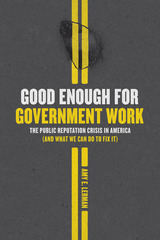 Good Enough for Government Work: The Public Reputation Crisis in America (And What We Can Do to Fix It)
Amy E. Lerman
University of Chicago Press, 2019 American government is in the midst of a reputation crisis. An overwhelming majority of citizens—Republicans and Democrats alike—hold negative perceptions of the government and believe it is wasteful, inefficient, and doing a generally poor job managing public programs and providing public services. When social problems arise, Americans are therefore skeptical that the government has the ability to respond effectively. It’s a serious problem, argues Amy E. Lerman, and it will not be a simple one to fix.
With Good Enough for Government Work, Lerman uses surveys, experiments, and public opinion data to argue persuasively that the reputation of government is itself an impediment to government’s ability to achieve the common good. In addition to improving its efficiency and effectiveness, government therefore has an equally critical task: countering the belief that the public sector is mired in incompetence. Lerman takes readers through the main challenges. Negative perceptions are highly resistant to change, she shows, because we tend to perceive the world in a way that confirms our negative stereotypes of government—even in the face of new information. Those who hold particularly negative perceptions also begin to “opt out” in favor of private alternatives, such as sending their children to private schools, living in gated communities, and refusing to participate in public health insurance programs. When sufficient numbers of people opt out of public services, the result can be a decline in the objective quality of public provision. In this way, citizens’ beliefs about government can quickly become a self-fulfilling prophecy, with consequences for all. Lerman concludes with practical solutions for how the government might improve its reputation and roll back current efforts to eliminate or privatize even some of the most critical public services.
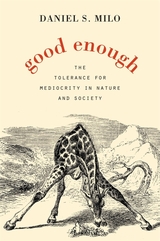 Good Enough: The Tolerance for Mediocrity in Nature and Society
Daniel S. Milo
Harvard University Press, 2019 In this spirited and irreverent critique of Darwin’s long hold over our imagination, a distinguished philosopher of science makes the case that, in culture as well as nature, not only the fittest survive: the world is full of the “good enough” that persist too.
Why is the genome of a salamander forty times larger than that of a human? Why does the avocado tree produce a million flowers and only a hundred fruits? Why, in short, is there so much waste in nature? In this lively and wide-ranging meditation on the curious accidents and unexpected detours on the path of life, Daniel Milo argues that we ask these questions because we’ve embraced a faulty conception of how evolution—and human society—really works.
Good Enough offers a vigorous critique of the quasi-monopoly that Darwin’s concept of natural selection has on our idea of the natural world. Darwinism excels in accounting for the evolution of traits, but it does not explain their excess in size and number. Many traits far exceed the optimal configuration to do the job, and yet the maintenance of this extra baggage does not prevent species from thriving for millions of years. Milo aims to give the messy side of nature its due—to stand up for the wasteful and inefficient organisms that nevertheless survive and multiply.
But he does not stop at the border between evolutionary theory and its social consequences. He argues provocatively that the theory of evolution through natural selection has acquired the trappings of an ethical system. Optimization, competitiveness, and innovation have become the watchwords of Western societies, yet their role in human lives—as in the rest of nature—is dangerously overrated. Imperfection is not just good enough: it may at times be essential to survival.
The Good European: Nietzsche's Work Sites in Word and Image
David Farrell Krell and Donald L. Bates
University of Chicago Press, 1997 Through photographs and translations of Friedrich Nietzsche's evocative writings on his work sites, David Farrell Krell and Donald L. Bates explore the cities and landscapes in which Nietzsche lived and worked.
"A brilliant juxtaposition of life and thought. . . . The sympathy of this pictorial biography is rivaled by few books on Nietzsche."—Charles M. Stang, Boston Book Review
"[A] distinguished addition to the Nietzsche-friendly corpus."—Alain de Botton, Los Angeles Times Book Review
"An odd and oddly endearing record of Nietzsche's travels."—John Banville, New York Review of Books
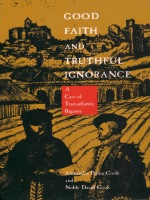 Good Faith and Truthful Ignorance: A Case of Transatlantic Bigamy
Alexandra Parma Cook and Noble David Cook
Duke University Press, 1991 Good Faith and Truthful Ignorance uncovers from history the fascinating and strange story of Spanish explorer Francisco Noguerol de Ulloa. in 1556, accompanied by his second wife, Francisco returned to his home in Spain after a profitable twenty-year sojourn in the new world of Peru. However, unlike most other rich conquistadores who returned to the land of their birth, Francisco was not allowed to settle into a life of leisure. Instead, he was charged with bigamy and illegal shipment of silver, was arrested and imprisoned. Francisco’s first wife (thought long dead) had filed suit in Spain against her renegade husband.
So begins the labyrinthine legal tale and engrossing drama of an explorer and his two wives, skillfully reconstructed through the expert and original archival research of Alexandra Parma Cook and Noble David Cook. Drawing on the remarkable records from the trial, the narrative of Francisco’s adventures provides a window into daily life in sixteenth-century Spain, as well as the mentalité and experience of conquest and settlement of the New World. Told from the point of view of the conquerors, Francisco’s story reveals not only the lives of the middle class and minor nobility but also much about those at the lower rungs of the social order and relations between the sexes.
In the tradition of Carlo Ginzberg’s The Cheese and the Worms and Natalie Zemon Davis’ The Return of Martin Guerre, Good Faith and Truthful Ignorance illuminates an historical period—the world of sixteenth-century Spain and Peru—through the wonderful and unusual story of one man and his two wives.
 Good Fences, Bad Neighbors: Border Fixity and International Conflict
Boaz Atzili
University of Chicago Press, 2011 Border fixity—the proscription of foreign conquest and the annexation of homeland territory—has, since World War II, become a powerful norm in world politics. This development has been said to increase stability and peace in international relations. Yet, in a world in which it is unacceptable to challenge international borders by force, sociopolitically weak states remain a significant source of widespread conflict, war, and instability. In this book, Boaz Atzili argues that the process of state building has long been influenced by external territorial pressures and competition, with the absence of border fixity contributing to the evolution of strong states—and its presence to the survival of weak ones. What results from this norm, he argues, are conditions that make internal conflict and the spillover of interstate war more likely. Using a comparison of historical and contemporary case studies, Atzili sheds light on the relationship between state weakness and conflict. His argument that under some circumstances an international norm that was established to preserve the peace may actually create conditions that are ripe for war is sure to generate debate and shed light on the dynamics of continuing conflict in the twenty-first century.
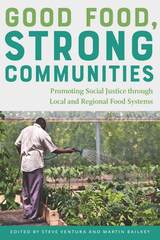 Good Food, Strong Communities: Promoting Social Justice through Local and Regional Food Systems
Steve Ventura and Martin Bailkey
University of Iowa Press, 2017 Many Americans are hungry, while others struggle to find healthy foods. What are communities doing to address this problem, and what should they be doing? Good Food, Strong Communities shares ideas and stories about efforts to improve food security in large urban areas of the United States by strengthening community food systems. It draws on five years of collaboration between a research team comprised of the University of Wisconsin, Growing Power, and the Michael Fields Agricultural Institute, and more than thirty organizations on the front lines of this work in Boston, Chicago, Detroit, Milwaukee, Minnesota, Los Angeles, Madison, and Cedar Rapids. Here, activists and scholars talk about what’s working and what still needs to be done to ensure that everyone has access to readily available, affordable, appropriate, and acceptable food.
The approach begins by laying out the basic principles of food security and food justice in light of the diversity of food system practices and innovations in America’s cities. The contributing authors address land access for urban agriculture, debates over city farming, new possibilities in food processing, and the marketing of healthy food. They put these basic elements—land, production, processing, and marketing—in the context of municipal policy, education, and food justice and sovereignty, particularly for people of color. While the path of a food product from its producer to its consumer may seem straightforward on the surface, the apparent simplicity hides the complex logistical—and value-laden—factors that create and maintain a food system. This book helps readers understand how a food system functions and how individual and community initiatives can lessen the problems associated with an industrialized food system.
 Good for the Jews
Debra Spark
University of Michigan Press, 2009 Good for the Jews is a smart, funny, sexy novel set in Madison, Wisconsin, during the Bush administration. Part mystery and part stranger-comes-to town story, Good for the Jews is loosely based on the biblical book of Esther. Like Esther, Debra Spark's characters deal with anti-Semitism and the way that powerful men—and the women who love them—negotiate bureaucracies. At the core of the story of right and wrong are young, attractive Ellen Hirschorn and her older cousin Mose, a high school teacher who thinks he knows, in fact, what is "good for the Jews"—and for Ellen, too. Their stories intertwine with those of the school superintendent, his ex-wife and son, and a new principal. Workplace treachery, the bonds of family, coming of age, and romantic relationships all take center stage as the characters negotiate the fallout from a puzzling fire. Spark's evocative writing style and sharp, understanding treatment of her diverse characters draw the reader into this surprising page-turner, a finalist for the 2009 Foreword Magazine Book of the Year Award.
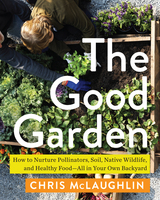 The Good Garden: How to Nurture Pollinators, Soil, Native Wildlife, and Healthy Food—All in Your Own Backyard
Chris McLaughlin
Island Press, 2023 What makes a garden good? For Chris McLaughlin, it’s about growing the healthiest, most scrumptious fruits and veggies possible, but it’s also about giving back. How can your little patch of Earth become a sanctuary for threatened wildlife, sequester carbon, and nurture native plants?
McLaughlin gives you all the tricks and tips you need to grow the sustainable garden of your dreams. Drawing from established traditions, such as permaculture and French intensive gardening, and McLaughlin’s hard-earned experience, The Good Garden is a joyful guide for newbies and experienced gardeners alike. It will teach you the fundamentals, including how to choose the right plant varieties for your microclimate, and proven methods to fight pests without chemicals. You will also discover the nuances of developing a green thumb, from picking species to attract specific types of pollinators to composting techniques based on time available. Lovely four-color photography will show you good gardening in action.
Most importantly, The Good Garden will help you foster a sense of meaning in your garden. Maybe the goal is to reduce food miles and plastic waste by growing delicious berries. Maybe it’s to meet neighbors who also care about the planet through a seed-swap. Maybe it’s a quiet moment patting the bunny whose manure will replace toxic fertilizers in the soil. A good garden offers endless possibilities and The Good Garden offers a wealth of knowledge and inspiration.
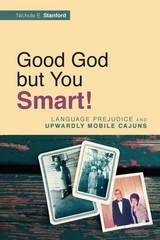 Good God but You Smart!: Language Prejudice and Upwardly Mobile Cajuns
Nichole E. Stanford
Utah State University Press, 2016 Taking Cajuns as a case study, Good God but You Smart! explores the subtle ways language bias is used in classrooms, within families, and in pop culture references to enforce systemic economic inequality. It is the first book in composition studies to examine comprehensively, and from an insider’s perspective, the cultural and linguistic assimilation of Cajuns in Louisiana.
The study investigates the complicated motivations and cultural concessions of upwardly mobile Cajuns who “choose” to self-censor—to speak Standardized English over the Cajun English that carries their cultural identity. Drawing on surveys of English teachers in four Louisiana colleges, previously unpublished archival data, and Pierre Bourdieu’s theory of the legitimate language, author Nichole Stanford explores how socioeconomic and political pressures rooted in language prejudice make code switching, or self-censoring in public, seem a responsible decision. Yet teaching students to skirt others’ prejudice toward certain dialects only puts off actually dealing with the prejudice. Focusing on what goes on outside classrooms, Stanford critiques code switching and cautions users of code meshing that pedagogical responses within the educational system are limited by the reproductive function of schools. Each theory section includes parallel memoir sections in the Cajun tradition of storytelling to open an experiential window to the study without technical language.
Through its explication of language legitimacy and its grounding in lived experience, Good God but You Smart! is an essential addition to the pedagogical canon of language minority studies like those of Villanueva, Gilyard, Smitherman, and Rose.
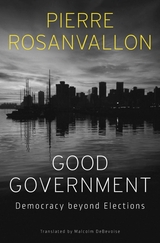 Good Government: Democracy beyond Elections
Pierre Rosanvallon
Harvard University Press, 2018 Few would disagree that Western democracies are experiencing a crisis of representation. In the United States, gerrymandering and concentrated political geographies have placed the Congress and state legislatures in a stranglehold that is often at odds with public opinion. Campaign financing ensures that only the affluent have voice in legislation. Europeans, meanwhile, increasingly see the European Union as an anti-democratic body whose “diktats” have no basis in popular rule. The response, however, has not been an effective pursuit of better representation. In Good Government, Pierre Rosanvallon examines the long history of the alternative to which the public has gravitated: the empowered executive.
Rosanvallon argues that, faced with everyday ineptitude in governance, people become attracted to strong leaders and bold executive action. If these fail, they too often want even stronger personal leadership. Whereas nineteenth-century liberals and reformers longed for parliamentary sovereignty, nowadays few contest the “imperial presidency.” Rosanvallon traces this history from the Weimar Republic to Charles De Gaulle’s “exceptional” presidency to the Bush-Cheney concentration of executive power.
Europeans rebelling against the technocratic EU and Americans fed up with the “administrative state” have turned to charismatic figures, from Donald Trump to Viktor Orbán, who tout personal strength as their greatest asset. This is not just a right-wing phenomenon, though, as liberal contentment with Obama’s drone war demonstrates. Rosanvallon makes clear that contemporary “presidentialism” may reflect the particular concerns of the moment, but its many precursors demonstrate that democracy has always struggled with tension between popular government and concentrated authority.
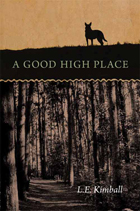 A Good High Place
L.E. Kimball
Northern Illinois University Press, 2010
Epic and nonlinear in nature, A Good High Place chronicles the lives of two women—Luella and Kachina—who, like the orbit of the sun and the moon, both attract and repel each other. Luella’s suspicion that her younger sister—who supposedly died at birth—is being raised as the sister of Kachina sets her on a path of self-discovery that generates more questions than answers. The Native American Kachina is an enigma, a person with a special healing touch who, it is rumored, never ages, leaves no footprints, and might never die. Her goal is to help her people, the Aninshinaabek, remain on the Red Path and resist being absorbed by white culture. To do this, she takes guidance from what she refers to as The Day, guidance Luella assumes can be “nothing less than the murmured confidences of God pouring from the sky.” Ultimately, Kachina and Luella find friendship among the conflicts of culture, duty, and even loving the same man.
Set during the years prior to World War I in Elk Rapids, Michigan, A Good High Place addresses familial struggles and those of a nation moving inexorably toward the age of the automobile. The sometimes painful adaptations of a faster-paced age are embodied, in part, in the struggles of Luella’s father who, already troubled by the death of his wife, wrestles with the realization that his livelihood as a steamboat captain is becoming obsolete.
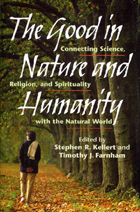 The Good in Nature and Humanity: Connecting Science, Religion, and Spirituality with the Natural World
Edited by Stephen R. Kellert and Timothy J. Farnham
Island Press, 2010 Scientists, theologians, and the spiritually inclined, as well as all those concerned with humanity's increasingly widespread environmental impact, are beginning to recognize that our ongoing abuse of the earth diminishes our moral as well as our material condition. Many people are coming to believe that strengthening the bonds among spirituality, science, and the natural world offers an important key to addressing the pervasive environmental problems we face. The Good in Nature and Humanity brings together 20 leading thinkers and writers -- including Ursula Goodenough, Lynn Margulis, Dorion Sagan, Carl Safina, David Petersen, Wendell Berry, Terry Tempest Williams, and Barry Lopez -- to examine the divide between faith and reason, and to seek a means for developing an environmental ethic that will help us confront two of our most imperiling crises: global environmental destruction and an impoverished spirituality. The book explores the ways in which science, spirit, and religion can guide the experience and understanding of our ongoing relationship with the natural world and examines how the integration of science and spirituality can equip us to make wiser choices in using and managing the natural environment. The book also provides compelling stories that offer a narrative understanding of the relations among science, spirit, and nature. Grounded in the premise that neither science nor religion can by itself resolve the prevailing malaise of environmental and moral decline, contributors seek viable approaches to averting environmental catastrophe and, more positively, to achieving a more harmonious relationship with the natural world. By bridging the gap between the rational and the religious through the concern of each for understanding the human relation to creation, The Good in Nature and Humanity offers an important means for pursuing the quest for a more secure and meaningful world.
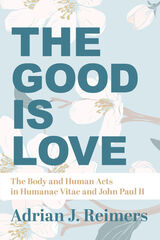 The Good Is Love: The Body and Human Acts in Humanae Vitae and John Paul II
Adrian Reimers
St. Augustine's Press, 2020 John Paul II in his personalist approach to moral questions reaffirmed that as sin offends that which is good, if we truly know what human love is––and that it is good––we would thereby see how certain acts can never be acceptable insofar as they in all cases wound this love. Yet in moral debates surrounding love, sex and contraception Adrian Reimers observes that we are not using this approach and these debates are not advancing the cause of real love.
Reimers draws upon the encyclical Humanae Vitae and John Paul II’s catechesis known as the theology of the body to respond to the stalled development of moral theology on the issues most crucial to human love and intimacy. “It is time, we are told, for a ‘paradigm shift’ in the Catholic Church’s moral teaching, such shift representing a more pastoral and less dogmatic approach to moral issues,” writes Reimers. His claim that “a paradigm shift in moral theology and philosophy may be valuable––perhaps vital––to scholars who think and write about these sciences and to teachers who communicate moral truth” is not an exhortation to redefine moral truths. Rather, he argues that an approach to contraception, for example, that relies exclusively on natural law is a hackneyed one and often “tedious.”
John Paul II’s series of catechetical addresses known as the theology of the body was originally composed in the 1970s after Paul VI’s encyclical Humanae Vitae. Albeit derived from the writing of an archbishop and not yet pope, Reimers identifies John Paul II’s perspectives on love, sex and contraception as an essential force behind this so-called paradigm shift in continuity with the profound and unchanging truths set forth in Humanae Vitae. As Reimers states, “Moral truths do not change, even if our ways to understand them improve.”
How, then, is our sense of the goodness or badness of contraception meant to be helped by such a development of thought? Ethics grounded philosophically tends to lean toward legalism in the context of moral actions, says Reimers, as it emphasizes conformity to God’s law and largely overlooks “the relationship between moral behavior and the human person’s ultimate end of beatitude with God.” The important principle of the necessarily two-fold description that natural law gives to sex––namely, as unitive and procreative––must not be the authoritative end of the discussion regarding the moral nature of contraception. In an age where technology has given human beings new power it seems there must be new rules as well, and the conquest of procreative acts changes the human perception of the limitations once associated with harmful acts. Herein lies the importance of John Paul II’s catechesis––the goodness or badness of acts is not just concerned with end of a particular act. As Reimers writes, “If we are to understand the complex relationships among love, marriage, and their sexual expression, we must situate these within the context of the end of the human being.”
A position on contraception and human sexuality cannot be comprehensive without a concept of love properly understood. Human acts must bring us closer to sanctity, not to comfort or possession. Holiness is the perfection of love, and its pursuit aims at ultimate beatitude. This end, the truest love human can know, is the end which ultimately condemns contraception once and for all, as “contracepted sex is contrary to holiness.” Reimers unpacks this sometimes difficult truth in eight chapters, which begin with love and conclude with faithfulness to moral norms and a spirituality of marriage.
The arguments surrounding contraception and “good sex” seem to have set the grounds for coherently choosing a side rather than to have succeeded in presenting certain human acts as definitively immoral. As Reimers notes, a natural law position on contraception often fails to employ its greatest ally: the reality of authentic human love and “victory” of the individual in one’s sanctity as achieved through that love. This work will reorient the objectives and claims of the moral debate, as well as influence the popular notion of what love is and what it cannot be. It is an aid to scholars, students and study groups, humanists, and those who seek to deepen the sense of love’s highest physical expression.
 Good Jobs America
Paul Osterman
Russell Sage Foundation, 2012 America confronts a jobs crisis that has two faces. The first is obvious when we read the newspapers or talk with our friends and neighbors: there are simply not enough jobs to go around. The second jobs crisis is more subtle but no less serious: far too many jobs fall below the standard that most Americans would consider decent work. A quarter of working adults are trapped in jobs that do not provide living wages, health insurance, or much hope of upward mobility. The problem spans all races and ethnic groups and includes both native-born Americans and immigrants. But Good Jobs America provides examples from industries ranging from food services and retail to manufacturing and hospitals to demonstrate that bad jobs can be made into good ones. Paul Osterman and Beth Shulman make a rigorous argument that by enacting policies to help employers improve job quality we can create better jobs, and futures, for all workers. Good Jobs America dispels several myths about low-wage work and job quality. The book demonstrates that mobility out of the low-wage market is a chimera—far too many adults remain trapped in poor-quality jobs. Osterman and Shulman show that while education and training are important, policies aimed at improving earnings equality are essential to lifting workers out of poverty. The book also demolishes the myth that such policies would slow economic growth. The experiences of countries such as France, Germany, and the Netherlands, show that it is possible to mandate higher job standards while remaining competitive in international markets. Good Jobs America shows that both government and the firms that hire low-wage workers have important roles to play in improving the quality of low-wage jobs. Enforcement agencies might bolster the effectiveness of existing regulations by exerting pressure on parent companies, enabling effects to trickle down to the subsidiaries and sub-contractors where low-wage jobs are located. States like New York have already demonstrated that involving community and advocacy groups—such as immigrant rights organizations, social services agencies, and unions—in the enforcement process helps decrease workplace violations. And since better jobs reduce turnover and improve performance, career ladder programs within firms help create positions employees can aspire to. But in order for ladder programs to work, firms must also provide higher rungs—the career advancement opportunities workers need to get ahead. Low-wage employment occupies a significant share of the American labor market, but most of these jobs offer little and lead nowhere. Good Jobs America reappraises what we know about job quality and low-wage employment and makes a powerful argument for our obligation to help the most vulnerable workers. A core principle of U.S. society is that good jobs be made accessible to all. This book proposes that such a goal is possible if we are committed to realizing it.
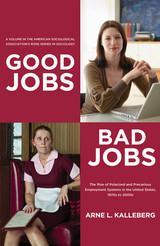 Good Jobs, Bad Jobs: The Rise of Polarized and Precarious Employment Systems in the United States, 1970s-2000s
Arne L. Kalleberg
Russell Sage Foundation, 2011 The economic boom of the 1990s veiled a grim reality: in addition to the growing gap between rich and poor, the gap between good and bad quality jobs was also expanding. The postwar prosperity of the mid-twentieth century had enabled millions of American workers to join the middle class, but as author Arne L. Kalleberg shows, by the 1970s this upward movement had slowed, in part due to the steady disappearance of secure, well-paying industrial jobs. Ever since, precarious employment has been on the rise—paying low wages, offering few benefits, and with virtually no long-term security. Today, the polarization between workers with higher skill levels and those with low skills and low wages is more entrenched than ever. Good Jobs, Bad Jobs traces this trend to large-scale transformations in the American labor market and the changing demographics of low-wage workers. Kalleberg draws on nearly four decades of survey data, as well as his own research, to evaluate trends in U.S. job quality and suggest ways to improve American labor market practices and social policies. Good Jobs, Bad Jobs provides an insightful analysis of how and why precarious employment is gaining ground in the labor market and the role these developments have played in the decline of the middle class. Kalleberg shows that by the 1970s, government deregulation, global competition, and the rise of the service sector gained traction, while institutional protections for workers—such as unions and minimum-wage legislation—weakened. Together, these forces marked the end of postwar security for American workers. The composition of the labor force also changed significantly; the number of dual-earner families increased, as did the share of the workforce comprised of women, non-white, and immigrant workers. Of these groups, blacks, Latinos, and immigrants remain concentrated in the most precarious and low-quality jobs, with educational attainment being the leading indicator of who will earn the highest wages and experience the most job security and highest levels of autonomy and control over their jobs and schedules. Kalleberg demonstrates, however, that building a better safety net—increasing government responsibility for worker health care and retirement, as well as strengthening unions—can go a long way toward redressing the effects of today’s volatile labor market. There is every reason to expect that the growth of precarious jobs—which already make up a significant share of the American job market—will continue. Good Jobs, Bad Jobs deftly shows that the decline in U.S. job quality is not the result of fluctuations in the business cycle, but rather the result of economic restructuring and the disappearance of institutional protections for workers. Only government, employers and labor working together on long-term strategies—including an expanded safety net, strengthened legal protections, and better training opportunities—can help reverse this trend. A Volume in the American Sociological Association’s Rose Series in Sociology.
The Good Life
Yi-Fu Tuan
University of Wisconsin Press, 1986 “[Tuan] explores answers to an old and unanswerable question: how should we live? . . . The Good Life is a little anthology of good feeling, touchstones of joy . . . These pleasures make the book a pleasure, not of conviction or belief, but of conversation’s meandering exploration.”—New York Times Book Review
“Tuan, after all, is one of the few geographers who can be read for pleasure, and by the public as well as by the professional. But read not merely for pleasure, nor yet to mark, learn, and inwardly digest. Rather, consider Tuan’s challenge to identify your concept of the good life, and then try to construct that life.”—Environment and Planning D: Society and Space
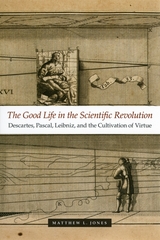 The Good Life in the Scientific Revolution: Descartes, Pascal, Leibniz, and the Cultivation of Virtue
Matthew L. Jones
University of Chicago Press, 2006 Amid the unrest, dislocation, and uncertainty of seventeenth-century Europe, readers seeking consolation and assurance turned to philosophical and scientific books that offered ways of conquering fears and training the mind—guidance for living a good life. The Good Life in the Scientific Revolution presents a triptych showing how three key early modern scientists, René Descartes, Blaise Pascal, and Gottfried Leibniz, envisioned their new work as useful for cultivating virtue and for pursuing a good life. Their scientific and philosophical innovations stemmed in part from their understanding of mathematics and science as cognitive and spiritual exercises that could create a truer mental and spiritual nobility. In portraying the rich contexts surrounding Descartes’ geometry, Pascal’s arithmetical triangle, and Leibniz’s calculus, Matthew L. Jones argues that this drive for moral therapeutics guided important developments of early modern philosophy and the Scientific Revolution.
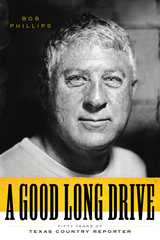 A Good Long Drive: Fifty Years of Texas Country Reporter
Bob Phillips
University of Texas Press, 2021 In 2021, Texas Country Reporter celebrates its fiftieth season on the air. Broadcast every week on stations across Texas, it focuses on “ordinary people doing extraordinary things.” And at the center of it is Bob Phillips, the show’s creator and host—an erstwhile poor kid from Dallas who ended up with a job that allowed him to rub elbows with sports figures, entertainers, and politicians but who preferred to spend his time on the back roads, listening to less-famous Texans tell their stories. In this memoir, Phillips tells his own story, from his early days as a reporter and his initial pitch for the show while a student at SMU to his ongoing work at the longest-running independently produced TV show in American television history. As we travel with Phillips on his journey, we meet Willie Nelson and former Dallas Cowboys coach Tom Landry; reflect on memorable, unusual, and challenging show segments; experience the behind-the-scenes drama that goes on in local television; witness the launching of an annual festival; and discover the unbelievable allure of Texas, its culture, and, especially, its people. Spanning generations, A Good Long Drive is proof that life’s journey really is a destination unto itself.
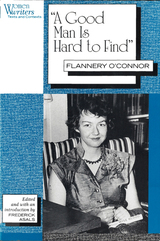 "A Good Man is Hard to Find": Flannery O'Connor
Asals, Frederick
Rutgers University Press, 1993 "A Good Man Is Hard to Find" is Flannery O'Connor's most famous and most discussed story. O'Connor herself singled it out by making it the title piece of her first collection and the story she most often chose for readings or talks to students. It is an unforgettable tale, both riveting and comic, of the confrontation of a family with violence and sudden death. More than anything else O'Connor ever wrote, this story mixes the comedy, violence, and religious concerns that characterize her fiction. This casebook for the story includes an introduction by the editor, a chronology of the author's life, the authoritative text of the story itself, comments and letters by O'Connor about the story, critical essays, and a bibliography. The critical essays span more than twenty years of commentary and suggest several approaches to the story--formalistic, thematic, deconstructionist-- all within the grasp of the undergraduate, while the introduction also points interested students toward still other resources. Useful for both beginning and advanced students, this casebook provides an in-depth introduction to one of America's most gifted modern writers.
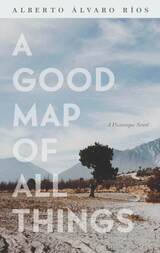 A Good Map of All Things: A Picaresque Novel
Alberto Álvaro Ríos
University of Arizona Press, 2020 In Alberto Álvaro Ríos’s new picaresque novel, momentous adventure and quiet connection brings twenty people to life in a small town in northern Mexico. A Good Map of All Things is home to characters whose lives are interwoven but whose stories are their own, adding warmth and humor to this continually surprising communal narrative. The stories take place in the mid-twentieth century, in the high desert near the border—a stretch of land generally referred to as the Pimería Alta—an ancient passage through the desert that connected the territory of Tucson in the north and Guaymas and Hermosillo in the south. The United States is off in the distance, a little difficult to see, and, in the middle of the century, not the only thing to think about. Mexico City is somewhere to the south, but nobody can say where and nobody has ever seen it. Ríos has created a whimsical yet familiar town, where brightly unique characters love fiercely and nurture those around them. The people in A Good Map of All Things have secrets and fears, successes and happiness, winters and summers. They are people who do not make the news, but who are living their lives for the long haul, without lotteries or easy answers or particular luck. Theirs is the everyday, with its small but meaningful joy. Whether your heart belongs to a small town in Mexico or a bustling metropolis, Alberto Álvaro Ríos has crafted a book that is overflowing with comfort, warmth, and the familiar embrace of a tightly woven community.
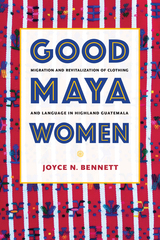 Good Maya Women: Migration and Revitalization of Clothing and Language in Highland Guatemala
by Joyce N. Bennett
University of Alabama Press, 2022 Analyzes the forced migration of Maya women from highland Guatemala and their turn toward language and Indigenous clothing in their homeland
Good Maya Women: Migration and Revitalization of Clothing and Language in Highland Guatemala analyzes how Indigenous women’s migration contributes to women’s empowerment in their home communities in Guatemala. This decolonial ethnographic analysis of Kaqchikel Maya women’s linguistic and cultural activism demonstrates that marginalized people can and do experience empowerment and hope for the future of their communities, even while living under oppressive neoliberal regimes. Joyce N. Bennett contests dominant frameworks of affect theory holding that marginalized peoples never truly experience unrestricted hope or empowerment, and she contributes new understandings of the intimate connections between Indigenous women, migration, and language and clothing revitalization.
Based on more than twenty months of fieldwork, the study begins with an ethnographic investigation of how economic policies force Indigenous women into migration for wage work. To survive, many, like the three young women profiled in this ethnography, are forced to leave their schooling, families, and highland homes to work in cities or other countries. They might work, for example, as vendors, selling crafts to tourists, or as housekeepers or waitresses. Their work exposes them to structural violence, including anti-Indigenous slurs, sexual harassment and violence, and robbery.
Furthermore, the women are pressured to wear Western clothing and to speak Spanish, which endangers Indigenous culture and language in Guatemala. Yet the Indigenous migrant women profiled do not abandon their Indigenous clothing and language, in this case Kaqchikel Maya. Instead, they find inspiration and pride in revitalizing Kaqchikel traditions in their hometowns post-migration. As women attempt to revitalize Kaqchikel Maya language and clothing, they seek to earn the title of “good” women in their home communities.
Unpacking women’s daily activisms reveals that women attempt to retain their language and clothing and also collectively seek to make space for Indigenous people in the modern world. Bennett reveals that women find their attempts at revitalization to be personally empowering, even when their communities do not support them.
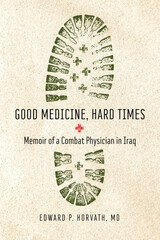 Good Medicine, Hard Times: Memoir of a Combat Physician in Iraq
Edward P. Horvath, MD
Ohio State University Press, 2022 Good Medicine, Hard Times is the moving memoir of one of the most senior-ranking combat physicians to have served on the battlefields of the second Iraq war. Former US Army Colonel Edward P. Horvath, MD, brings readers through the intricacies of war as he relates stories of working to save the lives of soldiers, enemies, and civilians alike and shares the moral dilemmas faced by medical professionals during war. Enlisting in the Army as a fifty-nine-year-old physician, Dr. Horvath knew that he had a greater calling in life: to save the “neighbor’s kid”—no matter who that neighbor or the kid might be. Over his three deployments, he strived to do that amid cultural clashes, insurgent attacks, military controversy, and the suffering of children caught in the crossfire. In his clear-eyed, empathetic, and unforgettable account, he shows what it means to provide compassionate care in the most trying of circumstances, always keeping in mind that every person he cares for is someone’s child.
 The Good Men Who Won the War: Army of the Cumberland Veterans and Emancipation Memory
Robert E. Hunt
University of Alabama Press, 2010 Examines how Union veterans of the Army of the Cumberland employed the extinction of slavery in the trans-Appalachian South in their memory of the Civil War
Robert Hunt examines how Union veterans of the Army of the Cumberland employed the extinction of slavery in the trans-Appalachian South in their memory of the Civil War. Hunt argues that rather than ignoring or belittling emancipation, it became central to veterans’ retrospective understanding of what the war, and their service in it, was all about. The Army of the Cumberland is particularly useful as a subject for this examination because it invaded the South deeply, encountering numerous ex-slaves as fugitives, refugees, laborers on military projects, and new recruits. At the same time, the Cumberlanders were mostly Illinoisans, Ohioans, Indianans, and, significantly, Kentucky Unionists, all from areas suspicious of abolition before the war.
Hunt argues that the collapse of slavery in the trans-Appalachian theater of the Civil War can be usefully understood by exploring the post-war memories of this group of Union veterans. He contends that rather than remembering the war as a crusade against the evils of slavery, the veterans of the Army of the Cumberland saw the end of slavery as a by-product of the necessary defeat of the planter aristocracy that had sundered the Union; a good and necessary outcome, but not necessarily an assertion of equality between the races.
Some of the most provocative discussions about the Civil War in current scholarship are concerned with how memory of the war was used by both the North and the South in Reconstruction, redeemer politics, the imposition of segregation, and the Spanish-American War. This work demonstrates that both the collapse of slavery and the economic and social post-War experience convinced these veterans that they had participated in the construction of the United States as a world power, built on the victory won against corrupt Southern plutocrats who had impeded the rightful development of the country.
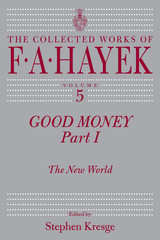 Good Money, Part 1: The New World
F. A. Hayek
University of Chicago Press, 1999 The two volumes of Good Money concentrate on Hayek's work on money and monetary policy. Published in the centenary of his birth, these volumes bring forth some of the economist's most distinguished articles on monetary policy and offer another vital addition to the collection of Hayek's life work.
Good Money, Part I: The New World includes seven of Hayek's articles from the 1920s that were written largely in reaction to the work of Irving Fisher and W. C. Mitchell. Hayek encountered Fisher's work on the quantity theory of money and Mitchell's studies on business cycles during a U.S. visit in 1923-24. These articles attack the idea that price stabilization was consistent with the stabilization of foreign exchange and foreshadow Hayek's general critique that the whole of an economy is not simply the sum of its parts.
Good Money, Part II: The Standard offers five more of Hayek's articles that advance his ideas about money. In these essays, Hayek investigates the consequences of the "predicament of composition." This principle works on the premise that the entire society cannot simultaneously increase liquidity by selling property or services for cash. This analysis led Hayek to make what was perhaps his most controversial proposal: that governments should be denied a monopoly on the coining of money.
Taken together, these volumes present a comprehensive chronicle of Hayek's writings on monetary policy and offer readers an invaluable reference to some of his most profound thoughts about money.
"Each new addition to The Collected Works of F. A. Hayek, the University of Chicago's painstaking series of reissues and collections, is a gem."— Liberty on Volume IX of The Collected Works of F. A. Hayek
"Intellectually [Hayek] towers like a giant oak in a forest of saplings."—Chicago Tribune
"One of the great thinkers of our age who . . . revolutionized the world's intellectual and political life."—Former President George Herbert Walker Bush
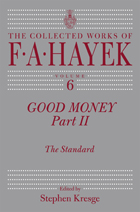 Good Money, Part 2: The Standard
F. A. Hayek
University of Chicago Press, 1999 The two volumes of Good Money concentrate on Hayek's work on money and monetary policy. Published in the centenary of his birth, these volumes bring forth some of the economist's most distinguished articles on monetary policy and offer another vital addition to the collection of Hayek's life work.
Good Money, Part I: The New World includes seven of Hayek's articles from the 1920s that were written largely in reaction to the work of Irving Fisher and W. C. Mitchell. Hayek encountered Fisher's work on the quantity theory of money and Mitchell's studies on business cycles during a U.S. visit in 1923-24. These articles attack the idea that price stabilization was consistent with the stabilization of foreign exchange and foreshadow Hayek's general critique that the whole of an economy is not simply the sum of its parts.
Good Money, Part II: The Standard offers five more of Hayek's articles that advance his ideas about money. In these essays, Hayek investigates the consequences of the "predicament of composition." This principle works on the premise that the entire society cannot simultaneously increase liquidity by selling property or services for cash. This analysis led Hayek to make what was perhaps his most controversial proposal: that governments should be denied a monopoly on the coining of money.
Taken together, these volumes present a comprehensive chronicle of Hayek's writings on monetary policy and offer readers an invaluable reference to some of his most profound thoughts about money.
"Each new addition to The Collected Works of F. A. Hayek, the University of Chicago's painstaking series of reissues and collections, is a gem."— Liberty on Volume IX of The Collected Works of F. A. Hayek
"Intellectually [Hayek] towers like a giant oak in a forest of saplings."—Chicago Tribune
"One of the great thinkers of our age who . . . revolutionized the world's intellectual and political life."—Former President George Herbert Walker Bush
Good Morning and Good Night
David Wagoner
University of Illinois Press, 2005 By continually discovering what's new in each day without forgetting yesterday's surprises, David Wagoner has succeeded in constantly expanding his range in a career that spans more than fifty years. In Good Morning and Good Night, this range includes his usual rich forays into nature and personalities, and poetry for all ages, young and old, amidst a vivid array of memories and explorations. Readers will find homages to the poets that have inspired him, as well as the bountiful lyricism that has made Wagoner's poetry one of our most enduring sources of delight and joy.
Good Morning and Good Night features poems previously published in American Poetry Review, The American Scholar, Atlantic Monthly, Hudson Review, The Kenyon Review, New Letters, The New Republic, Poetry, Shenandoah, Southern Review, The Yale Review, and other leading literary journals.
Good Morning Blues: The Autobiography of Count Basie
Count Basie
University of Minnesota Press, 2016 Count Basie was one of America’s pre-eminent and influential jazz pianists, bandleaders, and composers, known for such classics as “Jumpin’ at the Woodside,” “Goin’ to Chicago Blues,” “Sent for You Yesterday and Here You Come Today,” and “One O’Clock Jump.” In Good Morning Blues, Basie recounts his life story to Albert Murray, from his childhood years playing ragtime with his own pickup band at dances and pig roasts, to his years in New York City in search of opportunity, to rollicking anecdotes of Basie’s encounters with Fats Waller, Frank Sinatra, Fred Astaire, Sammy Davis Jr., Quincy Jones, Billie Holliday, and Tony Bennett. In this classic of jazz autobiography that was ten years in the making, Albert Murray brings the voice of Count Basie to the printed page in what is both testimony and tribute to an incredibly rich life.
 Good Morning, Shakur!: A Shakur Series Board Book
Andrea Sonnier
Gallaudet University Press, 2024 From brushing his teeth to picking out his clothes, Shakur guides young readers through a cheerful and instructive morning routine. As Shakur remembers to do his morning activities, he engages in important decision-making. His mom helps him consider the weather to choose the perfect outfit and presents him with healthy breakfast options. This board book not only mirrors the familiar activities of a child’s morning but also reinforces the importance of having a routine and making good choices.
About the Shakur Series:
The Shakur Series features Black deaf characters who use American Sign Language, offering a unique and inclusive reading experience for children. The vibrant illustrations showcase a signing family and will captivate young minds, while the engaging text reinforces learning. These charming board books contain positive messages and practical lessons, support early childhood development, and encourage children to explore the world with Shakur. This series honors and celebrates Black deaf experiences through everyday adventures that will resonate with young children and their families.
Published in partnership with The Laurent Clerc National Deaf Education Center.
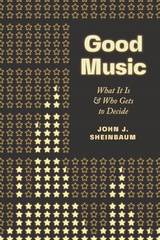 Good Music: What It Is and Who Gets to Decide
John J. Sheinbaum
University of Chicago Press, 2018 Over the past two centuries Western culture has largely valorized a particular kind of “good” music—highly serious, wondrously deep, stylistically authentic, heroically created, and strikingly original—and, at the same time, has marginalized music that does not live up to those ideals.
In Good Music, John J. Sheinbaum explores these traditional models for valuing music. By engaging examples such as Handel oratorios, Beethoven and Mahler symphonies, jazz improvisations, Bruce Springsteen, and prog rock, he argues that metaphors of perfection do justice to neither the perceived strengths nor the assumed weaknesses of the music in question. Instead, he proposes an alternative model of appreciation where abstract notions of virtue need not dictate our understanding. Good music can, with pride, be playful rather than serious, diverse rather than unified, engaging to both body and mind, in dialogue with manifold styles and genres, and collaborative to the core. We can widen the scope of what music we value and reconsider the conventional rituals surrounding it, while retaining the joys of making music, listening closely, and caring passionately.
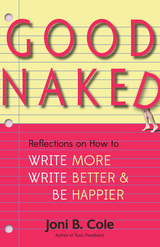 Good Naked: Reflections on How to Write More, Write Better, and Be Happier
Joni B. Cole
University Press of New England, 2017 In Good Naked, acclaimed author Joni B. Cole shows readers how to make the writing process not only more productive, but less maddening, more inviting, and even joyful, at least a good part of the time. She explains how sharing early drafts is “good naked”—you’re exposing your creative process in all its glory. Through a mix of engaging stories and practical wisdom, all delivered with sheer good humor, Cole addresses the most common challenges writers confront and offers disarmingly simple but effective solutions. She debunks popular misconceptions about how we are supposed to write and replaces them with strategies that actually work to get us started and stay motivated. (Searching for your muse? Try looking in the fridge.) With a do-this-not-that directness, she sets writers free from debilitating attitudes, counterproductive practices, and energy-draining habits that undermine confidence and creativity. Equipped with experience and a refreshing respect for anyone who wants to write, Cole also infuses every chapter with insights into craft and narrative technique—because the truly happy ending is not just that we write more, but that we write well. If you have ever experienced a sense of dread or intimidation at any stage of the creative process, or even if you simply want to write more, write better, and be happier, this intelligent, funny, and generous guide will not only inspire you to head over to your desk, but will also cheer you on once you’re there.
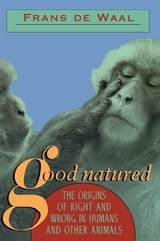 Good Natured: The Origins of Right and Wrong in Humans and Other Animals
Frans B. M. de Waal
Harvard University Press, 1996 To observe a dog's guilty look.
to witness a gorilla's self-sacrifice for a wounded mate, to watch an elephant herd's communal effort on behalf of a stranded calf--to catch animals in certain acts is to wonder what moves them. Might there he a code of ethics in the animal kingdom? Must an animal be human to he humane? In this provocative book, a renowned scientist takes on those who have declared ethics uniquely human Making a compelling case for a morality grounded in biology, he shows how ethical behavior is as much a matter of evolution as any other trait, in humans and animals alike.
World famous for his brilliant descriptions of Machiavellian power plays among chimpanzees-the nastier side of animal life--Frans de Waal here contends that animals have a nice side as well. Making his case through vivid anecdotes drawn from his work with apes and monkeys and holstered by the intriguing, voluminous data from his and others' ongoing research, de Waal shows us that many of the building blocks of morality are natural: they can he observed in other animals. Through his eyes, we see how not just primates but all kinds of animals, from marine mammals to dogs, respond to social rules, help each other, share food, resolve conflict to mutual satisfaction, even develop a crude sense of justice and fairness.
Natural selection may be harsh, but it has produced highly successful species that survive through cooperation and mutual assistance. De Waal identifies this paradox as the key to an evolutionary account of morality, and demonstrates that human morality could never have developed without the foundation of fellow feeling our species shares with other animals. As his work makes clear, a morality grounded in biology leads to an entirely different conception of what it means to he human--and humane.
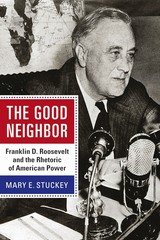 The Good Neighbor: Franklin D. Roosevelt and the Rhetoric of American Power
Mary E. Stuckey
Michigan State University Press, 2013 No modern president has had as much influence on American national politics as Franklin D. Roosevelt. During FDR’s administration, power shifted from states and localities to the federal government; within the federal government it shifted from Congress to the president; and internationally, it moved from Europe to the United States. All of these changes required significant effort on the part of the president, who triumphed over fierce opposition and succeeded in remaking the American political system in ways that continue to shape our politics today. Using the metaphor of the good neighbor, Mary E. Stuckey examines the persuasive work that took place to authorize these changes. Through the metaphor, FDR’s administration can be better understood: his emphasis on communal values; the importance of national mobilization in domestic as well as foreign affairs in defense of those values; his use of what he considered a particularly democratic approach to public communication; his treatment of friends and his delineation of enemies; and finally, the ways in which he used this rhetoric to broaden his neighborhood from the limits of the United States to encompass the entire world, laying the groundwork for American ideological dominance in the post–World War II era.
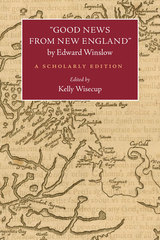 "Good News from New England" by Edward Winslow: A Scholarly Edition
Kelly Wisecup
University of Massachusetts Press, 2014 First published in 1624, Edward Winslow's Good News from New England chronicles the early experience of the Plimoth colonists, or Pilgrims, in the New World. For several years Winslow acted as the Pilgrims' primary negotiator with New England Algonquians, including the Wampanoag, Massachusett, and Narragansett Indians. During this period he was credited with having cured the Wampanoag sachem Massasoit, one of the colonists' most valuable allies, of an apparently life-threatening illness, and he also served as the Pilgrims' chief agent in England.
It was in the context of all of these roles that Winslow wrote Good News in an attempt to convince supporters in England that the colonists had established friendly relations with Native groups and, as a result, gained access to trade goods. Although clearly a work of diplomacy, masking as it did incidents of brutal violence against Indians as well as evidence of mutual mistrust, the work nevertheless offers, according to Kelly Wisecup, a more complicated and nuanced representation of the Pilgrims' first years in New England and of their relationship with Native Americans than other primary documents of the period.
In this scholarly edition, Wisecup supplements Good News with an introduction, additional primary texts, and annotations to bring to light multiple perspectives, including those of the first European travelers to the area, Native captives who traveled to London and shaped Algonquian responses to colonists, the survivors of epidemics that struck New England between 1616 and 1619, and the witnesses of the colonists' attack on the Massachusetts.
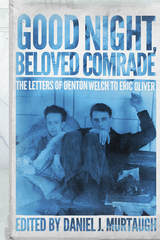 Good Night, Beloved Comrade: The Letters of Denton Welch to Eric Oliver
Edited and with an introduction by Daniel J. Murtaugh
University of Wisconsin Press, 2017 Denton Welch (1915–48) died at the age of thirty-three after a brief but brilliant career as a writer and painter. The revealing, poignant, impressionistic voice that buoys his novels was much praised by critics and literati in England and has since inspired creative artists from William S. Burroughs to John Waters. His achievements were all the more remarkable because he suffered from debilitating spinal and pelvic injuries incurred in a bicycle accident at age eighteen.
Though German bombs were ravaging Britain, Welch wrote in his published work about the idyllic landscapes and local people he observed in Kent. There, in 1943, he met and fell in love with Eric Oliver, a handsome, intelligent, but rather insecure "landboy"—an agricultural worker with the wartime Land Army. Oliver would become a companion, comrade, lover, and caretaker during the last six years of Welch's life. All fifty-one letters that Welch wrote to Oliver are collected and annotated here for the first time. They offer a historical record of life amidst the hardship, deprivation, and fear of World War II, and also are a timeless testament of one young man's tender and intimate emotions, his immense courage in adversity, and his continual struggle for love and creative existence.
 Good Night, Shakur!: A Shakur Series Board Book
Andrea Sonnier
Gallaudet University Press, 2024 This cozy bedtime story is filled with hugs and kisses, bathtime fun, and gentle encouragements towards establishing a nighttime routine. Shakur begins by saying good night to his family. Then Dad prepares a bubble bath where Shakur enjoys some playful moments. Afterward, Shakur puts on his pajamas and brushes his teeth. They finish with a story — but Shakur isn’t quite ready to sleep. He tries all sorts of things to stay awake, but Dad emphasizes the importance of bedtime. Finally, with his favorite stuffed animal beside him, Shakur drifts off to sleep.
About the Shakur Series:
The Shakur Series features Black deaf characters who use American Sign Language, offering a unique and inclusive reading experience for children. The vibrant illustrations showcase a signing family and will captivate young minds, while the engaging text reinforces learning. These charming board books contain positive messages and practical lessons, support early childhood development, and encourage children to explore the world with Shakur. This series honors and celebrates Black deaf experiences through everyday adventures that will resonate with young children and their families.
Published in partnership with The Laurent Clerc National Deaf Education Center.
Good night the pleasure was ours
David Grubbs
Duke University Press, 2022 With Good night the pleasure was ours, David Grubbs melts down and recasts three decades of playing music on tour into a book-length poem, bringing to a close the trilogy that includes Now that the audience is assembled and The Voice in the Headphones. In Good night the pleasure was ours, the world outside the tour filters in with eccentric sparseness. From teenage punk bands to ensembles without fixed membership, and from solo performance to a group augmented by digital avatars, Grubbs presents touring as a series of daily dislocations that provides an education distinctly its own. These musicians’ job is to play that evening’s gig—whether to enthusiastic, hostile, or apathetic audiences—and then to do it again the next day. And yet, over the course of the book’s multidecade arc, Grubbs depicts music making as an irreversible process—one reason for loving it so.
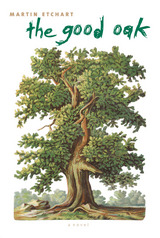 The Good Oak
Martin Etchart
University of Nevada Press, 2005 Thirteen-year-old Matt Echbar is angry at the world. His widowed father is too busy for him, and his grandfather is an embarrassment, an unschooled Basque shepherd whose language and customs are completely alien to Matt’s all-American lifestyle. Things get worse when the grandfather steals a flock of sheep and dragoons Matt into helping him drive them to a secret camp in the Arizona mountains. The ensuing adventure is one of the most compelling and delightful coming-of-age novels in recent fiction. As Matt and his aitatxi, accompanied by their two faithful sheepdogs, drive the flock across the burgeoning suburbs of Phoenix and into the remote mountains, the boy learns the ancient skills of the sheepherder and discovers the unexpected wisdom that has given his Old Country grandfather the strength and patience of a sturdy oak. By the time the journey reaches its fateful conclusion, Matt has developed a new bond with the old man and has learned that true manhood includes accepting one’s heritage.
 The Good Occupation: American Soldiers and the Hazards of Peace
Susan L. Carruthers
Harvard University Press, 2016 Waged for a just cause and culminating in total victory, World War II was America’s “good war.” Yet for millions of GIs overseas, the war did not end with Germany and Japan’s surrender. The Good Occupation chronicles America’s transition from wartime combatant to postwar occupier, by exploring the intimate thoughts and feelings of the ordinary servicemen and women who participated—often reluctantly—in the difficult project of rebuilding nations they had so recently worked to destroy.
When the war ended, most of the seven million Americans in uniform longed to return to civilian life. Yet many remained on active duty, becoming the “after-army” tasked with bringing order and justice to societies ravaged by war. Susan Carruthers shows how American soldiers struggled to deal with unprecedented catastrophe among millions of displaced refugees and concentration camp survivors while negotiating the inevitable tensions that arose between victors and the defeated enemy. Drawing on thousands of unpublished letters, diaries, and memoirs, she reveals the stories service personnel told themselves and their loved ones back home in order to make sense of their disorienting and challenging postwar mission.
The picture Carruthers paints is not the one most Americans recognize today. A venture undertaken by soldiers with little appetite for the task has crystallized, in the retelling, into the “good occupation” of national mythology: emblematic of the United States’ role as a bearer of democracy, progress, and prosperity. In real time, however, “winning the peace” proved a perilous business, fraught with temptation and hazard.
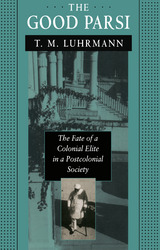 The Good Parsi: The Fate of a Colonial Elite in a Postcolonial Society
T. M. Luhrmann
Harvard University Press, 1996 During the Raj, one group stands out as having prospered and thrived because of British rule: the Parsis. Driven out of Persia into India a thousand years ago, the Zoroastrian people adopted the manners, dress, and aspirations of their British colonizers, and their Anglophilic activities ranged from cricket to Oxford to tea. The British were fulsome in their praise of the Parsis and rewarded them with high-level financial, mercantile, and bureaucratic posts. The Parsis dominated Bombay for more than a century. But Indian independence ushered in their decline. Tanya Luhrmann vividly portrays a crisis of confidence, of self-criticism, and perpetual agonizing.
This story highlights the dilemmas and paradoxes of all who danced the colonial tango. Luhrmann's analysis brings startling insights into a whole range of communal and individual identity crises and what could be called "identity politics" of this century. In a candid last chapter the author confronts another elite in crisis: an anthropology in flux, uncertain of its own authority and its relation to the colonizers.
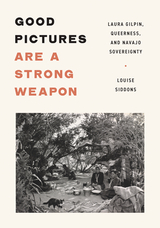 Good Pictures Are a Strong Weapon: Laura Gilpin, Queerness, and Navajo Sovereignty
Louise Siddons
University of Minnesota Press, 2024 What are the limits of political solidarity, and how can visual culture contribute to social change? A fundamental dilemma exists in documentary photography: can white artists successfully portray Indigenous lives and communities in a manner that neither appropriates nor romanticizes them? With an attentive and sensitive eye, Louise Siddons examines lesbian photographer Laura Gilpin’s classic 1968 book The Enduring Navaho to illuminate the intersectional politics of photography, Navajo sovereignty, and queerness over the course of the twentieth century. Gilpin was a New York–trained fine arts photographer who started working with Navajo people when her partner accepted a job as a nurse in Arizona. She spent more than three decades documenting Navajo life and creating her book in collaboration with Navajo friends and colleagues. Framing her lesbian identity and her long relationship with the Navajo people around questions of allyship, Good Pictures Are a Strong Weapon addresses the long and problematic history of White photographers capturing images of Native life. Simultaneously, Siddons uses Gilpin’s work to explore the limitations of White advocacy in a political moment that emphasized the need for Indigenous visibility and voices. Good Pictures Are a Strong Weapon introduces contemporary Diné (Navajo) artists as interlocutors, critics, and activists whose work embodies and extends the cultural sovereignty politics of earlier generations and makes visible the queerness often left implicit in Gilpin’s photographs. Siddons puts their work in conversation with Gilpin’s, taking up her mandate to viewers and readers of The Enduring Navajo to address Navajo aesthetics, traditions, politics, and people on their own terms. Retail e-book files for this title are screen-reader friendly with images accompanied by short alt text and/or extended descriptions.
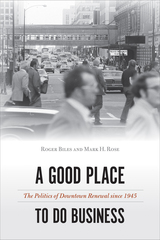 A Good Place to Do Business: The Politics of Downtown Renewal since 1945
Roger Biles and Mark H. Rose
Temple University Press, 2022 The “Pittsburgh Renaissance,” an urban renewal effort launched in the late 1940s, transformed the smoky rust belt city’s downtown. Working-class residents and people of color saw their neighborhoods cleared and replaced with upscale, white residents and with large corporations housed in massive skyscrapers. Pittsburgh’s Renaissance’s apparent success quickly became a model for several struggling industrial cities, including St. Louis, Cleveland, Detroit, Chicago, and Philadelphia. In A Good Place to Do Business, Roger Biles and Mark Rose chronicle these urban “makeovers” which promised increased tourism and fashionable shopping as well as the development of sports stadiums, convention centers, downtown parks, and more. They examine the politics of these government-funded redevelopment programs and show how city politics (and policymakers) often dictated the level of success. As city officials and business elites determined to reorganize their downtowns, a deeply racialized politics sacrificed neighborhoods and the livelihoods of those pushed out. Yet, as A Good Place to Do Business demonstrates, more often than not, costly efforts to bring about the hoped-for improvements failed to revitalize those cities, or even their downtowns.
“A Good Poor Man’s Wife”: Being a Chronicle of Harriet Hanson Robinson and Her Family in Nineteenth-Century New England
Claudia L. Bushman
University Press of New England, 1998 A shrewd observer of 19th-century America, Harriet Hanson Robinson’s participation in important events and her salty comments, preserved and recorded in the poetry and books she wrote during her lifetime, offer a dramatic account of how one strong-minded woman, who first worked as a textile worker in the industrial town of Lowell, MA, turned to writing and politics to sustain her family after her husband’s early death. Harriet’s personal papers shed light on such topics as labor history, state politics, and the mechanics of writing and publication. Her best-known publications, Loom and Spindle, which deals with early factory life, and Massachusetts in the Woman Suffrage Movement, are often quoted today.
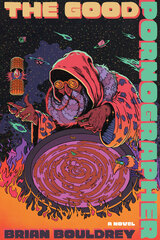 The Good Pornographer
Brian Bouldrey
University of Wisconsin Press, 2026 Walace Weiss, a famous fantasy novelist struggling with drug addiction, sets himself on a twofold quest: to finish his first book in more than a decade and, like the immortal elves of his stories, to try to remember what, in his long life, he should not have forgotten.
While many have come to view Walace as a bad influence on children, literature, and himself, his impact sweeps across worlds both fantastic and real, resulting in the establishment of a new kingdom in his neglected McMansion, Summerheim. The result is a mock-epic in rehabilitation, starring such friends and enemies as Cal, Walace’s dealer and private jester; Dragon, a porn star turned guidance counselor; Epiphany, a lunch lady and stripper in recovery; her son, Tuffy, planning everyone’s funerals at age nine; Jackal, newly sober and in touch with his emotions for the first time; and Wolf, Walace’s socially withdrawn twin brother and reluctant doppelgänger.
Brian Bouldrey piles on the laughs and absurdity alongside dollops of humanity and sobriety. With brilliant recklessness, he praises and pokes fun at genres, conventions, fandoms, and critics, offering a Deadpool-like exploration of an upside-down world filled with epic quests, epic mistakes, and epic characters.
 A Good Position for Birth: Pregnancy, Risk, and Development in Southern Belize
Aminata Maraesa
Vanderbilt University Press, 2018 In order to understand the local realities of health and development initiatives undertaken to reduce maternal and infant mortality, the author accompanied rural health nurses as they traveled to villages accessible only by foot over waterlogged terrain to set up mobile prenatal and well-child clinics. Through sustained interactions with pregnant women, midwives, traditional birth attendants, and bush doctors, Maraesa encountered reproductive beliefs and practices ranging from obeah pregnancy to 'nointing that compete with global health care workers' directives about risk, prenatal care, and hospital versus home birth.
Fear and shame are prominent affective tropes that Maraesa uses to understand women's attitudes toward reproduction that are at times contrary to development discourse but that make sense in the lived experiences of the women of southern Belize.
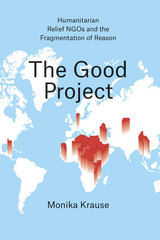 The Good Project: Humanitarian Relief NGOs and the Fragmentation of Reason
Monika Krause
University of Chicago Press, 2014 NGOs set out to save lives, relieve suffering, and service basic human needs. They are committed to serving people across national borders and without regard to race, ethnicity, gender, or religion, and they offer crucial help during earthquakes, tsunamis, wars, and pandemics. But with so many ailing areas in need of assistance, how do these organizations decide where to go—and who gets the aid?
In The Good Project, Monika Krause dives into the intricacies of the decision-making process at NGOs and uncovers a basic truth: It may be the case that relief agencies try to help people but, in practical terms, the main focus of their work is to produce projects. Agencies sell projects to key institutional donors, and in the process the project and its beneficiaries become commodities. In an effort to guarantee a successful project, organizations are incentivized to help those who are easy to help, while those who are hardest to help often receive no assistance at all. The poorest of the world are made to compete against each other to become projects—and in exchange they offer legitimacy to aid agencies and donor governments. Sure to be controversial, The Good Project offers a provocative new perspective on how NGOs succeed and fail on a local and global level.
 A Good Quarrel: America's Top Legal Reporters Share Stories from Inside the Supreme Court
Timothy R. Johnson and Jerry Goldman, Editors
University of Michigan Press, 2009 While reading what top legal reporters say about some of the most important U.S. Supreme Court oral arguments in recent history, go to www.goodquarrel.com to listen to audio and hear for yourself the very style and delivery of the oral arguments that have shaped the history of our nation's highest law. See Preface for full instructions. Contributors - Charles Bierbauer, CNN
- Lyle Denniston, scotusblog.com
- Fred Graham, Court TV
- Brent Kendall, Los Angeles Daily Journal
- Steve Lash, Houston Chronicle
- Dahlia Lithwick, Slate.com
- Tony Mauro, American Lawyer Media
- Tim O'Brien, ABC News
- David Savage, Los Angeles Times
- Greg Stohr, Bloomberg News
- Nina Totenberg, NPR
Timothy R. Johnson teaches in the Department of Political Science and the Law School at the University of Minnesota. Jerry Goldman teaches political science at Northwestern University and directs the OYEZ Project, a multimedia archive devoted to the Supreme Court, at www.oyez.org. Cover sketch by Dana Verkouteren "Supreme Court oral arguments are good government in action. A Good Quarrel brilliantly showcases this important aspect of the Court's work."
---Paul Clement, Partner, King & Spalding, and former United States Solicitor General "Few legal experiences are as exhilarating as a Supreme Court oral argument---a unique art form that this superb collection brings vividly to life."
---Kathleen Sullivan, Partner, Quinn Emanuel Urquhart Oliver and Hedges, and former Dean, Stanford Law School "[A Good Quarrel] shines a brilliant spotlight on the pivotal moment of advocacy when the Supreme Court confronts the nation's most profound legal questions."
---Thomas C. Goldstein, Partner, Akin Gump, and Lecturer, Supreme Court Litigation, Harvard Law School and Stanford Law School "A brilliant way to understand America's most important mysterious institution."
---Lawrence Lessig, Stanford Law School
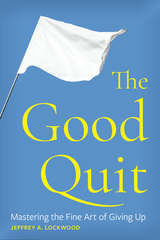 The Good Quit: Mastering the Fine Art of Giving Up
Jeffrey A. Lockwood
University of Wyoming Press, 2026 Quitting is a vital and pervasive phenomenon that shapes our lives. The Good Quit is an enlightening and provocative challenge to the common perceptions around the choice to quit. Rather than offering simplistic how-to advice, scientist-turned-philosopher Jeffrey A. Lockwood makes full use of biological, psychological, and social sciences to unpack what constitutes quitting for the right reasons, at the right time, and in the right way, using both fundamental principles and concrete examples. He explores the full range of ways in which quitting can occur in the human experience, including addictions, careers, diets, games, habits, jobs, politics, relationships, religions, sports, and wars.
Masterful quitting contributes to genuine success, but this practice nevertheless has been largely overlooked by scholars, teachers, coaches, and leaders. This book is a three-part exploration. In conceptual terms it asks, Is it really quitting if the decision is reversible, involuntary, or partial? In normative terms, it explores whether quitting must be well-reasoned, -timed, and -enacted to be justifiable. In applicable terms, it emphasizes phronesis, or “practical wisdom,” and contributes to the understanding that what constitutes quitting, and doing so well, is vital to making decisions about whether to persevere or abandon difficult ventures.
Flourishing is more complex than “grit-or-quit” advocates suggest. To thrive, we must come to know why, when, and how to quit. The Good Quit approaches this topic from an expansive and philosophical point of view, making it valuable for anyone contemplating the what, when, why, and how of quitting.
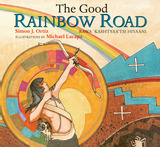 The Good Rainbow Road
Simon J. Ortiz; Illustrations by Michael Lacapa
University of Arizona Press, 2004 This is the story of two courageous boys and of how they saved their village. Their village is called Haapaahnitse, Oak Place, and it lies at the foot of a mountain. Once there was a lake and a stream nearby, but they have dried up. Once rain and snow came, but no more. Not only did the crops wither and die, even the hardy oak trees have become brittle sticks. The land has become barren and dry. Two brothers, Tsaiyah-dzehshi, whose name means First One, and Hamahshu-dzehshi, Next One, are chosen for an important mission. They are sent on a westward trek to the home of the Shiwana, the Rain and Snow Spirits, to ask them to bring the gift of water to the village again. The brothers cross deserts and mountains on an arduous journey until they are finally stopped short by a treacherous canyon filled with molten lava. The Good Rainbow Road tells how the brothers overcome this last challenge and continue on to their destination. Written in the tradition of Native American oral storytelling and accompanied by colorful illustrations from celebrated Native artist Michael Lacapa, it brings the powers of language, memory, and imagery to a tale that will captivate children ages seven and up. As Simon Ortiz writes, "The Good Rainbow Road is located in the Native American world, but it is not limited to that world. Even considering humankind's many ethnic and racial differences, we are all part of each other as people and the rest of all Creation, and our stories join us together." This is the foundation of The Good Rainbow Road, and on that road young readers will broaden their understanding of humanity's common bonds.
The Good Rainbow Road is presented in Keres, the language of Acoma Pueblo and six other Pueblo communities in New Mexico, and in English, with an additional Spanish translation in the back of the book.
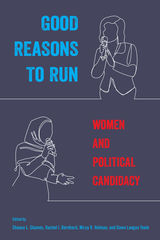 Good Reasons to Run: Women and Political Candidacy
Edited by Shauna L. Shames, Rachel I. Bernhard, Mirya R. Holman, and Dawn Langan Teele
Temple University Press, 2020 After the 2016 U.S. Presidential election, a large cohort of women emerged to run for office. Their efforts changed the landscape of candidates and representation. However, women are still far less likely than men to seek elective office, and face biases and obstacles in campaigns. (Women running for Congress make twice as many phone calls as men to raise the same contributions.) The editors and contributors to Good Reasons to Run, a mix of scholars and practitioners, examine the reasons why women run—and do not run—for political office. They focus on the opportunities, policies, and structures that promote women’s candidacies. How do nonprofits help recruit and finance women as candidates? And what role does money play in women’s campaigns? The essays in Good Reasons to Run ask not just who wants to run, but how to activate and encourage such ambition among a larger population of potential female candidates while also increasing the diversity of women running for office.
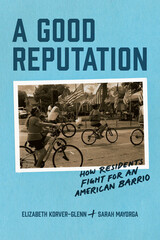 A Good Reputation: How Residents Fight for an American Barrio
Elizabeth Korver-Glenn and Sarah Mayorga
University of Chicago Press, 2024 A historic Houston barrio provides an illuminating lens on neighborhood reputation.
Neighborhoods have the power to form significant parts of our worlds and identities. A neighborhood’s reputation, however, doesn’t always match up to how residents see themselves or wish to be seen. The distance between residents’ desires and their environment can profoundly shape neighborhood life.
In A Good Reputation, sociologists Elizabeth Korver-Glenn and Sarah Mayorga delve into the development and transformation of the reputation of Northside, a predominantly Latinx barrio in Houston. Drawing on two years of ethnographic research and in-depth interviews with residents, developers, and other neighborhood stakeholders, the authors show that people’s perceptions of their neighborhoods are essential to understanding urban inequality and poverty. Korver-Glenn and Mayorga’s empirically detailed account of disputes over neighborhood reputation helps readers understand the complexity of high-poverty urban neighborhoods, demonstrating that gentrification is a more complicated and irregular process than existing accounts of urban inequality would suggest. Offering insightful theoretical analysis and compelling narrative threads from understudied communities, A Good Reputation will yield insights for scholars of race and ethnicity, urban planning, and beyond.
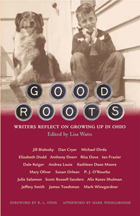 Good Roots: Writers Reflect on Growing Up in Ohio
Lisa Watts
Ohio University Press, 2007 Winner of the Ohioana Library’s 2008 Ohio Legacy Citation
2014-2015 Choose to Read Ohio selection “A good place to be from.” That’s how some people might characterize the Buckeye State. The writings in Good Roots: Writers Reflect on Growing Up in Ohio, are testimony to the truth of that statement. By prominent writers such as P. J. O’Rourke, Susan Orlean, and Alix Kates Shulman, these contributions are alternately nostalgic, irreverent, and sincere, and offer us a personal sense of place. Their childhoods are as varied as their work. Some were raised in urban Cleveland, Akron, and Cincinnati, others in the small Ohio towns that typify the Midwest, and still others in the countryside. Yet what they have to tell us about their roots resonates with a shared heritage, a sense of what is universal and enduring about growing up in the heartland.
Their collective résumé reads like a literary Who’s Who, including four Pulitzer Prizes, several National Book Awards, and many prestigious fellowships. Good Roots is also plain good reading from some of our country’s most accomplished contemporary writers.
Contributors include: Jill Bialosky, Dan Cryer, Michael Dirda, Elizabeth Dodd, Anthony Doerr, Rita Dove, Ian Frazier, Dale Keiger, Andrea Louie, Kathleen Dean Moore, Mary Oliver, Susan Orlean, P. J. O’Rourke, Julie Salamon, Scott Russell Sanders, Alix Kates Shulman, Jeffery Smith, James Toedtman, and Mark Winegardner.
 The Good Ruler: From Herbert Hoover to Richard Nixon
Kuklick, Bruce
Rutgers University Press, 1989 Which American presidents have been good? Which have been bad? Experts on the presidency have never been able to agree on their assessments. Bruce Kuklick suggests that historians and political scientists have approached the problem of defining successful leadership without adequately considering the essential factor. Instead of trying to evaluate which presidents set consistent and worthy policies and brought them to fruition, Kuklick asks us to pay more attention to how the American people feel about their presidents. The citizenry and its emotional responses are sued as the measure of a successful president, rather than the ostensibly rational appraisals of scholars. Applying this measure to the presidents from the Depression to Watergate, Kuklick begins by tracing the way in which Franklin Roosevelt established the parameters of the inspirational presidency and how his success shaped the study of political history. He then explores the triumphs of Eisenhower and Kennedy and contrasts these triumphs too the failures of Hoover, Truman, Johnson, and Nixon. The ability of leaders to win the respect and admiration of the citizenry is, for Kuklick, the crucial touchstone by which the success of a president is judged. To highlight this position that is not useful for historians to justify the merits or failures of a president by pointing out what he would have done had he lived longer or in a different era, Kiklick includes and entertaining and enlightening fable, an imaginary view of historical events: Nixon is elected in 1960, giving a youthful tone to the White House until his assassination in 1967; Kennedy is elected in 1968 but resigns after he is accused of misconduct. The fable demonstrates that the specific events are less important than a president’s ability to evoke a positive emotional response from the citizenry. The Good Ruler analyzes our recent political history without partisan bias and examines the basic premises of American democratic politics.
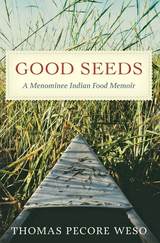 Good Seeds: A Menominee Indian Food Memoir
Thomas Pecore Weso
Wisconsin Historical Society Press, 2016 In this food memoir, named for the manoomin or wild rice that also gives the Menominee tribe its name, tribal member Thomas Pecore Weso takes readers on a cook’s journey through Wisconsin’s northern woods. He connects each food—beaver, trout, blackberry, wild rice, maple sugar, partridge—with colorful individuals who taught him Indigenous values. Cooks will learn from his authentic recipes. Amateur and professional historians will appreciate firsthand stories about reservation life during the mid-twentieth century, when many elders, fluent in the Algonquian language, practiced the old ways. Weso’s grandfather Moon was considered a medicine man, and his morning prayers were the foundation for all the day’s meals. Weso’s grandmother Jennie "made fire" each morning in a wood-burning stove, and oversaw huge breakfasts of wild game, fish, and fruit pies. As Weso grew up, his uncles taught him to hunt bear, deer, squirrels, raccoons, and even skunks for the daily larder. He remembers foods served at the Menominee fair and the excitement of "sugar bush," maple sugar gatherings that included dances as well as hard work. Weso uses humor to tell his own story as a boy learning to thrive in a land of icy winters and summer swamps. With his rare perspective as a Native anthropologist and artist, he tells a poignant personal story in this unique book.
Good Sex: Feminist Perspectives from the World's Religions
Jung, Patricia Beattie
Rutgers University Press, 2000 What is "good sex" in the globalized world of the twenty-first century? This volume brings together essays by feminist scholars from different religions and cultures to consider how women are redefining sexuality for the common good. The essays explore sexual and social restrictions on women; religiously and socially acceptable avenues of sexual expression; constructions of sexual identities; and attitudes toward women's sexual desires. How is sexual desire constructed within specific cultural and religious contexts? What sacrifices must women make (and how do they make them) simply to have sexual lives? What options and strategies are available to women to dissolve the many restrictions imposed on their sexuality? These are some of the questions being explored.
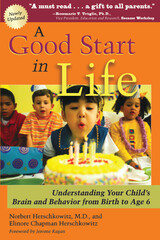 A Good Start in Life: Understanding Your Child's Brain and Behavior
Norbert Herschkowitz, MD and Elinore Chapman Herschkowitz
Dana Press, 2004 The social and cognitive development of children is a complex yet crucial process for parents to understand, and though there are numerous books on child development, A Good Start in Life stands out from the rest as an acclaimed and important work on the connections between childhood brain and behavioral development.
This new paperback edition, updated with the latest information and new material, offers parents and educators a rich and invaluable resource on how children learn to live in family and society from birth to age six. Norbert Herschkowitz, MD, and his wife Elinore Chapman Herschkowitz draw on their lifetime of experience in studying infants and children to explain how brain development shapes a child’s personality and behavior. Organizing their narrative by age, the authors examine a wide range of social development issues, from appropriate rule-setting to the development of key character elements in a child such as moral sensibility, temperament, language development, playing, aggression, impulse control, and empathy.
Some of the most popular features of the hardcover edition are retained here, including the question-and-answer section that concludes each chapter with real questions posed by parents to Dr. Herschkowitz, as well as brain maps and charts that display milestones in the development of various skills. Additional new material addresses concerns about prematurely born babies and the issue of resilience in children.
In today’s world, children grow up in an incredibly complex and highly sensory environment. A Good Start in Life offers a clear, concise, and richly detailed guide infused with warmth and encouragement that enables parents and educators to constructively stimulate and shape their children’s cognitive and social development.
“A must read . . . a gift to all parents.”—Rosemarie T. Truglio, vice-president, Education and Research, Sesame Workshop
“Do the first three years of life represent a critical period for all aspects of development? Are we the product of our genes or of our environment? Does early exposure to Mozart make for smarter babies? The answers to these and other pressing questions are skillfully and elegantly answered in this wonderful book, which I enthusiastically recommend.”
—Charles A. Nelson, Distinguished McKnight University Professor of Child Psychology, Neuroscience, and Pediatrics, University of Minnesota
“This delightfully written book . . . is not merely a how-to book, but a book about understanding how a child truly grows.”
—Guy McKhann, MD, The Johns Hopkins School of Medicine
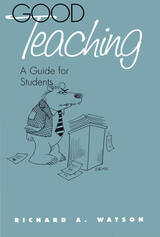 Good Teaching: A Guide for Students
Richard A. Watson
Southern Illinois University Press, 1997
From junior college to Ivy League university, the level of teaching ranges from "great to awful," according to Richard A. Watson, who explains not only how to survive but how to profit from and enjoy your college experience.
To help students make important personal choices—what school? what major? what classes?—Watson explains such broad areas as administrative structure, institutional goals, and faculty aspirations.
Charging the student with the ultimate responsibility for learning, Watson presents certain academic facts of life: teaching is not the primary concern of either the faculty or the administration in most institutions; few professors on the university level have had any training in teaching, and even fewer started out with teaching as their goal; senior professors do not teach much (the higher the rank and salary, the less time in the classroom), and those seeking tenure must emphasize research to survive; and almost certainly, the bad teacher who is a good researcher will get paid more than the good teacher who does not publish.
This is a book about good teaching and how to find it. Rejecting the conventional wisdom that a professor devoted to research will not be effective in the classroom, Watson advises that you take classes from the professor you may have been cautioned to avoid.
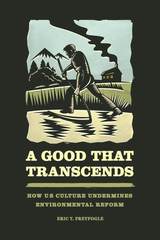 A Good That Transcends: How US Culture Undermines Environmental Reform
Eric T. Freyfogle
University of Chicago Press, 2017 Since the birth of the modern environmental movement in the 1970s, the United States has witnessed dramatic shifts in social equality, ecological viewpoints, and environmental policy. With these changes has also come an increased popular resistance to environmental reform, but, as Eric T. Freyfogle reveals in this book, that resistance has far deeper roots. Calling upon key environmental voices from the past and present—including Aldo Leopold, Wendell Berry, David Orr, and even Pope Francis in his Encyclical—and exploring core concepts like wilderness and the tragedy of the commons, A Good That Transcends not only unearths the causes of our embedded culture of resistance, but also offers a path forward to true, lasting environmental initiatives.
A lawyer by training, with expertise in property rights, Freyfogle uses his legal knowledge to demonstrate that bad land use practices are rooted in the way in which we see the natural world, value it, and understand our place within it. While social and economic factors are important components of our current predicament, it is our culture, he shows, that is driving the reform crisis—and in the face of accelerating environmental change, a change in culture is vital. Drawing upon a diverse array of disciplines from history and philosophy to the life sciences, economics, and literature, Freyfogle seeks better ways for humans to live in nature, helping us to rethink our relationship with the land and craft a new conservation ethic. By confronting our ongoing resistance to reform as well as pointing the way toward a common good, A Good That Transcends enables us to see how we might rise above institutional and cultural challenges, look at environmental problems, appreciate their severity, and both support and participate in reform.
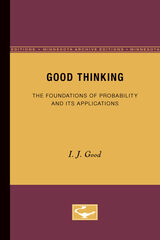 Good Thinking: The Foundations of Probability and Its Applications
I.J. Good
University of Minnesota Press, 1983
Good Thinking was first published in 1983.Good Thinking is a representative sampling of I. J. Good’s writing on a wide range of questions about the foundations of statistical inference, especially where induction intersects with philosophy. Good believes that clear reasoning about many important practical and philosophical questions is impossible except in terms of probability. This book collects from various published sources 23 of Good’s articles with an emphasis on more philosophical than mathematical.He covers such topics as rational decisions, randomness, operational research, measurement of knowledge, mathematical discovery, artificial intelligence, cognitive psychology, chess, and the nature of probability itself. In spite of the wide variety of topics covered, Good Thinking is based on a unified philosophy which makes it more than the sum of its parts. The papers are organized into five sections: Bayesian Rationality; Probability; Corroboration, Hypothesis Testing, and Simplicity; Information and Surprise; and Causality and Explanation. The numerous references, an extensive index, and a bibliography guide the reader to related modern and historic literature.This collection makes available to a wide audience, for the first time, the most accessible work of a very creative thinker. Philosophers of science, mathematicians, scientists, and, in Good’s words, anyone who wants “to understand understanding, to reason about reasoning, to explain explanation, to think about thought, and to decide how to decide” will find Good Thinking a stimulating and provocative look at probability.
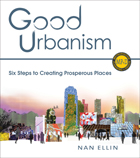 Good Urbanism: Six Steps to Creating Prosperous Places
Nan Ellin
Island Press, 2012 We all have a natural nesting instinct—we know what makes a good place. And a consensus has developed among urban planners and designers about the essential components of healthy, prosperous communities. So why aren’t these ideals being put into practice?
In Good Urbanism, Nan Ellin identifies the obstacles to creating thriving environments, and presents a six-step process to overcome them: prospect, polish, propose, prototype, promote, present. She argues that we need to reach beyond conventional planning to cultivate good ideas and leverage the resources to realize them.
Ellin illustrates the process with ten exemplary projects, from Envision Utah to Open Space Seattle. Each case study shows how to pair vision with practicality, drawing on our best natural instincts and new planning tools.
For planners, urban designers, community developers, and students of these fields, Ellin’s innovative approach offers an inspired, yet concrete path to building good places.
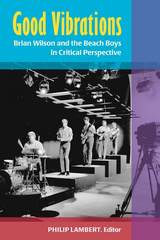 Good Vibrations: Brian Wilson and the Beach Boys in Critical Perspective
Philip Lambert, Editor
University of Michigan Press, 2016 Good Vibrations brings together scholars with a variety of expertise, from music to cultural studies to literature, to assess the full extent of the contributions to popular culture and popular music of one the most successful and influential pop bands of the twentieth century. The book covers the full fifty-year history of the Beach Boys’ music, from essays on some of the group’s best-known music—such as their hit single “Good Vibrations” —to their mythical unfinished masterpiece, Smile. Throughout, the book places special focus on the individual whose creative vision brought the whole enterprise to life, Brian Wilson, advancing our understanding of his gifts as a songwriter, arranger, and producer.
The book joins a growing body of literature on the popular music of the 1960s, in general, and on Brian Wilson and the Beach Boys in particular. But Good Vibrations extends the investigation further and deeper than it has gone before, not only offering new understanding and insights into individual songs and albums, but also providing close examination of compositional techniques and reflections on the group’s place in American popular culture.
 Good Water
Kevin Holdsworth
University Press of Colorado, 2016 In essays that combine memoir with biography of place, Kevin Holdsworth creates a public history of the land he calls home: Good Water, Utah. The high desert of south-central Utah is at the heart of the stories he tells here—about the people, the “survivors and casualties” of the small, remote town—and is at the heart of his own story.
Holdsworth also explores history at a personal level: how Native American history is preserved by local park officials; how Mormon settlers adapted to remote, rugged places; how small communities attract and retain those less likely to thrive closer to population centers; and how he became involved in local politics. He confronts the issues of land use and misuse in the West, from the lack of water to greed and corruption over natural resources, but also considers life’s simple pleasures like the value of scenery and the importance of occasionally tossing a horseshoe.
Good Water’s depiction of modern-day Utah and exploration of friendships and bonding on the Western landscape will fascinate and entice readers in the West and beyond.
Good with Words: Speaking and Presenting
Patrick Barry
Michigan Publishing, 2021 Suppose you were good with words. Suppose when you decided to speak, the message you delivered—and the way you delivered it—successfully connected with your intended audience. What would that mean for your career prospects? What would that mean for your comfort level in social situations? And perhaps most importantly, what would that mean for your satisfaction with the personal relationships you value the most?
This book is designed to help you find out. Based on an award-winning course and workshop series at the University of Michigan taken by students training to enter a wide range of fields—law, business, medicine, social work, public policy, design, engineering, and many more—it removes the guesswork from figuring out how to communicate clearly and compellingly. All of us have ideas that are worth sharing. Why not learn how to convey yours in a way that people will appreciate, enjoy, and remember?
Good with Words: Writing and Editing
Patrick Barry
Michigan Publishing, 2019 If your success at work or in school depends on your ability to communicate persuasively in writing, you’ll want to get Good with Words. Based on a course that law students at the University of Michigan and the University of Chicago have called "outstanding," "A-M-A-Z-I-N-G," and "the best course I have ever taken," the book brings together a collection of concepts, exercises, and examples that have also helped improve the advocacy skills of people pursuing careers in many other fields—from marketing, to management, to medicine.
Good with Words: Writing and Editing
Patrick Barry
Michigan Publishing, 2019 If your success at work or in school depends on your ability to communicate persuasively in writing, you’ll want to get Good with Words. Based on a course that law students at the University of Michigan and the University of Chicago have called "outstanding," "A-M-A-Z-I-N-G," and "the best course I have ever taken," the book brings together a collection of concepts, exercises, and examples that have also helped improve the advocacy skills of people pursuing careers in many other fields—from marketing, to management, to medicine.
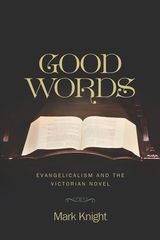 Good Words: Evangelicalism and the Victorian Novel
Mark Knight
Ohio State University Press, 2019 This new study explores how evangelicalism played a vital role in the development of the Victorian novel. In contrast to those who see the evangelical movement as trivial to our histories of the novel and part of the losing side in religion’s battle with secularity, Good Words: Evangelicalism and the Victorian Novel examines fiction by major writers of the nineteenth century—Thackeray, Dickens, Wood, MacDonald, Collins, and Butler—and reveals the extent to which the novel was shaped by evangelical thought and practice.
Rather than getting lost in historical and theological rabbit holes, Good Words invites readers to think about why evangelicalism still matters for the stories we tell about fiction in the Victorian period. The result has major implications for our understanding of the Victorian novel, our conception of the relationship between nineteenth-century literature and religion, the way in which we think about evangelical culture in the modern world, and our ideas about the practices and protocols of scholarly reading.
 Goodbye, Brazil: Émigrés from the Land of Soccer and Samba
Maxine L. Margolis
University of Wisconsin Press, 2013 Brazil, a country that has always received immigrants, only rarely saw its own citizens move abroad. Beginning in the late 1980s, however, thousands of Brazilians left for the United States, Japan, Portugal, Italy, and other nations, propelled by a series of intense economic crises. By 2009 an estimated three million Brazilians were living abroad—about 40 percent of them in the United States.
Goodbye, Brazil is the first book to provide a global perspective on Brazilian emigration. Drawing and synthesizing data from a host of sociological and anthropological studies, preeminent Brazilian immigration scholar Maxine L. Margolis surveys and analyzes this greatly expanded Brazilian diaspora, asking who these immigrants are, why they left home, how they traveled abroad, how the Brazilian government responded to their exodus, and how their host countries received them. Margolis shows how Brazilian immigrants, largely from the middle rungs of Brazilian society, have negotiated their ethnic identity abroad. She argues that Brazilian society abroad is characterized by the absence of well-developed, community-based institutions—with the exception of thriving, largely evangelical Brazilian churches.
Margolis looks to the future as well, asking what prospects at home and abroad await the new generation, children of Brazilian immigrants with little or no familiarity with their parents' country of origin. Do Brazilian immigrants develop such deep roots in their host societies that they hesitate to return home despite Brazil's recent economic boom—or have they become true transnationals, traveling between Brazil and their adopted lands but feeling not quite at home in either one?
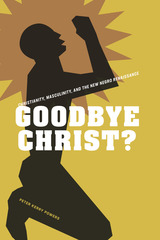 Goodbye Christ?: Christianity, Masculinity, and the New Negro Renaissance
Peter Kerry Powers
University of Tennessee Press, 2017 Despite the proliferation of criticism on the cultural work of the Harlem Renaissance over the course of the past two decades, surprisingly few critics have focused on the ways in which religious contexts shaped the works of New Negro writers and artists during that time. In Goodbye Christ? Christianity, Masculinity, and the New Negro Renaissance, Peter Kerry Powers fills this scholarly void, exploring how the intersection of race, religion, and gender during the Harlem Renaissance impacted the rhetoric and imagination of prominent African American writers of the early twentieth century.
In order to best understand the secular academic thought that arose during the Harlem Renaissance period, Powers argues, readers must first understand the religious contexts from which it grew. By illustrating how religion informed the New Negro movement, and through his analysis of a range of texts, Powers delineates the ways in which New Negro writers of the early twentieth century sought to loosen the grip of Christianity on the racial imagination, thereby clearing a space for their own cultural work—and for the development of a secular African American intelligentsia generally.
In addition to his examination of well-known authors, including W. E. B. Du Bois, Langston Hughes, and Zora Neale Hurston, Powers also offers an illuminating perspective on lesser-known figures, including Reverdy Ransom and Frederick Cullen. In his exploration of the role of race and religion at the time, Powers employs an intersectional approach to religion and gender, and especially masculinity, that sets the discussion on fertile new ground.
Goodbye Christ? answers the call for a body of work that considers religion as a relevant precursor to the secular intelligentsia that grew during the Harlem Renaissance in the early 1900s. By offering a complete look at the tensions that arose between churches and Harlem Renaissance writers and artists, readers can gain a better understanding of the work that Harlem Renaissance writers undertook during the early decades of the twentieth century.
Peter Kerry Powers is dean of the School of Humanities at Messiah College in Pennsylvania. He is the author of Recalling Religions: Resistance, Memory, and Cultural Revision in Ethnic Women’s Literature.
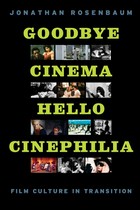 Goodbye Cinema, Hello Cinephilia: Film Culture in Transition
Jonathan Rosenbaum
University of Chicago Press, 2010 The esteemed film critic Jonathan Rosenbaum has brought global cinema to American audiences for the last four decades. His incisive writings on individual filmmakers define film culture as a diverse and ever-evolving practice, unpredictable yet subject to analyses just as diversified as his own discriminating tastes. For Rosenbaum, there is no high or low cinema, only more interesting or less interesting films, and the pieces collected here, from an appreciation of Marilyn Monroe’s intelligence to a classic discussion on and with Jean-Luc Godard, amply testify to his broad intellect and multi-faceted talent. Goodbye Cinema, Hello Cinephilia gathers together over fifty examples of Rosenbaum’s criticism from the past four decades, each of which demonstrates his passion for the way we view movies, as well as how we write about them. Charting our changing concerns with the interconnected issues that surround video, DVDs, the Internet, and new media, the writings collected here also highlight Rosenbaum’s polemics concerning the digital age. From the rediscovery and recirculation of classic films, to the social and aesthetic impact of technological changes, Rosenbaum doesn’t disappoint in assembling a magisterial cast of little-known filmmakers as well as the familiar faces and iconic names that have helped to define our era. As we move into this new decade of moviegoing—one in which Hollywood will continue to feel the shockwaves of the digital age—Jonathan Rosenbaum remains a valuable guide. Goodbye Cinema, Hello Cinephilia is a consummate collection of his work, not simply for fans of this seminal critic, but for all those open to the wide variety of films he embraces and helps us to elucidate.
Goodbye, Flicker: Poems
Carmen Giménez Smith
University of Massachusetts Press, 2012 This distinctive collection introduces a new type of mythmaking, daring in its marriage of fairy tale tropes with American mundanities. Conspiratorial, Goodbye, Flicker describes the interior life of a girl whose prince is a deadbeat dad and whose escape into a fantasy world is also an escape into language, beauty, and the surreal.
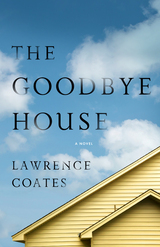 The Goodbye House
Lawrence Coates
University of Nevada Press, 2015 In the aftermath of the early 2000s dot-com bust, the people of San Jose, California, face a changing landscape of lost dreams and careers gone awry. It’s in this setting that Katherine Watson, a forty-seven-year-old event planner and mother of two, moves back into her childhood home with her teenage son, Carter. They live with her aging father, who is undergoing palliative care for prostate cancer. Katherine’s husband, Scott, has gone missing after his risky investments failed and they were forced to sell their dream home.
In this multigenerational family story, Katherine, Carter, and Scott all try to navigate an evolving world in the Golden State that doesn’t seem quite so golden any longer. Scott returns and hopes to restore and recreate their past happiness, Katherine contemplates divorce and explores new love along the way, and Carter works to find a place for himself in a new school among classmates who are hostile to him.
The characters fervently chase their dreams across Silicon Valley and beyond, from the gleaming office parks of Cupertino to a self-help seminar on the Las Vegas Strip and an underfunded high school theater production of The Tempest. The one element tying them all together is the house of the title, a 1950s tract home that once represented happiness and now holds the family close in its protective embrace, until, in the end, even this constant changes.
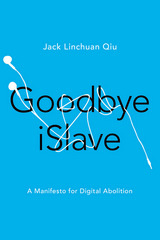 Goodbye iSlave: A Manifesto for Digital Abolition
Jack Linchuan Qiu
University of Illinois Press, 2016 Welcome to a brave new world of capitalism propelled by high tech, guarded by enterprising authority, and carried forward by millions of laborers being robbed of their souls. Gathered into mammoth factory complexes and terrified into obedience, these workers feed the world's addiction to iPhones and other commodities--a generation of iSlaves trapped in a global economic system that relies upon and studiously ignores their oppression. Focusing on the alliance between Apple and the notorious Taiwanese manufacturer Foxconn, Jack Linchuan Qiu examines how corporations and governments everywhere collude to build systems of domination, exploitation, and alienation. His interviews, news analysis, and first-hand observation show the circumstances faced by Foxconn workers--circumstances with vivid parallels in the Atlantic slave trade. Ironically, the fanatic consumption of digital media also creates compulsive free labor that constitutes a form of bondage for the user. Arguing as a digital abolitionist, Qiu draws inspiration from transborder activist groups and incidents of grassroots resistance to make a passionate plea aimed at uniting--and liberating--the forgotten workers who make our twenty-first-century lives possible.
 Goodbye, My Tribe: An Evangelical Exodus
Vic Sizemore
University of Alabama Press, 2020 Goodbye, My Tribe: An Evangelical Exodus is Vic Sizemore’s collection of personal essays chronicling two simultaneous transformations. One is the gathering of unconnected—and nonpolitical—evangelical congregations across the nation into the political juggernaut called the Religious Right; the other is the author’s own coming to terms with the emotional and spiritual trauma of his life deep inside fundamentalist Christianity, and his struggle to free himself from its grasp. Sizemore, whose father was a preacher and professor at a small West Virginia Bible college, attended Liberty University in Lynchburg, Virginia, arguably the crucible of American evangelical Christianity.
Sizemore began writing these essays with the aim of exploring and understanding what happened when the mythology of his “tribe” crumbled from beneath his feet. He draws heavily on his upbringing and his family history as a framework for how his “tribe” of white evangelicals have found ways to reconcile Christianity with what the author finds to be troubling stances on many social issues, among them race, gender, sexuality, materialism, anti-intellectualism, and white supremacy.
In a clear-eyed and eloquent voice, Sizemore grapples movingly with his own bewilderment and chagrin as he struggles to reconcile the essential philosophical and moral decay that he believes many evangelicals have come to embrace. His insights, arranged topically and thematically and told through graceful and accessible prose, toggle between memoir and literary journalism, along a spectrum that touches on history, philosophy, theology, and personal reflections.
.
 Good-bye, Piccadilly: BRITISH WAR BRIDES IN AMERICA
Jenel Virden
University of Illinois Press, 1996 As much of the world tried to return to normal living and working patterns after World War II, some 70,000 British women chose to be uprooted from the homeland they knew and loved. These were British war brides, a uniformly young group who by marrying American servicemen became part of the largest single group of female immigrants to the United States.
Though the women came to the U.S. from all parts of the British Isles, they were an unusually homogeneous group, averaging 23 years of age, from working- or lower-middle-class families and having completed mandatory schooling to the age of fourteen. For the most part they emigrated alone and didn't move into an existing immigrant population.
Jenel Virden draws on records in the National Archives in Washington, D.C., and the Public Record Office in London, as well as questionnaires and personal interviews, in relating the women's story. Virden finds that the marriages actually took place in spite of, rather than because of, the war.
And, while the women benefited from special nonrestrictive immigration legislation--and found public welcomes and a good deal of favorable publicity when they arrived--they also had much in common with other immigrant groups, including a strong sense of ethnic identity.
Goodbye, Ramona
Montserrat Roig, Translated by Megan Berkobien and María Cristina Hall
Fum d'Estampa Press, 2022
Montserrat Roig’s first novel, Goodbye, Ramona (1972), is a powerhouse story told through the points of view of three generations of women from the same family. Opening with scenes of a pregnant woman looking for her husband after the bombing of Barcelona’s Coliseum, Goodbye, Ramona explores the role of family, women’s relationships with men, the influence the weight of history and events out of women’s control have on them, and the silence in which women live their lives. Sweeping and dynamic, the historical and social mosaic of late nineteenth- and early twentieth-century Spain is seen through the lives and experiences of these female characters.
Good-Bye Samizdat: Twenty Years of Czechoslovak Underground Writing
Marketa Goetz-Stankiewicz
Northwestern University Press, 1992 Good-bye, Samizdat offers the first collection of the best of Czechoslovakia's samizdat, underground texts from the era 1948 through 1990. Divided into three sections, the volume includes fiction, cultural and political works, and philosophical essays. The writings reflect the thought of some of Czechoslovakia's best-known minds--Klima, Vaculik, and Havel--as well as others yet unknown in the West. Taken together, they capture the artistic and intellectual mood of a country situated at a focal point between East and West at a fascinating point in history.
Goodbye, Silver Sister: Poems
Jeanne Foster
Northwestern University Press, 2015 Goodbye, Silver Sister, Jeanne Foster’s second collection of poems, opens with a series of poems about a girl coming of age in pre-Katrina New Orleans, informed and haunted by the magic of the city. The powerful Pearl River forms the dividing line between adulthood and other worlds, both geographic and existential: “death, divorce, and the thousand other ways I would lose faith in the breastplate of love.” The collection is also an elegy for and tribute to the poet’s parents, who met in the WPA Artists’ Project. Through her poems she keeps them alive and is also able to say good-bye. Like the work of her mentor, James Wright, these poems reach far beyond the personal in their willingness to look at the unseemly sides of being human within the context of a profound spiritual search.
Good-bye, Son and Other Stories
Janet Lewis
Ohio University Press, 1986 Good-bye, Son and Other Stories, Janet Lewis’s only collection of short fiction, was first published in 1946, but remains as quietly haunting today as it was then. Set in small communities of the upper Midwest and northern California in the ’30s and ’40s, these midcentury gems focus on the quiet cycles connecting youth and age, despair and hope, life and death. A mother’s encounters with her deceased son, an aging woman sitting with the new knowledge of her troubled older sister’s death, and a teenager disillusioned by her own mortality are among the characters, mostly women and girls, whom Lewis delivers. Her understated style and knack for unadorned observation embed us with them as they reckon with the disquieting forces—incomprehensible and destructive to some, enlightening to others—that move us from birth, through life, to death. In the process, Lewis has crafted a paean to the living.
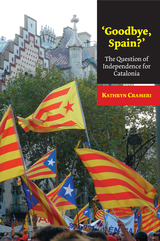 'Goodbye, Spain?': The Question of Independence for Catalonia
Kathryn Crameri
Sussex Academic Press, 2022 Support for independence in the Autonomous Community of Catalonia has risen significantly since 2005. Opinion polls confirm that the idea of holding a legally-binding referendum on independence is now supported by 80% of Catalans. Many commentators on nationalism in Western Europe had come to the conclusion that there was no serious threat to the established nation-states from secessionism within their borders. In The Identity of Nations (2007), Montserrat Guibernau wrote that decentralisation 'tames secessionism, both by offering significant power and resources to the national minorities it seeks to accommodate and by enticing regional political elites with the power, prestige and perks associated with devolution'. Scott Greer, in Nationalism and Self-Government (2007), wrote that 'secession seems unlikely' in the Catalan case because the regional political elites have too much to lose by such a move and are most concerned with winning further autonomy in specific areas that stabilise their own hold on regional power - a conclusion called into question by the recent radicalisation in Catalan politics and civil society. Causes for these striking changes in public sentiment include changes in the Catalan political landscape since 2003, problems of infrastructure, public apathy with the political process, disillusionment with the Spanish government, a rise in anti-Catalan feeling from other Spaniards (and a rise in anti-'Spanish' feeling among Catalans), the effects of the global financial crisis, and the bumpy ride experienced by Catalonia's new Statute of Autonomy. One notable change has been a shift in the dominant discourse of Catalan nationalism from concerns regarding language, culture and identity toward the political and economic welfare of Catalans. These political and economic discourses have overlaid rather than replaced cultural aspects. Published in association with the Canada Blanch Centre for Contemporary Spanish Studies / Catalan Observatory.
 Good-Bye to Old Peking: The Wartime Letters Of U.S. Marine Captain John Seymour Letcher, 1937-1939
John Seymour Letcher
Ohio University Press, 1998 For two and a half years (1937-1939), Captain John Seymour Letcher commanded a company of the U.S. Embassy Marine Guard in Peking. During that time, he wrote a series of letters to his parents in Virginia describing the life of a Westerner in the former imperial city. During that same time, China was invaded by Japan.
Captain Letcher describes the flavor of life in pre-Communist China — the food, servants, cold Peking winters and torrid summers, hunting, and excursions to the major tourist sites.
But his letters also tell of the Japanese slaughter of Chinese troops in the opening days of the Sino-Japanese War. He wrote about life in a city under Japanese occupation and the stirring story of the Chinese guerrillas rebounding from devastating defeat.
These letters and accompanying introduction, preface, and notes, draw attention to the Western experience in a place and time largely overlooked by military historians and modern China specialists.
Goodbye to Poplarhaven: Recollections of a Utah Boyhood
Edward A. Geary
University of Utah Press, 2017 “‘Nothing is nicer,’ Grandpa used to say, ‘than a full barn and a full granary.’ He might have said a full cellar too, for the rows of bottled fruit loomed on the shelves in the dim light, and the aroma of apples filled the nostrils. We could sit down at the dinner table knowing where everything on it had come from, and the process by which it had been prepared. We had before us and around us tangible evidence of the interconnection of things, of tilling, and seedtime, and harvest, of process and product, work and reward. Abundance is what remained when the threshing was done and the mellow Utah autumn slid gradually into winter, abundance in the storehouse for man and beast, evidence that we reap as we have sown. And abundance in the memory which lasts long after the barn and granary are empty hulks, for sometimes we also reap where others have sown.”—from chapter sixteen
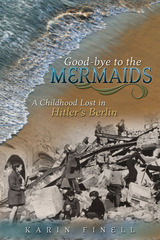 Good-bye to the Mermaids: A Childhood Lost in Hitler's Berlin
Karin Finell
University of Missouri Press, 2026 Good-bye to the Mermaids conveys the horrors of war as seen through the innocent eyes of a child. It is the story of World War II as it affected three generations of middle-class German women: Karin, six years old when the war began, who was taken in by Hitler’s lies; her mother, Astrid, a rebellious artist who occasionally spoke out against the Nazis; and her grandmother Oma, a generous and strong-willed woman who, having spent her own childhood in America, brought a different perspective to the events of the time. It tells of a convoluted world where children were torn between fear and hope, between total incomprehension of events and the need to simply deal with reality. In one of the relatively few recollections of the war from a German woman’s perspective, Finell relates what was for her a normal part of growing up: participating in activities of the Hitler Youth, observing Nazi customs at Christmas, and once being close enough to the Führer at a rally to make eye contact with him. She tells of how she first became aware of the yellow star that Jews were forced to wear, and of being asked to identify corpses from a bombed apartment house. She also depicts the lives of people tainted by Hitler’s influence: her half-Jewish relatives who gave in to the strain of trying to remain unnoticed; a favorite aunt who was gassed because she was old and had broken her hip; and a friend of the family who was involved in the abortive putsch against Hitler and hanged as a traitor. When American and British forces intensified air raids on Berlin in 1943, Finell observed the stoical valor of women during the bombings, firestorms, and mass evacuations. Not yet a teenager, she witnessed the battle for Berlin and the mass rapes perpetrated by conquering Russian and Mongolian troops. Order was restored after the American and British troops arrived. The Marshall Plan jump-started an economic recovery for West Germany, provoking the Russians to blockade Berlin. From 1948 to 1949 the Americans and British kept Berlin’s residents alive with the airlift. But even though food was flown in, the people of Berlin continued to go hungry. Deprivation forced Berliners to look inward and face their collective guilt as they withstood the threat of Soviet occupation during these postwar years. This eloquent and touching story tells how a decent people were perverted by Hitler and how a young girl ultimately came to recognize the father figure Hitler for the monster he was. From a time of innocence, Karin Finell takes readers along a nightmarish journey in which fantasies are clung to, set aside, and at last set free. Good-bye to the Mermaids presents us with the revelation that human beings can survive such times with their souls intact.
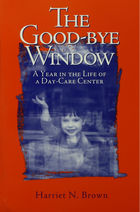 The Good-bye Window: A Year in the Life of a Day-Care Center
Harriet Brown
University of Wisconsin Press, 1998 Have you ever wondered what really goes on at your child’s day-care center after you say good-bye? Harriet Brown did. To satisfy her curiosity, she spent an entire year observing Red Caboose, a center in Madison, Wisconsin. This engaging and thought-provoking book is the story of that year.
In her beautifully written personal account, journalist and mother Brown takes us behind the scenes at a day-care center that works. At Red Caboose, one of the oldest independent centers in the country, we meet teachers who have worked with young children for more than twenty years. We watch the child-care union and parents struggle to negotiate a contract without ripping apart the fabric of trust and love that holds the Red Caboose community together.
We look at the center’s finances, to see what keeps Red Caboose going at a time when other good centers are disappearing. Best of all, we get to know the children, families, and teachers of Red Caboose—their struggles, their sorrows, their triumphs.
Started twenty-five years ago by a group of idealistic parents, the center has not only survived but thrived through some pretty tough times. In the world of day care, Red Caboose is a special place, a model for what child care in this country could and should be: not just babysitting, not just a service to working parents, but a benefit for children, families, teachers, and the community at large.
Brown sets her rich and engaging stories in the greater political and social context of our time. Why is so much child care bad? Why should working Americans worry about the link between welfare reform and child care? What can we learn from the history of child care?
This book is a must-read for parents, educators, and anyone who enjoys first-rate writing and dead-on insight into the lives of our youngest children and those who care for them.
“[Brown’s] writing is beautiful and her scholarship sound. Students considering day-care careers, day-care professionals, and concerned parents will gain insight by reading this provocative book, as will anyone who cares about the future of young children in this country.”—Choice
“I admire enormously the ambition of this book—its eagle-eyed witness and engrossing detail, plus the social importance of the project. I wish there were in the world more books like it.”—Lorrie Moore, author of Who Will Run the Frog Hospital?
“The Good-bye Window is a fascinating peek into the secret world of children. With the poignancy of Anne LaMott, and the reportorial grace of Tracy Kidder, Harriet Brown has written a terrific and worthwhile book.”—Meg Wolitzer, author of This Is Your Life
“Harriet Brown’s well-told story of the Red Caboose child-care center should be read by teachers and parents, but also by every legislator and politician in the land. Only a writer as good as Ms. Brown could display the dramatic complexities of a school community in which the youngest members enter crawling and emerge a few years later as articulate, empathetic, and well-socialized individuals, ready for the ‘real world.’”—Vivian Gussin Paley, author of The Boy Who Would Be a Helicopter
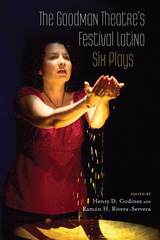 The Goodman Theatre's Festival Latino: Six Plays
Henry D Godinez and Ramón H Rivera-Servera
Northwestern University Press, 2013 Drawn from the first ten years of the Goodman Theatre’s renowned biennial festival of Latino plays, the works in this collection expand the definition of Latino theater, resisting the confines of a particular language, locale, or assumed audience. Instead of focusing on similarities that outline the boundaries of Latino identity, these plays look outward, representing the multiplicity of actual Latino experience. The plays were written and performed sometimes in English and sometimes in Spanish; their stories are set in heterogeneous milieus; they’re directed at both Latino and non-Latino audiences; and they incorporate cultural or theatrical elements from vastly different traditions. As a group, these plays indicate the extraordinary range of the festival’s offerings and show how it has contributed to a more complex notion of what Latino theater is and can be.
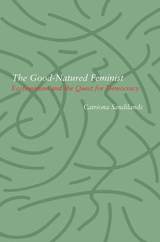 Good-Natured Feminist: Ecofeminism And The Quest For Democracy
Catriona Sandilands
University of Minnesota Press, 1999 A foundational statement of the democratic promise of ecofeminism. Heroic mothers defending home and hearth against a nature deformed by multinationalist corporate practice: this may be a compelling story, but it is not necessarily the source of valid feminist or ecological critique. What’s missing is the democratic element, an insistence on bringing to public debate all the relations of gender and nature that such a view takes for granted. This book aims to situate a commitment to theory and politics—that is, to democratic practice—at the center of ecofeminism and, thus, to move toward an ecofeminism that is truly both feminist and ecological. The Good-Natured Feminist inaugurates a sustained conversation between ecofeminism and recent writings in feminist postmodernism and radical democracy. Starting with the assumption that ecofeminism is a body of democratic theory, the book tells how the movement originated in debates about “nature” in North American radical feminisms, how it then became entangled with identity politics, and how it now seeks to include nature in democratic conversation and, especially, to politicize relations between gender and nature in both theoretical and activist milieus.
 A Good-Natured Riot: The Birth of the Grand Ole Opry
Charles K. Wolfe
Vanderbilt University Press, 1999 Winner of the Ralph J. Gleason Music Book Award
Winner of the ASCAP Deems Taylor Award
On November 28, 1925, a white-bearded man sat before one of Nashville radio station WSM's newfangled carbon microphones to play a few old-time fiddle tunes. Uncle Jimmy Thompson played on the air for an hour that night, and throughout the region listeners at their old crystal sets suddenly perked up. Back in Nashville the response at the offices of National Life Insurance Company, which owned radio station WSM ("We Shield Millions"), was dramatic; phone calls and telegrams poured into the station, many of them making special requests. It was not long before station manager George D. Hay was besieged by pickers and fiddlers of every variety, as well as hoedown bands, singers, and comedians--all wanting their shot at the Saturday night airwaves. "We soon had a good-natured riot on our hands," Hay later recalled. And, thus, the Opry was born.
Or so the story goes. In truth, the birth of the Opry was a far more complicated event than even Hay, "the solemn old Judge," remembered. The veteran performers of that era are all gone now, but since the 1970s pioneering country music historian Charles K. Wolfe has spent countless hours recording the oral history of the principals and their families and mining archival materials from the Country Music Foundation and elsewhere to understand just what those early days were like. The story that he has reconstructed is fascinating. Both a detailed history and a group biography of the Opry's early years, A Good-Natured Riot provides the first comprehensive and thoroughly researched account of the personalities, the music, and the social and cultural conditions that were such fertile ground for the growth of a radio show that was to become an essential part of American culture.
Wolfe traces the unsure beginnings of the Opry through its many incarnations, through cast tours of the South, the Great Depression, commercial sponsorship by companies like Prince Albert Tobacco, and the first national radio linkups. He gives colorful and engaging portraits of the motley assembly of the first Opry casts--amateurs from the hills and valleys surrounding Nashville, like harmonica player Dr. Humphrey Bate ("Dean of the Opry") and fiddler Sid Harkreader, virtuoso string bands like the Dixieliners, colorful hoedown bands like the Gully Jumpers and the Fruit Jar Drinkers, the important African American performer DeFord Bailey, vaudeville acts and comedians like Lasses and Honey, through more professional groups such as the Vagabonds, the Delmore Brothers, Bill Monroe and the Blue Grass Boys, and perennial favorite Roy Acuff and his Smoky Mountain Boys.
With dozens of wonderful photographs and a complete roster of every performer and performance of these early Opry years, A Good-Natured Riot gives a full and authoritative portrayal of the colorful beginnings of WSM's barn dance program up to 1940, by which time the Grand Ole Opry had found its national audience and was poised to become the legendary institution that it remains to this day.
 Goodness and Rightness in Thomas Aquinas's Summa Theologiae
James F. Keenan, SJ
Georgetown University Press, 1992 This appraisal of two of the most fundamental terms in the moral language of Thomas Aquinas draws on the contemporary moral distinction between the goodness of a person and the rightness of a person's living. Keenan thus finds that Aquinas's earlier writings do not permit the possibility of such a distinction. But in his mature works, specifically the Summa Theologiae, Thomas describes the human act of moral intentionality, and even the virtues in a way analogous to our use of the term moral rightness. To Thomas, only the virtue of charity expresses moral goodness. And, although Thomas describes vices and sin as wrong conduct, he never really develops a description for moral badness.
Keenan compels us to carefully examine Thomas's central moral concepts and to measure them against contemporary standards for meaning and correctness. As a result, any student of Thomas will find here a forceful argument that his notion of the good is considerably different from ours. Similarly, ethicists and moral theologians will find in the Thomas presented here a consistent-virtue ethicist concerned with descriptions for right living. Any student of theology will also find here a Thomas whose critical and concrete thinking enabled him to develop and even abandon earlier positions as his comprehension of the Good evolved. This analysis prompts a re-examination of our own concepts. Measuring Thomas's standards against our own, Keenan obliges us to ask whether we sufficiently understand rightness and moral intentionality. He also asks whether we correctly describe what it means to will or to desire something. He further questions whether we have surrendered our understanding of the virtues to the voluntarism and subjectivism which Thomas relentlessly critiqued. This historically sophisticated reading of the Summa Thologiae both allows Thomas to speak again as he once did, and affords us the chance to evaluate the way we describe ourselves and one another as being good and living rightly.
 Goodness beyond Virtue: Jacobins during the French Revolution
Patrice Higonnet
Harvard University Press, 1998 Who were the Jacobins and what are Jacobinism's implications for today? In a book based on national and local studies--on Marseilles, Nîmes, Lyons, and Paris--one of the leading scholars of the Revolution reconceptualizes Jacobin politics and philosophy and rescues them from recent postmodernist condescension.
Patrice Higonnet documents and analyzes the radical thought and actions of leading Jacobins and their followers. He shows Jacobinism's variety and flexibility, as it emerged in the lived practices of exceptional and ordinary people in varied historical situations. He demonstrates that these proponents of individuality and individual freedom were also members of dense social networks who were driven by an overriding sense of the public good. By considering the most retrograde and the most admirable features of Jacobinism, Higonnet balances revisionist interest in ideology with a social historical emphasis on institutional change. In these pages the Terror becomes a singular tragedy rather than the whole of Jacobinism, which retains value today as an influential variety of modern politics. Higonnet argues that with the recent collapse of socialism and the general political malaise in Western democracies, Jacobinism has regained stature as a model for contemporary democrats, as well as a sober lesson on the limits of radical social legislation.
Goodness Gracious, Miss Agnes: Patchwork of Country Living
Lera Knox
University of Tennessee Press, 2009 Electronic books, Farmers' spouses--Tennessee, Middle--History--20th century--Biography, Knox family--Anecdotes, Knox, Lera, --1896-, Tennessee, Middle--History--20th century--Biography--Anecdotes, Ussery family--Anecdotes, Women journalists--Tennessee, Middle--History--20th century--Biography
Goodnight, Gracie
Lloyd Schwartz
University of Chicago Press, 1992 With Gracie Allen as their uninhibited Muse, Lloyd Schwartz's poems strike an unusual balance between comedy and pathos. His exuberant interest in the social world is qualified by a poignant sense of time and mortality, and of the interior, inaccessible zones of life.
"Like a latter-day Whitman, an addict of contraries or its victim, Schwartz sets out to understand that network in as many ways as his imagination allows. Once you get the hang of what Schwartz is tuning into, you can't stop tuning into it yourself. . . .A master of timing."—Robyn Selman, Voice Literary Supplement
"[Schwartz's] poems seem to think in musical structures; he hears those evanescent snatches of conversation that compose our emotional lives, recognizes their fluid importance, and organizes them for us."—Stephen Tapscott, Boston Phoenix
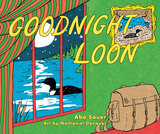 Goodnight Loon
Abe Sauer
University of Minnesota Press, 2014 A charming retelling of a children’s classic in a distinctly Northwoods voice There’s a loon, of course. And a Duluth pack. And crop art, Tater Tot hotdish, and, inevitably, deer ticks. The familiar green room is set on a pontoon, lit by the moon over a quiet lake. The childhood classic Goodnight Moon is transformed into a must-have for every Minnesota child’s bookshelf. Written and illustrated by two fathers who value good rhymes and the power of simple, evocative illustrations, Goodnight Loon moves the story that so many parents know by heart into Northwoods territory. Author Abe Sauer and illustrator Nathaniel Davauer created this book as a tribute to the cherished favorite written by Margaret Wise Brown. Their faithful homage brings fresh life to a much-loved story. The words rhyme, rock, and soothe with the same cadence as the original. Yellow canoes, snowshoes, and a hungry raccoon all make appearances in the room inhabited by a beaver in a sleeping bag and his voyageur companion. Illustrations inspired by the style of Goodnight Moon will give even the youngest child something to search for on every page. It is the perfect bedtime book for babies, children, and parents looking for a story written especially for their Northwoods little ones. And where else will you find walleye eating rhubarb pie?
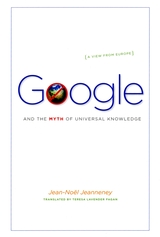 Google and the Myth of Universal Knowledge: A View from Europe
Jean-Noël Jeanneney
University of Chicago Press, 2006 The recent announcement that Google will digitize the holdings of several major libraries sent shock waves through the book industry and academe. Google presented this digital repository as a first step towards a long-dreamed-of universal library, but skeptics were quick to raise a number of concerns about the potential for copyright infringement and unanticipated effects on the business of research and publishing.
Jean-Noël Jeanneney, president of France’s Bibliothèque Nationale, here takes aim at what he sees as a far more troubling aspect of Google’s Library Project: its potential to misrepresent—and even damage—the world’s cultural heritage. In this impassioned work, Jeanneney argues that Google’s unsystematic digitization of books from a few partner libraries and its reliance on works written mostly in English constitute acts of selection that can only extend the dominance of American culture abroad. This danger is made evident by a Google book search the author discusses here—one run on Hugo, Cervantes, Dante, and Goethe that resulted in just one non-English edition, and a German translation of Hugo at that. An archive that can so easily slight the masters of European literature—and whose development is driven by commercial interests—cannot provide the foundation for a universal library.
As a leading librarian, Jeanneney remains enthusiastic about the archival potential of the Web. But he argues that the short-term thinking characterized by Google’s digital repository must be countered by long-term planning on the part of cultural and governmental institutions worldwide—a serious effort to create a truly comprehensive library, one based on the politics of inclusion and multiculturalism.
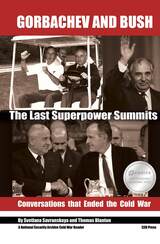 Gorbachev and Bush: The Last Superpower Summits. Conversations that Ended the Cold War
The National Security Archive Savranskaya
Central European University Press, 2020 This book presents and interprets archival records of the meetings between Mikhail Gorbachev and George W. Bush between 1989 and 1991, including transcripts of conversations between top leaders on the rapid and monumental events of the final days of the Cold War. Particularly effective interlocutors were the foreign ministers Eduard Shevardnadze and James Baker, especially interesting when they interacted directly with Bush or Gorbachev. The documents were obtained from the Gorbachev Foundation and the Russian State Archives and from the United States government through requests under the Freedom of Information Act. Taking place at a time of revolutionary change in Eastern Europe, stimulated in part by Gorbachev and by Eastern Europeans (the Solidarity movement, dissidents, reform communists), the Malta Summit of 1989 and subsequent meetings helped defuse any potential for superpower conflict. Each of the five summits is covered in a separate chapter, introduced by an essay that places the transcripts in historical context. The anthology offers a fascinating glimpse into the relationship that defined the last, waning years of the Cold War—a unique record of these historic, highest-level conversations that effectively brought it to a close. The quality and scope of the dialogue between these world leaders was unprecedented and is likely never to be repeated.
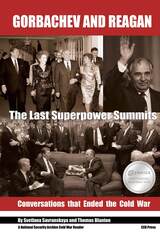 Gorbachev and Reagan: The Last Superpower Summits. Conversations that Ended the Cold War
The National Security Archive Savranskaya
Central European University Press, 2020 This book is the culmination of twenty years of research in which the editors gathered thousands of pages documenting the most important conversations of the late Cold War. Every word Ronald Reagan and Mikhail Gorbachev said to each other in their five superpower summits from 1985 to 1988 is included in this volume. The editors argue in their contextual essays and detailed notes that these summits fueled a learning process on both sides of the Cold War. Their anthology provides insight into the nuanced shifts of monumentally important discussions, showing how Moscow’s sense of threat was eased and how a hawkish Reagan softened his tone in negotiations during his second presidential term. Documents from foreign ministers Eduard Shevardnadze and George Shultz offer a particularly intriguing look into the handful of conversations that ended almost half a century of conflict. These verbatim transcripts, until now top secret, are combined with fascinating photos and crucial information from declassified preparatory and after-action documents from both the Americans and Soviets, obtained in the US through the Freedom of Information Act and in Russia from the Gorbachev Foundation, the State Archive of the Russian Federation in Moscow, and from the personal files of Anatoly Chernyaev, Gorbachev’s foreign policy adviser.
 The Gordon File: A Screenwriter Recalls Twenty Years of FBI Surveillance
By Bernard Gordon
University of Texas Press, 2004 For twenty-six years, the FBI devoted countless hours of staff time and thousands of U.S. taxpayer dollars to the surveillance of an American citizen named Bernard Gordon. Given the lavish use of resources, one might assume this man was a threat to national security or perhaps a kingpin of organized crime—not a Hollywood screenwriter whose most subversive act was joining the Communist Party during the 1940s when we were allied with the USSR in a war against Germany. For this honest act of political dissent, Gordon came to be investigated by the House Committee on Un-American Activities in 1952, blacklisted by the Hollywood film industry, and tailed by the FBI for over two decades.
In The Gordon File, Bernard Gordon tells the compelling, cautionary story of his life under Bureau surveillance. Drawing on his FBI file of over 300 pages, which he obtained under the Freedom of Information Act, he traces how the Bureau followed him from Hollywood to Mexico, Paris, London, Rome, and even aboard a Dutch freighter as he created an unusually successful, albeit uncredited, career as a screenwriter and producer during the blacklist years. Comparing his actual activities during that time to records in the file, he pointedly and often humorously underscores how often the FBI got it wrong, from the smallest details of his life to the main fact of his not being a threat to national security.
Most important, Gordon links his personal experience to the headlines of today, when the FBI is again assuming broad powers to monitor political dissidents it deems a threat to the nation. "Is it possible," he asks, "that books like this will help to move our investigative agencies from the job of blackmailing those who are critical of our imperfect democracy to arresting those who are truly out to destroy us?"
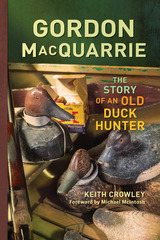 Gordon MacQuarrie: The Story of an Old Duck Hunter
Keith Crowley
Wisconsin Historical Society Press, 2003 Although his typewriter has been silent for nearly fifty years, Gordon MacQuarrie’s words continue to inspire generations of hunting and fishing enthusiasts. Through his “Stories of the Old Duck Hunters,” most of which are still in print, MacQuarrie captured the intangible, emotional qualities of the outdoor life in a way that made him unique among his peers. As a result, his audience and his legend continue to grow. Gordon MacQuarrie: The Story of an Old Duck Hunter is the first full-length biography of this literary legend. It explores the relationships he nurtured and treasured; records his coming of age during Theodore Roosevelt’s Conservation Movement; documents his rise to national prominence as the first full-time, professional outdoor writer in America; and follows his life as journalist, storyteller, husband, father, outdoorsman, and conservationist. Complete with rarely seen photographs and a comprehensive timeline of his writings, this book is a fitting companion to MacQuarrie’s own Stories of the Old Duck Hunters anthologies.
A Gorgeous Gallery of Gallant Inventions, 1578
Hyder Edward Rollins
Harvard University Press So far as the general public is concerned, the Gorgeous Gallery, which was first published in 1678, has never been reprinted; the present critical edition will therefore supply a genuine need on the part of all students of Elizabethan literature. It is based on a copy (only two are in existence) that formerly belonged to Dr. Richard Farmer and later to Edmund Malone, the Shakespearean scholar, with the remainder of whose books it found a final resting-place in the Bodleian library. The present text aims to be an exact reprint, page for page, line for line, with the exception of consistent typographical changes conducive to greater ease in reading. As a mirror of the age just before Shakespeare, it possesses for the modern reader a wealth of interest quite apart from its appeal as poetry.
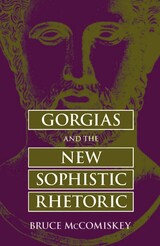 Gorgias and the New Sophistic Rhetoric
Bruce McComiskey
Southern Illinois University Press, 2002 In Gorgias and the New Sophistic Rhetoric, Bruce McComiskey achieves three rhetorical goals: he treats a single sophist's rhetorical technê (art) in the context of the intellectual upheavals of fifth-century bce Greece, thus avoiding the problem of generalizing about a disparate group of individuals; he argues that we must abandon Platonic assumptions regarding the sophists in general and Gorgias in particular, opting instead for a holistic reading of the Gorgianic fragments; and he reexamines the practice of appropriating sophistic doctrines, particularly those of Gorgias, in light of the new interpretation of Gorgianic rhetoric offered in this book. In the first two chapters, McComiskey deals with a misconception based on selective and Platonic readings of the extant fragments: that Gorgias's rhetorical technê involves the deceptive practice of manipulating public opinion. This popular and ultimately misleading interpretation of Gorgianic doctrines has been the basis for many neosophistic appropriations. The final three chapters deal with the nature and scope of neosophistic rhetoric in light of the non-Platonic and holistic interpretation of Gorgianic rhetoric McComiskey postulates in his opening chapters. He concludes by examining the future of communication studies to discover what roles neosophistic doctrines might play in the twenty-first century. McComiskey also provides a selective bibliography of scholarship on sophistic rhetoric and philosophy in English since 1900.
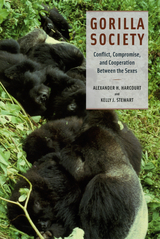 Gorilla Society: Conflict, Compromise, and Cooperation Between the Sexes
Alexander H. Harcourt and Kelly J. Stewart
University of Chicago Press, 2007 Societies develop as a result of the interactions of individuals as they compete and cooperate with one another in the evolutionary struggle to survive and reproduce successfully. Gorilla society is arranged according to these different and sometimes conflicting evolutionary goals of the sexes. In seeking to understand why gorilla society exists as it does, Alexander H. Harcourt and Kelly J. Stewart bring together extensive data on wild gorillas, collected over decades by numerous researchers working in diverse habitats across Africa, to illustrate how the social system of gorillas has evolved and endured.
Gorilla Society introduces recent theories explaining primate societies, describes gorilla life history, ecology, and social systems, and explores both sexes’ evolutionary strategies of survival and reproduction. With a focus on the future, Harcourt and Stewart conclude with suggestions for future research and conservation. An exemplary work of socioecology from two of the world’s best known gorilla biologists, Gorilla Society will be a landmark study on a par with the work of George Schaller—a synthesis of existing research on these remarkable animals and the societies in which they live.
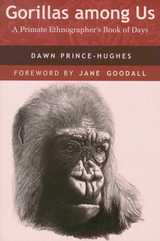 Gorillas among Us: A Primate Ethnographer’s Book of Days
Dawn Prince-Hughes; Foreword by Jane Goodall
University of Arizona Press, 2001 Dawn Prince-Hughes is an extraordinary researcher. She does not experiment or measure but instead sits on a wooden bench for hours each day, watching captive gorillas through the enclosure where other visitors average five-second stops. Her patience is rewarded with astounding observations—she watches gorillas make and use tools, bury a dead crow, give birth, and comfort and care for each other. In Gorillas among Us, Prince-Hughes has compressed years of gorilla observation into a composite diary chronicling the days of one gorilla family. She creates a blended portrait of both peoples—gorilla and human. The entries capture significant observations, which often prompt brief discussions of gorillas’ captivity, diet, communication, aesthetic preferences, social behavior, and play. Several chapters end with thought-provoking meditations on human values. The final section, “More about Gorillas,” provides a concise, accessible introduction to gorilla natural history. This book will delight and move anyone with an interest in animals, and it also makes a significant contribution to the scarce literature on captive gorillas. Prince-Hughes's observations of tool use by gorillas will interest scientists, and even a casual reader will come away with a new sense of the power of observation. The author hopes to change the way we look at animals in the wild and in captivity, and laments that zoo visitors pause so briefly in front of the gorilla enclosure, rushing on with their assumptions unchanged, without really seeing the gorillas. By turns opinionated and descriptive, quirky and authoritative, Prince-Hughes draws us into the family life of captive gorillas and into a consideration of our own culture. Readers will learn something new about gorillas and themselves on every page of this poignant story. The book testifies to the potential for interspecies compassion and the love that one person can find in a family of gorillas.
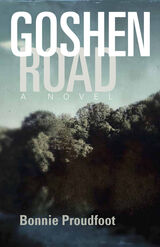 Goshen Road: A Novel
Bonnie Proudfoot
Ohio University Press, 2020 Goshen Road is an elegiac, unvarnished, and empathetic portrait of one working-class family over two decades in rural West Virginia, with sisters Dessie and Billie Price as its urgently beating heart. Bonnie Proudfoot captures them, their husbands, and their children as they balance on the divide between Appalachia old and new, struggling for survival and reconciling themselves with past hurts and future uncertainties as the economy and culture shift around them. The story opens in 1967 with a logging accident and the teenaged Lux Cranfield’s headlong plunge into the courtship of Dessie—a leap he takes not only in the wake of his near-death experience but to exchange his bitter home life for a future with the Prices, a family that appears to have the stability and peace that his own lacks. Within the year Lux and Dessie marry. Meanwhile, Dessie’s rebellious younger sister, Billie, fights her way through adolescence with an eye toward an escape of her own, only to land with Lux’s friend Alan Ray Munn and settle into a life of hardship. Ultimately, the voices and passions of Dessie, Billie, Lux, Alan Ray, and the Cranfield children build on one another to create an unforgettable chorus about the promises and betrayals of love—and what it takes to preserve a family when everything else is uncertain.
The Gospel According to James and Other Plays
Charles R. Smith
Ohio University Press, 2012 This collection of five award-winning plays by Charles Smith includes Jelly Belly, Free Man of Color, Pudd’nhead Wilson, Knock Me a Kiss, and The Gospel According to James. Powerful, provocative, and entertaining, these plays have been produced by professional theater companies across the country and abroad. Four of the plays are based on historical people and events from W.E.B. Du Bois and Countee Cullen to the Harlem Renaissance. Accurate in the way they capture the political and cultural milieu of their historical settings, and courageous in the way they grapple with difficult questions such as race, education, religion, and social class, these plays jump off the page just as powerfully as they come to life on stage. This first-ever collection from one of the nation’s leading African American playwrights is a journey down the complex road of race and history.
 The Gospel according to Shakespeare
Piero Boitani
University of Notre Dame Press, 2013 In this slim, poetically powerful volume, Piero Boitani develops his earlier work in The Bible and Its Rewritings, focusing on Shakespeare’s “rescripturing” of the Gospels. Boitani persuasively urges that Shakespeare read the New Testament with great care and an overall sense of affirmation and participation, and that many of his plays constitute their own original testament, insofar as they translate the good news into human terms. In Hamlet and King Lear, he suggests, Shakespeare’s "New Testament" is merely hinted at, and faith, salvation, and peace are only glimpsed from far away. But in Pericles, Cymbeline, The Winter’s Tale, and The Tempest, the themes of compassion and forgiveness, transcendence, immanence, the role of the deity, resurrection, and epiphany are openly, if often obliquely, staged. The Christian Gospels and the Christian Bible are the signposts of this itinerary.
Originally published in 2009, Boitani's Il Vangelo Secondo Shakespeare was awarded the 2010 De Sanctis Prize, a prestigious Italian literary award. Now available for the first time in an English translation, The Gospel according to Shakespeare brings to a broad scholarly and nonscholarly audience Boitani's insights into the current themes dominating the study of Shakespeare's literary theology. It will be of special interest to general readers interested in Shakespeare’s originality and religious perspective.
"This is an incredible book, written by one of the most learned and, at the same time, passionately elegant Italian scholars. I enjoyed reading it in Italian; it is a pleasure for eyes and soul to savor it in English. And you don't need to be a theologian to appreciate it and keep it on your desk." —Edmondo F. Lupieri, Loyola University, Chicago
"This volume displays to the full that unique combination of comprehensive reference and precise application that we have happily come to expect of Piero Boitani's writings. There is, however, an especial urgency at work in these pages and a confidence not merely in the ways that theology can illuminate Shakespeare's texts but also in the ways that Shakespeare's plays can lead to a fresh understanding of what the Gospel is. The sheer energy of Boitani's vision, argument, and phrase (made accessible by an excellent translation) immediately engages the attention of the reader, who will surely return to Shakespeare's original work with a sharpened appetite for its poetry as well as for its Christian meaning." —Robin Kirkpatrick, University of Cambridge
"This brilliant, beautiful book unfolds the unique theological vision of Shakespeare's late plays. The gospel according to Shakespeare, the 'good news,' is immanent: on earth, in historical time, and achieved through the recognition of love. Boitani's vision weaves Shakespeare's imagery among the plays, the Bible, and the classics, producing a reading experience of such plenitude that it is akin to the world he describes." —Regina Schwartz, Northwestern University
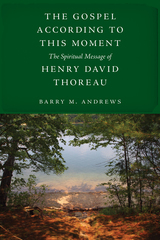 The Gospel According to This Moment: The Spiritual Message of Henry David Thoreau
Barry M. Andrews
University of Massachusetts Press, 2024 Henry David Thoreau is best known as a writer, naturalist, and social critic, but he was also a schoolteacher, surveyor, and pencil-maker. In The Gospel According to This Moment, Unitarian minister Barry M. Andrews reveals how an idiosyncratic and unconventional religious faith was central to Thoreau’s many-faceted life—a dimension that has been largely unexamined.
Through close readings of his writings and a focus on his Unitarian upbringing, Harvard education, mentoring by Ralph Waldo Emerson, and immersion in ancient Eastern and Western philosophies, Andrews explores the nature of Thoreau’s spiritual message, what he called the “Gospel according to this moment,” which enables a flourishing and deliberate life. Today, Thoreau is widely recognized as an advocate for simple living, environmental preservation, and civil disobedience. As Andrews uncovers, Thoreau is also a spiritual guide who can teach us an alternative way of being religious in the world.
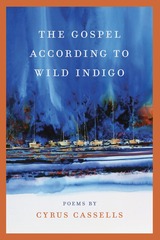 The Gospel according to Wild Indigo
Cyrus Cassells
Southern Illinois University Press, 2018 Finalist for the Balcones Poetry Prize, 2018
Finalist for the Helen C. Smith Award for the Best Book of Poetry from the Texas Institute of Letters, 2019
Nominated for the NAACP Image Award for Outstanding Literature in Poetry, 2019
Consisting of two dynamic song cycles, Cyrus Cassells’s sixth poetry volume, The Gospel according to Wild Indigo, keeps the reader on edge with a timeless and beguiling feast of language that fuses together history, memory, and family.
The first cycle, rooted in the culture of the Gullah people of Charleston and the Sea Islands, celebrates the resilience of the rice- and indigo-working slaves and their descendants who have forged a unique Africa-inspired language and culture. Set against a Mediterranean backdrop, the second cycle explores themes of pilgrimage, love, and loss, concluding with a pair of elegies to the poet’s mother and the many men lost in the juggernaut of the AIDS crisis. Throughout, Cassells invites the reader to consider the duality of grief and love, as well as the shifting connections between past and present.
Cassells’s language is always striking, unpredictable, and beautiful, conjuring a world not only of “placid seagulls perched / in priest-gentle pines / like festive Christmas ornaments” but also one where “Death prevailed, / tireless as a forest partisan.” His poems transport the reader across time, space, and language, searching constantly not just for empathy but also for the human spirit in its triumph, for “our human joy, / laced with an ageless grieving.”
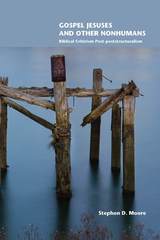 Gospel Jesuses and Other Nonhumans: Biblical Criticism Post-poststructuralism
Stephen D. Moore
SBL Press, 2017 Essential reading for biblical studies students and scholars interested in cutting-edge critical theory
The current global ecological crisis has prompted a turn to the nonhuman in critical theory. This book breaks new ground in biblical studies as the first to bring nonhuman theory to bear on the gospels and Acts. Nonhuman theory, a confluence of several of the main theoretical streams that have issued forth since the heyday of high poststructuralism, includes affect theory, posthuman animality studies, critical plant studies, object-oriented new materialisms, and assemblage theory. Nonhuman theory dismantles and reassembles the Western concept of “the human” that coalesced during the Enlightenment and testifies to other conceptions of the human and of the nonhuman, not least those found in the canonical gospels and Acts. Stephen D. Moore’s exegetical explorations and defamiliarizations of these overly familiar texts and excavations of their incessantly erased strangeness are the central feature of this provocative book.
Features
- New paths in biblical ecotheology and ecocriticism
- A significant contribution to the analysis of emotions in biblical texts
- Class resource for courses in methods for biblical studies, the gospels, and the Bible and ecology
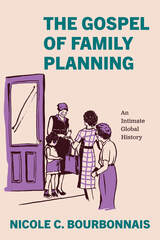 The Gospel of Family Planning: An Intimate Global History
Nicole C. Bourbonnais
University of Chicago Press, 2025 An engaging, insightful history of the family planning movement and its connection to broader social and political developments across the globe.
In the twentieth century, the idea that people should consciously plan (and limit) the size of their families became a global cause. Historical accounts of the global family planning movement have largely focused on the most prominent activists and those at the helm of international organizations, philanthropic foundations, and government programs. In The Gospel of Family Planning, however, historian Nicole C. Bourbonnais shifts our attention to frontline workers—doctors, social workers, nurses, fieldworkers, consultants, church groups, and volunteers—who, she compellingly shows, played a central (if complicated) role in preaching contraception around the world.
Through a mix of collective biography and microhistory, Bourbonnais visits clinics, doorsteps, and bedrooms, revealing the everyday, ground-level workings of grassroots family planning campaigns, state population control programs, and the movements for reproductive rights and justice that arose to contest them. Throughout the book, Bourbonnais invites readers to consider how the intertwined histories of missionary work, humanitarianism, feminism, decolonization, and international development shaped intimate interventions into people’s reproductive lives around the world.
 The Gospel of Germs: Men, Women, and the Microbe in American Life
Nancy Tomes
Harvard University Press, 1998 AIDS. Ebola. "Killer microbes." All around us the alarms are going off, warning of the danger of new, deadly diseases. And yet, as Nancy Tomes reminds us in her absorbing book, this is really nothing new. A remarkable work of medical and cultural history, The Gospel of Germs takes us back to the first great "germ panic" in American history, which peaked in the early 1900s, to explore the origins of our modern disease consciousness.
Little more than a hundred years ago, ordinary Americans had no idea that many deadly ailments were the work of microorganisms, let alone that their own behavior spread such diseases. The Gospel of Germs shows how the revolutionary findings of late nineteenth-century bacteriology made their way from the laboratory to the lavatory and kitchen, with public health reformers spreading the word and women taking up the battle on the domestic front. Drawing on a wealth of advice books, patent applications, advertisements, and oral histories, Tomes traces the new awareness of the microbe as it radiated outward from middle-class homes into the world of American business and crossed the lines of class, gender, ethnicity, and race.
Just as we take some of the weapons in this germ war for granted--fixtures as familiar as the white porcelain toilet, the window screen, the refrigerator, and the vacuum cleaner--so we rarely think of the drastic measures deployed against disease in the dangerous old days before antibiotics. But, as Tomes notes, many of the hygiene rules first popularized in those days remain the foundation of infectious disease control today. Her work offers a timely look into the history of our long-standing obsession with germs, its impact on twentieth-century culture and society, and its troubling new relevance to our own lives.
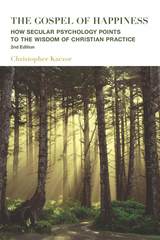 The Gospel of Happiness: How Secular Psychology Points to the Wisdom of Christian Practice
Christopher Kaczor
St. Augustine's Press, 2019 Just as Aristotelian metaphysics provided a new basis for the natural theology of Aquinas’s time, so too, positive psychology provides a basis for a natural moral theology in our own time. this book marshals the empirically verifiable findings of positive psychology that show the wisdom of the Christian tradition. Christian warnings about the dangers of greed, coveting a neighbor’s goods (social comparison), and pride find an empirical verification. Likewise, positive psychology vindicates the wisdom of Christian teaching on the importance of forgiveness, of gratitude, of humility, and of serving one’s neighbor. moreover, positive psychology also can be a service to Christian believers by helping them in their struggles with willpower, by providing new motivations for prayer, and by helping them identify their signature strengths. Finally, this book argues, in a variety of ways, that it is folly to think that even the best of psychology can serve as a replacement for Christianity.
 The Gospel of John Marrant: Conjuring Christianity in the Black Atlantic
Alphonso F. Saville IV
Duke University Press, 2024 The Reverend John Marrant (1755–91) was North America’s first Black ordained minister and one of America’s earliest Black authors and preachers. In The Gospel of John Marrant, Alphonso F. Saville IV examines how Protestantism and West African indigenous religious practices deeply informed his life and ministry. Saville follows Marrant from his time evangelizing the Cherokee in Georgia to meeting with Black Freemasons in Boston to engaging with diasporic communities along the Eastern Seaboard and in England. Using the Black folk magic tradition of conjure as a lens for understanding Marrant’s religious imagination, Saville outlines the importance of Africana religious and cultural themes, symbols, and cosmologies in the biblical interpretation and ritual culture of early Black North American Christian communities. Marrant’s life and work, Saville contends, reveal the diverse religious cultures that contributed to the formation of African American Christianity and its evolution into a prominent institution during the colonial and early history of the United States. In so doing, he demonstrates the need to recenter both religion and Africa in the study of African American cultural and intellectual history.
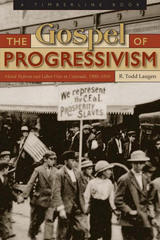 The Gospel of Progressivism: Moral Reform and Labor War in Colorado, 1900-1930
R. Todd Laugen
University Press of Colorado, 2010 Chronicling the negotiations of Progressive groups and the obstacles that constrained them, The Gospel of Progressivism details the fight against corporate and political corruption in Colorado during the early twentieth century. While the various groups differed in their specific agendas, Protestant reformers, labor organizers, activist women, and mediation experts struggled to defend the public against special-interest groups and their stranglehold on Colorado politics. Sharing enemies like the party boss and corporate lobbyist who undermined honest and responsive government, Progressive leaders were determined to root out selfish political action with public exposure. Labor unions defied bosses and rallied for government protection of workers. Women's clubs appealed to other women as mothers, calling for social welfare, economic justice, and government responsiveness. Protestant church congregations formed a core of support for moral reform. Labor relations experts struggled to prevent the outbreak of violence through mediation between corporate employers and organized labor. Persevering through World War I, Colorado reformers faced their greatest challenge in the 1920s, when leaders of the Ku Klux Klan drew upon the rhetoric of Protestant Progressives and manipulated reform tools to strengthen their own political machine. Once in power, Klan legislators turned on Progressive leaders in the state government. A story of promising alliances never fully realized, zealous crusaders who resisted compromise, and reforms with unexpected consequences, The Gospel of Progressivism will appeal to those interested in Progressive Era reform, Colorado history, labor relations, and women's activism.
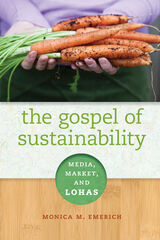 The Gospel of Sustainability: Media, Market and LOHAS
Monica M. Emerich
University of Illinois Press, 2014 From organic produce and clothing to socially conscious investing and eco-tourism, the lifestyles of health and sustainability, or LOHAS, movement encompasses diverse products and practices intended to contribute to a more sustainable lifestyle for people and the planet. In The Gospel of Sustainability, Monica M. Emerich explores the contemporary spiritual expression of this green cultural shift at the confluence of the media and the market. This is the first book to qualitatively study the LOHAS marketplace and the development of a discourse of sustainability of the self and the social and natural worlds. Emerich draws on myriad sources related to the notions of mindful consumption found throughout the LOHAS marketplace, including not just products and services but marketing materials, events, lectures, regulatory policies, and conversations with leaders and consumers. These disparate texts, she argues, universally project a spiritual message about personal and planetary health that is in turn reforming capitalism by making consumers more conscious.
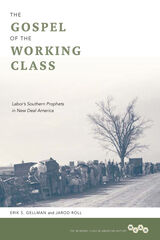 The Gospel of the Working Class: Labor's Southern Prophets in New Deal America
Erik S. Gellman and Jarod Roll
University of Illinois Press, 2011 In this exceptional dual biography and cultural history, Erik S. Gellman and Jarod Roll trace the influence of two southern activist preachers, one black and one white, who used their ministry to organize the working class in the 1930s and 1940s across lines of gender, race, and geography. Owen Whitfield and Claude Williams, along with their wives Zella Whitfield and Joyce Williams, drew on their bedrock religious beliefs to stir ordinary men and women to demand social and economic justice in the eras of the Great Depression, New Deal, and Second World War. Williams and Whitfield preached a working-class gospel rooted in the American creed that hard, productive work entitled people to a decent standard of living. Gellman and Roll detail how the two preachers galvanized thousands of farm and industrial workers for the Southern Tenant Farmers Union and the Congress of Industrial Organizations. They also link the activism of the 1930s and 1940s to that of the 1960s and emphasize the central role of the ministers' wives, with whom they established the People's Institute for Applied Religion. This detailed narrative illuminates a cast of characters who became the two couples' closest allies in coordinating a complex network of activists that transcended Jim Crow racial divisions, blurring conventional categories and boundaries to help black and white workers make better lives. In chronicling the shifting contexts of the actions of Whitfield and Williams, The Gospel of the Working Class situates Christian theology within the struggles of some of America's most downtrodden workers, transforming the dominant narratives of the era and offering a fresh view of the promise and instability of religion and civil rights unionism.
Gospels: Narrative and History
Mercedes Navarro Puerto
SBL Press, 2015 An international collection of ecumenical, gender-sensitive interpretations
In this volume of the Bible and Women Series, contributors examine how biblical studies intersects with feminist interpretive methods with regard to the Gospels. Authors examine the lives of women in Roman Palestine, named and unnamed women in the Gospels, and the role of gender in the reception of the Hebrew scriptures in the New Testament.
Features:
- Essays by scholars from scholars from around the world
- An introduction and twenty essays focused on women and gender relations
- Coverage of power relations and ideologies within the texts and in current interpretations
 Gossip & Metaphysics: Russian Modernist Poems & Prose
Edited by Katie Farris, Ilya Kaminsky, and Valzhyna Mort
Tupelo Press, 2014 There has been no anthology in English dedicated to the poetics of the great generation of Russian modernists. For a group of poets so widely admired, relatively little seems known about their philosophy of poetry and their poetic influences, and although there is tremendous aesthetic diversity in this group, they have more in common than many readers assume. Russian poetry was a small world, made even smaller by the arrests, disappearances, pogroms, famines, assassinations, and political conflagration of the revolutionary era, and literary differences were often overcome by a mutual sense of historic cataclysm. This anthology’s structure is like textile, with many common threads intertwining, doubling back, sometimes unraveling—creating a matrix of poetic conversation: Mayakovsky on Khlebnikov, Pasternak on Mayakovsky, Tsvetaeva on Pasternak, Brodsky on Tsvetaeva, Akhmatova on Mandelstam. Shared themes range from expected (the word) to serendipitous (the ocean). Above all these poets are obsessed with proximity—to God, to nature and place, to poetic predecessors, to language (their own and others), and always, forever, to the inexpressible.
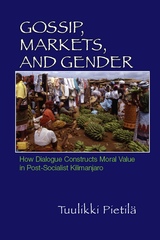 Gossip, Markets, and Gender: How Dialogue Constructs Moral Value in Post-Socialist Kilimanjaro
Tuulikki Pietilä
University of Wisconsin Press, 2007 "All traders are thieves, especially women traders," people often assured social anthropologist Tuulikki Pietilä during her field work in Kilimanjaro, Tanzania, in the mid-1990s. Equally common were stories about businessmen who had "bought a spirit" for their enrichment. Pietilä places these and similar comments in the context of the liberalization of the Tanzanian economy that began in the 1980s, when many men and women found themselves newly enmeshed in the burgeoning market economy. Even as emerging private markets strengthened the position of enterprising people, economic resources did not automatically lead to heightened social position. Instead, social recognition remained tied to a complex cultural negotiation through stories and gossip in markets, bars, and neighborhoods.
With its rich ethnographic detail, Gossip, Markets, and Gender shows how gossip and the responses to it form an ongoing dialogue through which the moral reputations of trading women and businessmen, and cultural ideas about moral value and gender, are constructed and rethought. By combining a sociolinguistic study of talk, storytelling, and conversation with analysis of gender, the political economy of trading, and the moral economy of personhood, Pietilä reveals a new perspective on the globalization of the market economy and its meaning and impact on the local level. Winner, Aidoo-Snyder Prize, African Studies Association Women’s Caucus
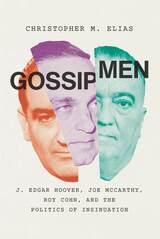 Gossip Men: J. Edgar Hoover, Joe McCarthy, Roy Cohn, and the Politics of Insinuation
Christopher M. Elias
University of Chicago Press, 2021 J. Edgar Hoover, Joseph McCarthy, and Roy Cohn were titanic figures in midcentury America, wielding national power in government and the legal system through intimidation and insinuation. Hoover’s FBI thrived on secrecy, threats, and illegal surveillance, while McCarthy and Cohn will forever be associated with the infamous anticommunist smear campaign of the early 1950s, which culminated in McCarthy’s public disgrace during televised Senate hearings. In Gossip Men, Christopher M. Elias takes a probing look at these tarnished figures to reveal a host of startling new connections among gender, sexuality, and national security in twentieth-century American politics. Elias illustrates how these three men solidified their power through the skillful use of deliberately misleading techniques like implication, hyperbole, and photographic manipulation. Just as provocatively, he shows that the American people of the 1950s were particularly primed to accept these coded threats because they were already familiar with such tactics from widely popular gossip magazines.
By using gossip as a lens to examine profound issues of state security and institutional power, Elias thoroughly transforms our understanding of the development of modern American political culture.
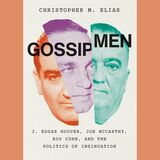 Gossip Men: J. Edgar Hoover, Joe McCarthy, Roy Cohn, and the Politics of Insinuation
Christopher M. Elias
University of Chicago Press, 2021 This is an auto-narrated audiobook edition of this book. J. Edgar Hoover, Joseph McCarthy, and Roy Cohn were titanic figures in midcentury America, wielding national power in government and the legal system through intimidation and insinuation. Hoover’s FBI thrived on secrecy, threats, and illegal surveillance, while McCarthy and Cohn will forever be associated with the infamous anticommunist smear campaign of the early 1950s, which culminated in McCarthy’s public disgrace during televised Senate hearings. In Gossip Men, Christopher M. Elias takes a probing look at these tarnished figures to reveal a host of startling new connections among gender, sexuality, and national security in twentieth-century American politics. Elias illustrates how these three men solidified their power through the skillful use of deliberately misleading techniques like implication, hyperbole, and photographic manipulation. Just as provocatively, he shows that the American people of the 1950s were particularly primed to accept these coded threats because they were already familiar with such tactics from widely popular gossip magazines.
By using gossip as a lens to examine profound issues of state security and institutional power, Elias thoroughly transforms our understanding of the development of modern American political culture.
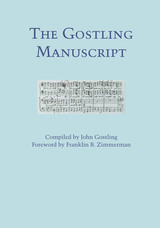 The Gostling Manuscript
Compiled by John Gostling
University of Texas Press, 1977 The rare and beautiful Gostling Manuscript is a primary source for the anthems of Henry Purcell and other major composers of the English Restoration period. Listed as missing since its sale to an anonymous buyer in 1935, the manuscript was eventually discovered in the Humanities Research Center at the University of Texas at Austin. This facsimile edition of the Gostling Manuscript (sometimes referred to by scholars as the "W. Kennedy Gostling Manuscript") made the document available to a wide audience for the first time in its history.
The anthems in this volume were assembled by the Reverend John Gostling, a celebrated bass soloist and an assiduous collector of the contemporary music of his day. His musical taste and editorial judgment, not to mention his skill as a copyist, were excellent. The Gostling Manuscript, completed around 1706, is considered essential for collating and editing some of the best anthems of the period. These sixty-four pieces, fair-copied in full score, include seventeen by Purcell; twenty-four by John Blow; four each by William Turner, Pelham Humfrey, and Jeremiah Clark; three each by Matthew Locke and Thomas Tudway; one by both William Child and Francis Pigott; and three arrangements by Henry Aldrich of anthems by Carissimi, Byrd, and Wise.
Gostling appended inscriptions to many of the pieces, giving the date and circumstances of composition, notes of considerable value to the musical historian. This folio-size facsimile edition will serve not only as an invaluable anthology but also as a unique and singularly helpful source of information about English musical life in the late seventeenth and early eighteenth centuries.
The foreword by Franklin B. Zimmerman provides a brief history of the Gostling Manuscript.
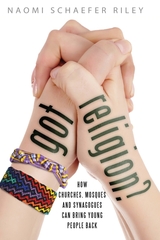 Got Religion?: How Churches, Mosques, and Synagogues Can Bring Young People Back
Naomi Schaefer Riley
Templeton Press, 2014 Why are young people dropping out of religious institutions? Can anything be done to reverse the trend? In Got Religion?, Naomi Schaefer Riley examines the reasons for the defection, why we should care, and how some communities are successfully addressing the problem.
The traditional markers of growing up are getting married and becoming financially independent. But young adults are delaying these milestones, sometimes for a full decade longer than their parents and grandparents. This new phase of “emerging adulthood” is diminishing the involvement of young people in religious institutions, sapping the strength and vitality of faith communities, and creating a more barren religious landscape for the young adults who do eventually decide to return to it. Yet, clearly there are some churches, synagogues, and mosques that are making strides in bringing young people back to religion.
Got Religion? offers in-depth, on-the-ground reporting about the most successful of these institutions and shows how many of the structural solutions for one religious group can be adapted to work for another.
The faith communities young people attach themselves to are not necessarily the biggest or the most flashy. They are not the wealthiest or the ones employing the latest technology. Rather, they are the ones that create stability for young people, that give them real responsibility in a community and that help them form the habits of believers that will last a lifetime.
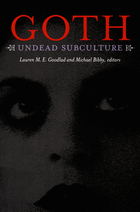 Goth: Undead Subculture
Lauren M. E. Goodlad and Michael Bibby, eds.
Duke University Press, 2007 Since it first emerged from Britain’s punk-rock scene in the late 1970s, goth subculture has haunted postmodern culture and society, reinventing itself inside and against the mainstream. Goth: Undead Subculture is the first collection of scholarly essays devoted to this enduring yet little examined cultural phenomenon. Twenty-three essays from various disciplines explore the music, cinema, television, fashion, literature, aesthetics, and fandoms associated with the subculture. They examine goth’s many dimensions—including its melancholy, androgyny, spirituality, and perversity—and take readers inside locations in Los Angeles, Austin, Leeds, London, Buffalo, New York City, and Sydney. A number of the contributors are or have been participants in the subculture, and several draw on their own experiences. The volume’s editors provide a rich history of goth, describing its play of resistance and consumerism; its impact on class, race, and gender; and its distinctive features as an “undead” subculture in light of post-subculture studies and other critical approaches. The essays include an interview with the distinguished fashion historian Valerie Steele; analyses of novels by Anne Rice, Poppy Z. Brite, and Nick Cave; discussions of goths on the Internet; and readings of iconic goth texts from Bram Stoker’s Dracula to James O’Barr’s graphic novel The Crow. Other essays focus on gothic music, including seminal precursors such as Joy Division and David Bowie, and goth-influenced performers such as the Cure, Nine Inch Nails, and Marilyn Manson. Gothic sexuality is explored in multiple ways, the subjects ranging from the San Francisco queercore scene of the 1980s to the increasing influence of fetishism and fetish play. Together these essays demonstrate that while its participants are often middle-class suburbanites, goth blurs normalizing boundaries even as it appears as an everlasting shadow of late capitalism. Contributors: Heather Arnet, Michael Bibby, Jessica Burstein, Angel M. Butts, Michael du Plessis, Jason Friedman, Nancy Gagnier, Ken Gelder, Lauren M. E. Goodlad, Joshua Gunn, Trevor Holmes, Paul Hodkinson, David Lenson, Robert Markley, Mark Nowak, Anna Powell, Kristen Schilt, Rebecca Schraffenberger, David Shumway, Carol Siegel, Catherine Spooner, Lauren Stasiak, Jeffrey Andrew Weinstock
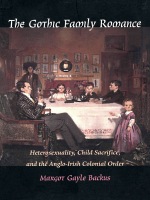 The Gothic Family Romance: Heterosexuality, Child Sacrifice, and the Anglo-Irish Colonial Order
Margot Gayle Backus
Duke University Press, 1999 Tales of child sacrifice, demon lovers, incestual relations, and returns from the dead are part of English and Irish gothic literature. Such recurring tropes are examined in this pioneering study by Margot Gayle Backus to show how Anglo-Irish gothic works written from the eighteenth through the twentieth centuries reflect the destructive effects of imperialism on the children and later descendents of Protestant English settlers in Ireland.
Backus uses contemporary theory, including that of Michel Foucault and Eve Kosofsky Sedgwick, to analyze texts by authors ranging from Richardson, Swift, Burke, Edgeworth, Stoker, and Wilde to contemporary Irish novelists and playwrights.
By charting the changing relations between the family and the British state, she shows how these authors dramatized a legacy of violence within the family cell and discusses how disturbing themes of child sacrifice and colonial repression are portrayed through irony, satire, “paranoid” fantasy, and gothic romance. In a reconceptualization of the Freudian family romance, Backus argues that the figures of the Anglo-Irish gothic embody the particular residue of childhood experiences within a settler colonial society in which biological reproduction represented an economic and political imperative.
Backus’s bold positioning of the nuclear family at the center of post-Enlightenment class and colonial power relations in England and Ireland will challenge and provoke scholars in the fields of Irish literature and British and postcolonial studies. The book will also interest students and scholars of women’s studies, and it has important implications for understanding contemporary conflicts in Ireland.
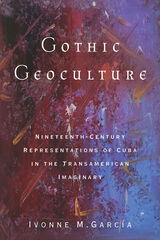 Gothic Geoculture: Nineteenth-Century Representations of Cuba in the Transamerican Imaginary
Ivonne M. García
Ohio State University Press, 2019 In the nineteenth century, the island of Cuba was a popular site for US travelers, who wrote dozens of travelogues about their experiences. At the same time, Cuban exiles living in the United States, escaping from Spanish colonial repression, wrote about their island and about their US experiences. Within the trove of writings about Cuba in relation to slavery and a rising US empire in the region, Ivonne M. García’s Gothic Geoculture: Nineteenth-Century Representations of Cuba in the Transamerican Imaginary shows how a group of writers, on both sides, used the language of fear to construct gothicizations of the island (and of the United States) through tropes of corruption, doubleness, and monstrosity. García coins the term “gothic geoculture” to show Cuba’s identity in the nineteenth century as existing at the crossroads between colonialism, slavery, and transamericanity. Specifically looking at a period of colonial anxiety between 1830 and 1890, García exposes the ways some writers code Cuba as dangerous and destructive, demonstrating how these transamerican figurations created a series of uncanny simultaneities that expand on and complicate the ways we understand how Cuba and the hemisphere were imagined at that time.
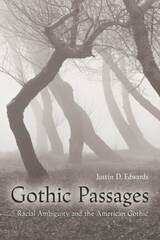 Gothic Passages: Racial Ambiguity and the American Gothic
Justin D. Edwards
University of Iowa Press, 2003 This groundbreaking study analyzes the development of American gothic literature alongside nineteenth-century discourses of passing and racial ambiguity. By bringing together these areas of analysis, Justin Edwards considers the following questions. How are the categories of “race” and the rhetoric of racial difference tied to the language of gothicism? What can these discursive ties tell us about a range of social boundaries—gender, sexuality, class, race, etc.—during the nineteenth century? What can the construction and destabilization of these social boundaries tell us about the development of the U.S. gothic? The sources used to address these questions are diverse, often literary and historical, fluidly moving between “representation” and “reality.” Works of gothic literature by Edgar Allan Poe, Herman Melville, Frances Harper, and Charles Chesnutt, among others, are placed in the contexts of nineteenth-century racial “science” and contemporary discourses about the formation of identity. Edwards then examines how nineteenth-century writers gothicized biracial and passing figures in order to frame them within the rubric of a “demonization of difference.” By charting such depictions in literature and popular science, he focuses on an obsession in antebellum and postbellum America over the threat of collapsing racial identities—threats that resonated strongly with fears of the transgression of the boundaries of sexuality and the social anxiety concerning the instabilities of gender, class, ethnicity, and nationality. Gothic Passages not only builds upon the work of Americanists who uncover an underlying racial element in U.S. gothic literature but also sheds new light on the pervasiveness of gothic discourse in nineteenth-century representations of passing from both sides of the color line. This fascinating book will be of interest to scholars of American literature, cultural studies, and African American studies.
 Gothic Pride: The Story of Building a Great Cathedral in Newark
Regan, Brian
Rutgers University Press, 2012 Newark’s Cathedral Basilica of the Sacred Heart is one of the United States’ greatest cathedrals and most exceptional Gothic Revival buildings. Rising from Newark’s highest ground and visible for miles, it spectacularly evokes its historic models. Gothic Pride sets Sacred Heart in the context of American cathedral building and, blending diverse fields, accounts for the complex circumstances that produced it. Calling upon a wealth of primary sources, Brian Regan describes in a compelling narrative the cathedral’s almost century-long history. He traces the project to its origins in the late 1850s and the great expectations held by the project’s prime movers—all passionate about Gothic architecture and immensely proud of Newark—that never wavered despite numerous setbacks and challenges. Construction did not begin until 1898 and, when completed in 1954, the cathedral became New Jersey’s largest church—and the most expensive Catholic church ever built in America. During Pope John Paul II’s visit to the United States in 1995, he celebrated evening prayer at the Cathedral. On that occasion, the Cathedral of the Sacred Heart was elevated to a basilica to become the Cathedral Basilica of the Sacred Heart. Meticulously researched, Gothic Pride brings to life the people who built, contributed to, and worshipped in Sacred Heart, recalling such remarkable personalities as George Hobart Doane, Jeremiah O’Rourke, Gonippo Raggi, and Archbishop Thomas Walsh. In many ways, the cathedral’s story is a lens that lets us look at the history of Newark itself—its rise as an industrial city and its urban culture in the nineteenth century; its transformation in the twentieth century; its immigrants and the profound effects of their cultures, especially their religion, on American life; and the power of architecture to serve as a symbol of community values and pride..
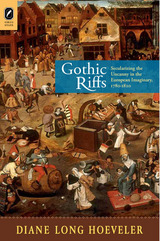 Gothic Riffs: Secularizing the Uncanny in the European Imaginary, 1780–1820
Diane Long Hoeveler
Ohio State University Press, 2010 Gothic Riffs: Secularizing the Uncanny in the European Imaginary, 1780–1820 by Diane Long Hoeveler provides the first comprehensive study of what are called “collateral gothic” genres—operas, ballads, chapbooks, dramas, and melodramas—that emerged out of the gothic novel tradition founded by Horace Walpole, Matthew Lewis, and Ann Radcliffe. The role of religion and its more popular manifestations, superstition and magic, in the daily lives of Western Europeans were effectively undercut by the forces of secularization that were gaining momentum on every front, particularly by 1800. It is clear, however, that the lower class and the emerging bourgeoisie were loath to discard their traditional beliefs. We can see their search for a sense of transcendent order and spiritual meaning in the continuing popularity of gothic performances that demonstrate that there was more than a residue of a religious calendar still operating in the public performative realm. Because this bourgeois culture could not turn away from God, it chose to be haunted, in its literature and drama, by God’s uncanny avatars: priests, corrupt monks, incestuous fathers and uncles. The gothic aesthetic emerged during this period as an ideologically contradictory and complex discourse system; a secularizing of the uncanny; a way of alternately valorizing and at the same time slandering the realms of the supernatural, the sacred, the maternal, and the primitive.
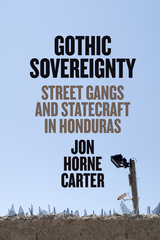 Gothic Sovereignty: Street Gangs and Statecraft in Honduras
Jon Horne Carter
University of Texas Press, 2022 Gang-related violence has forced thousands of Hondurans to flee their country, leaving behind everything as refugees and undocumented migrants abroad. To uncover how this happened, Jon Carter looks back to the mid-2000s, when neighborhood gangs were scrambling to survive state violence and mass incarceration, locating there a critique of neoliberal globalization and state corruption that foreshadows Honduras’s current crises. Carter begins with the story of a thirteen-year-old gang member accused in the murder of an undercover DEA agent, asking how the nation’s seductive criminal underworld has transformed the lives of young people. He then widens the lens to describe a history of imperialism and corruption that shaped this underworld—from Cold War counterinsurgency to the “War on Drugs” to the near-impunity of white-collar crime—as he follows local gangs who embrace new trades in the illicit economy. Carter describes the gangs’ transformation from neighborhood groups to sprawling criminal societies, even in the National Penitentiary, where they have become political as much as criminal communities. Gothic Sovereignty reveals not only how the revolutionary potential of gangs was lost when they merged with powerful cartels but also how close analysis of criminal communities enables profound reflection on the economic, legal, and existential discontents of globalization in late liberal nation-states.
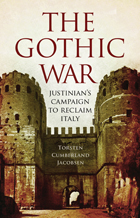 The Gothic War: Justinian's Campaign to Reclaim Italy
Torsten Cumberland Jacobsen
Westholme Publishing, 2009 The War that Reshaped the Political Future of Europe
“Jacobsen brings to the story an intimate knowledge of Italy. The battles took place on terrain Jacobsen knows well. . . Recommended.”—Choice
“Jacobsen provides an operational history of Justinian’s campaign. Throughout he traces the military strategies and tactical intrigues of leaders such as the Roman general Belisarius and the Goth leader Totila.”—Publishers Weekly
“Jacobsen knows the sites he writes about, he has read Procopius diligently . . . and his military reconstruction can be faulted only in attributing to both sides rather better command and control than the ancient armies could generally manage. . . . Jacobsen has offered wargamers a tool they will appreciate.”—The Classical Review
A period of stability in the early sixth century A.D. gave the Eastern Roman emperor Justinian an opportunity to recapture parts of the Western Empire which had been lost to invading barbarians in the preceding centuries. The climactic conflict over Italy between 535 and 554—the Gothic War—decided the political future of Europe, holding in its balance the possibility that the Roman Empire might rise again. While large portions of the original territory of the ancient Roman Empire were recaptured, the Eastern Empire was incapable of retaining much of its hard-won advances, and soon the empire once again retracted. As a result of the Gothic War, Italy was invaded by the Lombards who began their important kingdom, the Franks began transforming Gaul into France, and without any major force remaining in North Africa, that territory was quickly overrun by the first wave of Muslim expansion in the ensuing century. Written as a general overview of this critical period, The Gothic War: Justinian’s Campaign to Reclaim Italy opens with a history of the conflict with Persia and the great Roman general Belisarius’s successful conquest of the Vandals in North Africa. After an account of the Ostrogothic tribe and their history, the campaigns of the long war for Italy are described in detail, including the three sieges of Rome, which turned the great city from a bustling metropolis into a desolate ruin. In addition to Belisarius, the Gothic War featured many of history’s most colorful antagonists, including Rome’s Narses the Eunuch, and the Goths’ ruthless and brilliant tactician, Totila. Two appendices provide information about the armies of the Romans and Ostrogoths, including their organization, weapons, and tactics, all of which changed over the course of the war.
The Gothic World of Anne Rice
Edited by Gary Hoppenstand and Ray B. Browne
University of Wisconsin Press, 1996 This anthology argues for the serious study of the literary oeuvre of Anne Rice, a major figure in today’s popular literature. The essays assert that Rice expands the conventions of the horror genre’s formula to examine important social issues. Like a handful of authors working in this genre, Rice manipulates its otherwise predictable narrative structures so that a larger, more interesting cultural mythology can be developed. Rice searches for philosophical truth, examining themes of good and evil, the influence on people and society of both nature and nurture, and the conflict and dependence of humanism and science.
The Gothic World of Stephen King: Landscape of Nightmares
Edited by Gary Hoppenstand and Ray B. Browne
University of Wisconsin Press, 1987 Stephen King’s popularity lies in his ability to reinterpret the standard Gothic tale in new and exciting ways. Through his eyes, the conventional becomes unconventional and wonderful. King thus creates his own Gothic world and then interprets it for us. This book analyzes King’s interpretations and his mastery of popular literature. The essays discuss adolescent revolt, the artist as survivor, the vampire in popular literature, and much more.
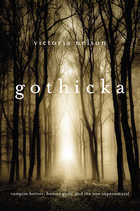 Gothicka: Vampire Heroes, Human Gods, and the New Supernatural
Victoria Nelson
Harvard University Press, 2012 The Gothic, Romanticism's gritty older sibling, has flourished in myriad permutations since the eighteenth century. In Gothicka, Victoria Nelson identifies the revolutionary turn it has taken in the twenty-first. Today's Gothic has fashioned its monsters into heroes and its devils into angels. It is actively reviving supernaturalism in popular culture, not as an evil dimension divorced from ordinary human existence but as part of our daily lives.
To explain this millennial shift away from the traditionally dark Protestant post-Enlightenment Gothic, Nelson studies the complex arena of contemporary Gothic subgenres that take the form of novels, films, and graphic novels. She considers the work of Dan Brown and Stephenie Meyer, graphic novelists Mike Mignola and Garth Ennis, Christian writer William P. Young (author of The Shack), and filmmaker Guillermo del Toro. She considers twentieth-century Gothic masters H. P. Lovecraft, Anne Rice, and Stephen King in light of both their immediate ancestors in the eighteenth century and the original Gothic-the late medieval period from which Horace Walpole and his successors drew their inspiration.
Fictions such as the Twilight and Left Behind series do more than follow the conventions of the classic Gothic novel. They are radically reviving and reinventing the transcendental worldview that informed the West's premodern era. As Jesus becomes mortal in The Da Vinci Code and the child Ofelia becomes a goddess in Pan's Labyrinth, Nelson argues that this unprecedented mainstreaming of a spiritually driven supernaturalism is a harbinger of what a post-Christian religion in America might look like.
 The Gough Map: The Earliest Road Map of Great Britain
Nick Millea
Bodleian Library Publishing, 2005 For centuries the Gough Map has amazed observers with its remarkable detail and baffled historians with its hidden secrets: who made it and why was it made? This gorgeously illustrated volume offers possible answers to these questions with a detailed examination of the map that employs the latest in technology, cartographic theories, and historical research.
Recent digitization of the Gough Map has made it more legible than at any other time since its arrival at the Bodleian Library in 1809. This work utilizes new georectification technology to project a modern map of Britain over the Gough Map, revealing the incredible accuracy of the 700-year-old manuscript. In stunningly detailed reproduction, The Gough Map charts a vast array of cities, routes, and landmarks, including the principal medieval settlements of Bristol, Oxford and Norwich; the Severn, Thames, and Humber rivers; the loop of the Wear at Durham; and routes between towns with distances marked in Roman numerals.
The volume also features a color fold-out print of the Gough map, as well as numerous close-up images of each area. The Gough Map offers an unparalleled opportunity to examine this fascinating example of medieval mapmaking.
|
|
